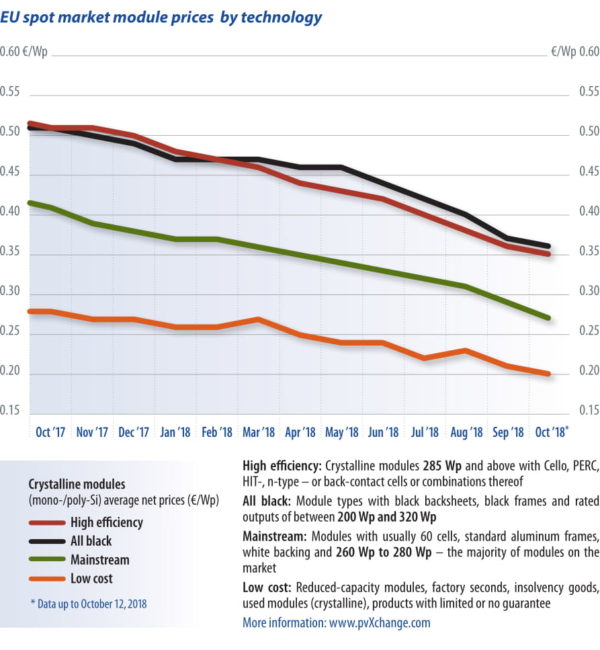May 2019: Fridays forever
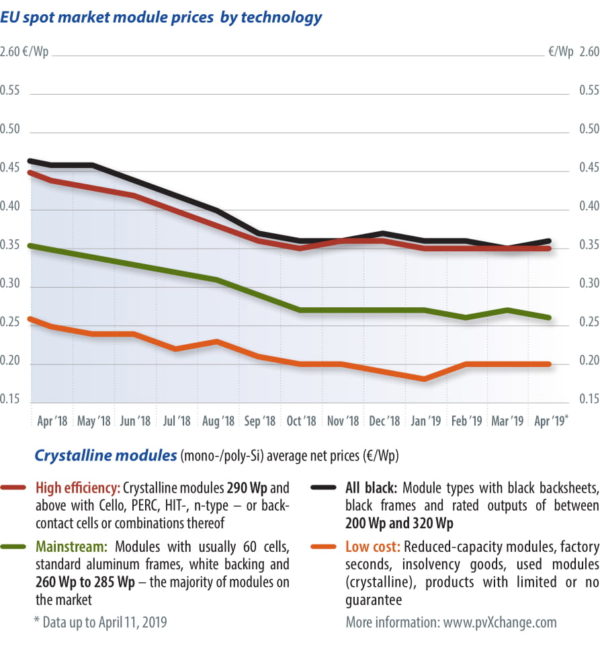
Since the last reduction in the German feed-in tariff for medium-sized PV systems at the beginning of April, not much has changed in terms of module prices. This is down to unchanged demand in the country – at least in the first days of April. What is more, any local lags in the market are outweighed by steadily rising demand throughout Europe.
Schoolchildren and students all over the world have been taking to the streets on Fridays to protest the inaction of their parents’ and grandparents’ generations. Young people no longer want to accept the frivolous endangerment of their livelihoods on this planet. Facts about the causes and effects of the ongoing destruction of the environment have been known for decades, but beyond high-minded declarations no one has taken decisive action. Carbon emissions and the resulting rise in atmospheric temperatures, the littering of the world’s oceans, the extinction of species – it all continues unabated.
Fridays for Future
What Greta Thunberg began with her “Skolstrejk För Klimatet” in August 2018, which the global public then became aware of after her impressive speech at COP24 in December, has now grown into a massive global movement, which operates under the name “Fridays For Future (FFF).” Even Barack Obama recently praised the young people’s commitment during a visit to Berlin, albeit with a typical appeal to moderation: “When I was a young activist, I always wanted one hundred percent success,” but, he continued, it turned out that this was not possible, and that compromise was the main thing in a democratic and open society.
This may be the right approach, but if the compromise is to be anything other than lazy or minimal, negotiations have to start with radical or outrageous demands. So-called ‘realistic’ demands of one side in combination with egoistic or even inflated demands on the other invariably lead to results with which the other side can often live very comfortably, since in the end it hardly has to make any concessions.
Package of measures
This is the students’ reaction to criticism that their protests lack substance as long as they fail to formulate demands or solutions. A package of measures is now on the table. The starting point is to limit global warming to 1.5 degrees, now a broad consensus. From this, the students deduce that Germany must bring its CO2 emissions to net zero by 2035 and completely shift its energy supply to renewables. The coal phase-out should be completed by 2030. A quarter of the country’s power plants would have to be taken offline this year. In addition, the activists demand all subsidies for fossil fuels be abolished by the end of the year, and all greenhouse gas emissions be taxed at €180 per metric ton.
Of course, there was a prompt outcry from both conservative and liberal parties as well as industry associations. The demands were called unrealistic, there were still no viable alternatives, and Germany’s status as a business location would be endangered – the same old story. But Germany’s future is in danger anyway, if ruling parties and major corporations do not change course, making a rapid switch to low-emission power generation, e-mobility, and other forward-looking technologies in the age of digitalization. Instead, they stir up fear of the economic supremacy of China, a country already more advanced in all these areas and presumably striving for world domination.
In this respect, it is a good thing if we push for more ambitious steps, a whole generation goes on strike until something moves forward. The easy road and conformity were yesterday. The young generation seems to understand that prosperity at the expense of one’s own future is not a real option, and certainly not a desirable one. What conclusions can we “old folks” draw from this?
Well, why not support the protests and put our full weight behind them! Let’s motivate our children and young family members who have not yet become active to join the FFF movement. We can also offer more solutions in the form of new, interesting, and forward-looking business models, products, and approaches.
Greta will certainly not end her school strike yet. A premature abandonment would mean surrender to the incompetence of their parents’ generation and a betrayal of their own future.
Most who have done little or nothing about climate change to date will not experience the most drastic consequences themselves. There is little incentive in our egomaniacal and narcissistic society to move out of our much-loved comfort zone. Our children, however, will suffer terribly, one day wondering if what they learned in school or vocational training will help them to develop adequate survival strategies. Protests are generally still peaceful, but could soon become more radical to attract greater attention and put even more pressure on the public, business, and politicians. School’s out on Friday! Is school out forever?
Martin Schachinger, pvXchange.com
April 2019: Clash of the titans
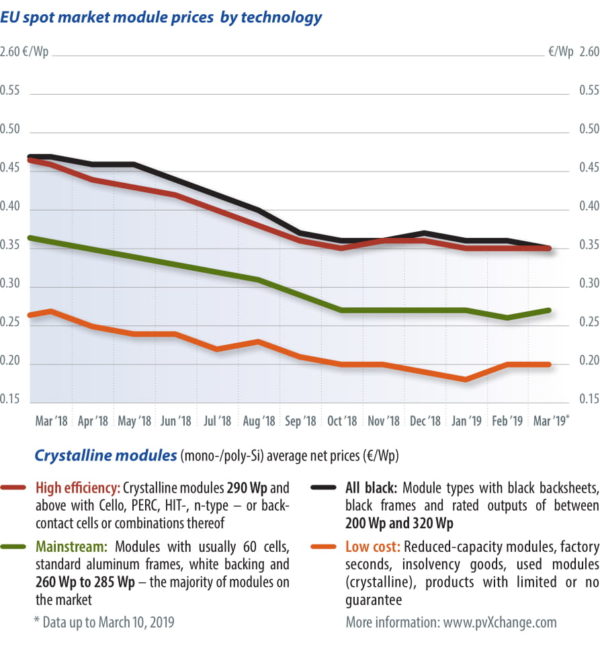
The current market situation, at least for Central Europe, can be summarized as follows: same old story. The price level has neither changed over the past month nor has the general availability of the different module types improved – on the contrary.
Whereas last month it was still possible to order relatively reliable multicrystalline modules for short-term delivery from many suppliers, as early as the beginning of March, even for ‘mainstream’ modules, buyers were put off until April, May, or even June. This is unfortunate for those in Germany who have to connect to the grid by the end of the month to qualify for the current FIT. Starting in April, rooftop systems between 40 and 750 kW covered by the German EEG will be remunerated at just €0.089/kWh – not, as previously threatened, the same rate as ground-mounted systems, but not much higher.
Since there is not much to report on the price front at the moment that I have not already covered previously, I want to turn my attention to the manufacturers themselves and their strategies. In view of the filing of patent lawsuits by Hanwha Q Cells against three of its competitors – not only has it become the center of attention, but also JinkoSolar and Longi Solar have found themselves in the spotlight. REC Group is also known to be involved in the dispute, but I will only refer here to the three companies with production capacities beyond 7 GW, all of which aspire to or are trying to defend market dominance – a clash of titans.
The manufacturers under attack report, however, that they have only heard about this lawsuit through the press. Apparently, none of the defendants had received any mail from the courts as of mid-March. Nevertheless, more or less detailed position statements by the companies are already circulating. Of course, the question arises as to why this dispute is being made public at such an early stage of the dispute. Is this a calculated step or just an embarrassing misstep? What does Hanwha Q Cells expect to gain from this frontal attack on some of its biggest competitors, especially in a lawsuit with an uncertain outcome that could drag on for years? Hanwha Q Cells seems quite confident that it was a pioneer in PERC technology with its Q.antum cell introduced some four years ago and that rivals have merely copied it. The latter reject the accusation, insisting that they concurrently developed this technology themselves and are permitted to use it lawfully.
Aggressive strategy
Whether Q Cells has the resources to survive the dispute to the end is questionable. It is possible that parent company Hanwha, which is worth billions, will have its subsidiary’s back. Products already on the market from JinkoSolar, Longi Solar, and REC are unlikely to be banned under any circumstances – users of these products can breathe easy for now.
Q Cells, the former European industry leader, has been forced to play catch-up with a huge amount of market share since its collapse and insolvency in 2012, shares that have since been lost to the competition. It has already been quite successful, however, thanks to an aggressive product and pricing policy and, not least, the financial opportunities offered by the involvement of Hanwha Group. At least in Germany, Q Cells is already the market leader again with a share of nearly 30%. But at the European level the situation is no longer as clear. JinkoSolar in particular is making inroads into the market. The group has been leading the BloombergNEF list of the largest and financially strongest cell and module manufacturers for a good year now, and it intends to maintain its position in the global market. There is also the newcomer Longi Solar, which, thanks to its consistent growth strategy, has made it into the top 10 producers by capacity within a very short time. So, is it a coincidence that these two companies are among the defendants?
Has Hanwha Q Cells perhaps overreached in the cutthroat competition? Has the group grown too fast, hired too many staff, and accepted too high development and production costs at a time when module prices started their nosedive last year, and thus developed an acute profitability problem? Acerbic voices mutter that the company would be better served putting its own house in order and learning to deliver reliably before entangling itself in protracted legal disputes. Well, perhaps that is precisely the key to finding a way out of the downward price spiral; namely, to have the competition indirectly bear the cost of the development and launch of patented products on the market.
This could be a dead end, however, given the length and complexity of this type of litigation. The current respite in the steady decline of module prices could soon be over. When that happens, other survival strategies will be needed apart from lashing out in all directions. How about high-quality, inexpensive, and, above all, readily available products?
Martin Schachinger, pvXchange.com
March 2019: Groundhog Day…
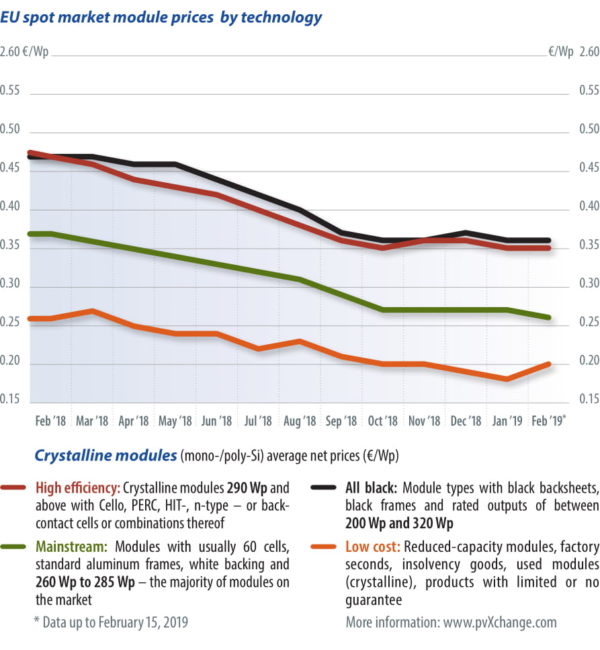
Numerous indicators point to an impending sharp decline in PV installations, at least in Germany, after March 31.
Availability is poor, prices have largely stagnated since the beginning of the year, and manufacturers have postponed or canceled promised deliveries from Asia. As a result of monthly reductions in feed-in tariffs, we are now seeing a full-fledged run on the few lots of modules still available on short notice. With each passing month, anxiety mounts over whether urgently needed components will be delivered on time. When deadlines are broken, installers face harsh contractual penalties, while system operators rack up major losses. Yet module producers seem to be taking all this in stride.
The eternal pork cycle: Initially, the PV market develops well, with installations almost reaching the level for a healthy industry. Then some institute or other detects overfunding, and drastic measures ensue. The market plunges into turmoil, and the scramble begins to snatch up the last affordable stocks. Resupply can be slow, and subsequent shipments are generally no longer at prices that make new installations viable. Since Europe is not the center of the PV world, manufacturers tend to wait and see how things shape up, preferring to focus on less volatile markets that promise better margins.
Once the pain is sufficiently high in Europe, and installers are prepared to pay inflated prices and forgo returns as the cost of doing business, deliveries resume. This, at least, is the apparent market strategy that some top manufacturers have adopted in the short term. Some module types will presumably not become available with any reliability until June or July, the claim being that factories are working at full capacity to fill pre-orders, according to information from Canadian Solar, JinkoSolar, JA Solar, and Suntech, among others. But modules manufactured up to that point will not all flow to Europe – quite the contrary. Deliveries are diverted or held back to serve preferred markets in Asia and the Americas. In this sense, the market over the next few months will look much as it did in mid-2017, late 2015, and early 2014 – that is, every 1.5 years or so, installation figures will drop off a cliff.
EEG in trouble?
In Germany, the guaranteed FIT in the mid-range system segment will be so low that if material and installation costs remain flat or rise, plants financed under the Renewable Energy Sources Act (EEG) will struggle to turn a profit. However, regulatory hurdles and contractual challenges for tenant power models or PPAs are too high even to attempt, especially for smaller players. Calls for abolition of the EEG are becoming increasingly loud. People are hoping for independence from political whims and what they see as wrong-headed decisions. The media celebrates the first ground-mounted systems that get by without any government-guaranteed funding, but are these utility-scale plants a blueprint for what awaits us in the post-EEG era? I’m afraid not. As far as the broad feasibility of such a concept is concerned, we are only at the beginning. These are important lighthouse projects, but their significance is already dubious.
Without the security of government funding, medium to large investments will no longer be viable. Banks will make a wide berth around any investment in PV where repayment will be secured solely by the creditworthiness of the customer, especially for commercial systems for which long-term use is not assured. So how might an alternative to today’s EEG look? Should the future belong to tenders? Karl-Heinz Remmers recently told me that he could imagine this if accompanied by further smart measures to support the market, but he does not expect anything substantial from policymakers on this issue, even in this legislative period.
We, the renewable energy specialists and stakeholders, should contribute as many intelligent ideas and concepts as possible to avoid a further sustained slump and hand yet another victory to those bent on delaying a rapid phase-out of coal and nuclear.
Martin Schachinger
pvXchange.com
February 2019: The snow keeps falling – module prices do not
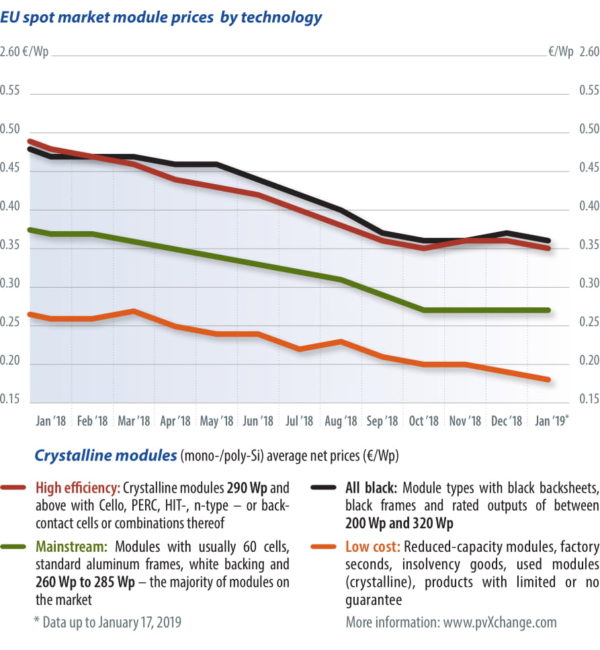
After a uniquely pleasant but dry summer and autumn, it has been raining and snowing in central Europe for weeks with no sign of letting up. Judging by sheer volume, the god of precipitation apparently wants to make up for his neglect of last year.
The weather of late has conjured memories of the catastrophic winter of 2006. PV plant owners are struggling to maintain the stability of their structures, not least because entering their facilities to clear the snow is nearly impossible in these weather conditions.
It is doubtful that thawing modules by reversing the flow of power in winter is a practical solution. Even if a slab of snow can be set in motion, it is unlikely to get past the edge of the roof or its snow guard system. It is also doubtful that this would make sense from an energy perspective. One approach might be a mechanical snow clearing device that could be used to clean modules in the summer. It is exciting to think about innovations we might be presented with in the future.
But what is the market doing now, and how are module prices trending at the start of the new year?
Slow start
For weather reasons, demand has been flat so far. In the Alpine regions, in view of the massive amounts of snow, it is likely that business is just beginning to ramp up. The rest of Europe is likely hobbled by sustained rainy weather, but that said, in parts of Germany installers seem to have started work already. There is also plenty of catching up to do on projects left idle between Christmas and New Year. The next big cut in feed-in tariffs for mid-sized PV plants is coming up, motivating operators to get their new installations connected to the grid.
Most modules delivered since the second week of January, however, were ordered last year. Those just now going shopping for components may be surprised to find empty warehouses and long delivery times – they will not be picking and choosing among brands and products, at any rate. There are still modules and inverters to be had from wholesalers, but almost all the big manufacturers are virtually sold out, and are consoling their customers with news that deliveries will resume in Q2 or even Q3. Supply is particularly bad for high-efficiency mono c-Si modules. In contrast, multi modules are still plentiful, at least on the spot market.
The current situation is not accurately reflected in module prices. While prices for the mostly multi mainstream modules have stagnated, they have actually dropped somewhat over the previous month for mono (high-efficiency and all black). This can be ascribed to the reduction in prices for products branded AUO-Benq, LG, and Panasonic, which until now have been much more expensive. These mark-downs have a greater effect on the average price of this module class than those of other brands. Unfortunately, customers never see much of these slight but visible discounts because in many cases there is no actual availability. Goods available on short notice may be subject to price movements in the opposite direction.
Pushing performance
One more gratifying development is that the general trend in performance classes continues to creep upward. The target at present can be considered to be 400 W. Manufacturers will be judged on which can achieve this first, with a workable product. I have taken this into account and raised the output threshold between the Mainstream and High-Efficiency module groups by 5 W to 290 W.
The trend towards stagnating prices with slight upward and downward fluctuations will be with us throughout Q1. As long as there are no big surprises from further political meddling, supplies should roughly balance with demand. Global demand will also climb at a moderate rate, as no boom is expected in China before the second half of the year. However, it is still uncertain how the German market will develop following the second quarter when the final stage of FIT reductions bite. I anticipate at least a temporary market collapse and associated oversupply, which could lead manufacturers and dealers to correct prices downward. Just when this materializes and to what extent remains to be seen.
Martin Schachinger
pvXchange.com
January 2019: The game goes on
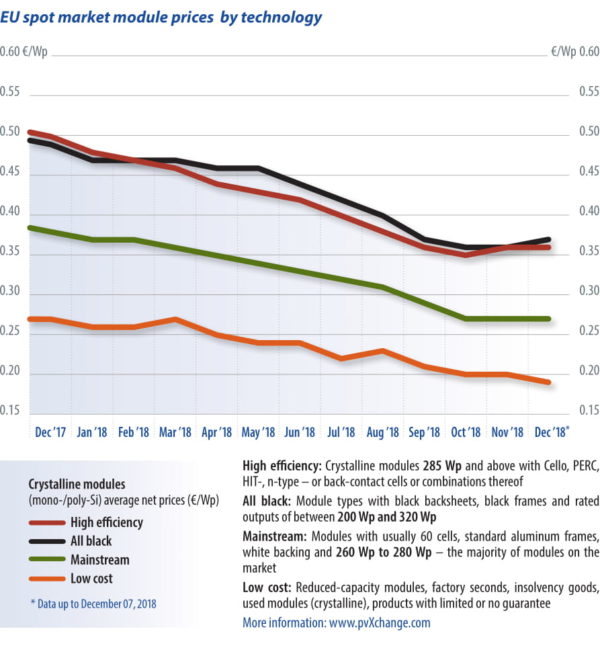
If you want to talk to manufacturers about module prices for 2019 – to submit a binding tender offer, perhaps – prepare to be disappointed. No one knows where the market is headed yet, which is why no one really wants to commit themselves – in other words, planning security is still tending towards zero.
Apparently, the German government's backing off from the short-term cuts to feed-in tariffs in the mid-sized plant segment is still not sufficient inducement for suppliers to ratchet up their capacities or delivery volumes. The deeper cuts to the EEG will now be introduced gradually in February, March and April 2019, rather than as a one-off bump in January. This has done little to calm the market, however.
The forecasts for markets such as Asia and South America also promise continued high global demand and local bottlenecks, with producers speculating on stagnating to slightly rising prices. By way of consolation, the major Asian manufacturers are promising their customers that they will adjust their cell and module prices after the Chinese New Year at the latest; that is, in February 2019.
A glance at 2018 shows that module prices were very dynamic. 2018 was marked by a sharp fall in prices, triggered on the one hand by the cuts in incentive programs in China announced in the middle of the year – which, incidentally, were not as dramatic as initially assumed – and on the other by the abolition of the minimum import price (MIP). After fully five years of market regulation, which the EU Commission believed would counteract price dumping by Chinese manufacturers – a claim substantiated by preliminary investigations – and save the domestic solar industry, the measures were removed in September 2018. Yet their success was modest – hardly any local manufacturer has managed to survive, and the market power of Chinese suppliers is still omnipresent.
The market found its bottom in early October: careening module prices abruptly stabilized. Demand in Europe generally rose after the summer break, which meant that the availability of certain module types threatened to tighten up once more.
The whole situation escalated with the sudden announcement by the German government that it intended to reduce the feed-in tariff for rooftop PV systems between 40 and 750 kWp by 20% to the level of ground-mounted systems as early as January 2019 – allegedly due to excessive subsidies. The resulting commotion in the market eased somewhat once the cuts were ultimately adopted in a more moderate form. Overall, in the fourth quarter Germany achieved very respectable installation figures for new plants, on par with one would actually always wish for, or need, to even come close to achieving the government's self-imposed climate targets.
What’s in store in 2019?
Many tier-1 products are currently either completely unavailable or no longer available in quantities sufficient to accommodate large-scale projects at short notice. The manufacturers in this space say they are sold out until March or April. Although single-digit megawatt volumes are still available on the spot market, customers do not have much choice when it comes to brand selection.
Everything now depends on future developments in regions such as Asia and South America. If demand there persists at a high level – for China an increase of 50 GW or more is already forecast for 2019 – cell and module prices will indeed stagnate in the long term. In Europe, growth is expected to be rather muted again, although some countries are setting ambitious targets for the coming years and announcing new tender models.
Unfortunately, we are still a long way from decoupling market growth from subsidies as long as the regulatory framework for straightforward plant construction under PPAs is still lacking. PV plants that do not require state subsidies or the EEG are still lighthouse projects. The installers of these systems are dependent on the continued fall in module prices, which have yet to materialize.
For 2019, I do not expect any further significant drop in prices, but I do not expect prices to rise either. In the coming months, multicrystalline cells will gradually be replaced by mono-PERC and other highly efficient technologies, leading to some potential savings in the substructure and assembly costs. A revival of thin-film modules is still to come. Nevertheless, there are still far more manufacturers and production capacities beyond First Solar than one might want to believe on the face of it. In the building integration sector in particular, some interesting products are likely to be presented in the near future – so, there is plenty to get excited about!
Martin Schachinger
pvXchange.com
December 2018: Zero planning security
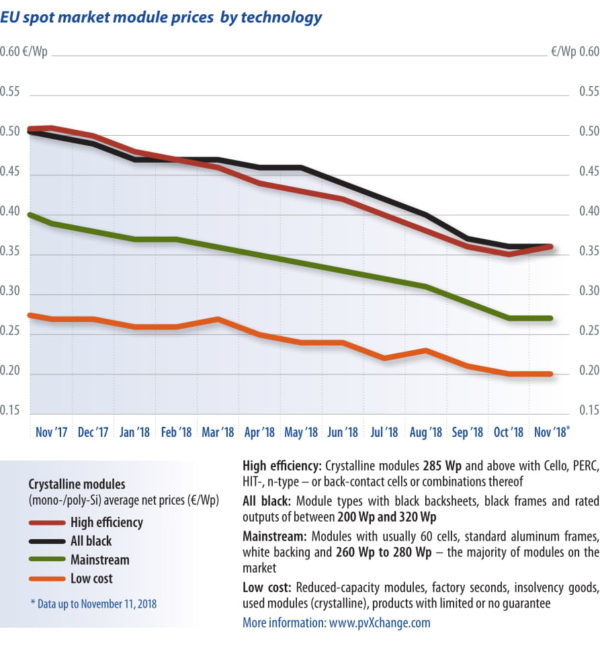
“I’m not installing anymore this year – I’m not going to put myself through that kind of stress.”
You increasingly hear this or something similar when you talk shop to planners or installers in Germany these days. And you can also hear some variant of, “If I order more modules now, can you guarantee me that I’ll actually get them on time?”
In short, there is a simmering discontent in the market that occasionally boils over into all-out anger but also expresses itself as simple resignation. So, what is it that has quashed the generally positive mood so quickly?
Well, the politicians are about to bring about what they apparently prefer to do whenever the tender little seedling of solar again threatens to grow into a stately plant – they trample on it by prophesying horrendous costs for the general public, and feed their prognostications with poisoned water in the form of massive cuts in subsidies, the withdrawal of privileges, and further reprisals, to ensure that all new shoots are certain to die of it as quickly as possible.
Unfortunately, the mere utterance of changes and cuts is now enough to confuse the market and bury any planning certainty. This happened at the beginning of November, when the Federal Ministry for Economic Affairs and Energy announced that the feed-in tariff for roof-mounted photovoltaic systems between 40 and 750 kilowatts peak would be reduced by around 20% to the level of ground-mounted systems by January 1.
It is hardly surprising that an unprecedented run on all resources available this year began. However, since no one was prepared for this scenario, capacities became scarce within just a few days, be it for modules, inverters, substructures, or even installation services. The stakeholders, almost without exception, are currently trying to complete any rooftop systems that are halfway ready for construction this year or to push forward projects planned for next spring. Where this is not possible for whatever reason, projects have been put on ice as a precaution. For investors and the entire development of the solar industry, this situation is a catastrophe.
The development of module prices has meanwhile also shown a clear trend towards price stagnation or slight increases. Even before the Renewable Energy Law (EEG) adjustments became known, the major manufacturers had reported an emerging bottleneck, which can be attributed primarily to increased demand in the southern hemisphere and Asia. The few goods still freely available in Europe are now quickly sold out or offered at significantly higher prices. Due to the uncertainty about future developments in Germany, which will continue at least until the next meeting of the Bundestag Economic Committee on December 12, 2018, no reliable statements can be made about the availability and further price development of solar components.
In the spot market at least, we can expect that due to order cancellations, manufacturers and wholesalers will always be able to offer surplus stocks at moderate prices. These prices are likely to fall as the Christmas season and the end of the year approach. If, in the meantime, the political parties send clear signals in favor of easing or postponing the deadline, the situation could immediately change radically. After the good performance of the Greens in several state elections, the party certainly has the political leverage to influence the government’s plans. There is also hope on the part of some SPD and CDU-governed federal states, which have a high density of solar firms and traders.
Indeed, it has become apparent that we will not be able to continue for much longer without resource-conserving, low-polluting energy production, and that there is public demand for more green electricity. Yet, policymakers’ actions speak a completely different language – they have made every conceivable attempt to prevent the rapid implementation of the energy transition. Billions in giveaways to the old energy industry, delays in phasing out coal, Dieselgate, and the unchecked flood of plastics are just a few of the highlights in a gigantic tableau of failure. For years, well-known problems have been covered up and whitewashed, with remedies delayed. But as soon as it comes to the solar industry, it is suddenly possible to push through deep cuts at an accelerated pace at every level within weeks! They claim to want to make the energy transition affordable and protect citizens from unreasonable burdens. The opposite will be the case – it will cost us all dearly
Martin Schachinger, pvXchange.com
November 2018: Is the bottom in sight?
Judging merely by the prices over the past few weeks, the answer would seem to be an unequivocal no. But if you believe the voices of some manufacturers, then the end of the across-the-board slump in module prices is within reach. Once again, a shortage seems to be emerging, at least among some tier-1 manufacturers.
Both inexpensive multicrystalline and high-performance monocrystalline modules with PERC cells are no longer available on short notice in whatever quantity is desired. Apparently the products of the top manufacturers have sold so well in recent weeks due to the low prices that short-term supplies are no longer guaranteed.
Some manufacturers have even started turning away major project enquiries for this year and are advising customers to wait until the first quarter of next year. And potential buyers can drop their hopes for further discounts – quite the opposite.
Solar module prices for delivery in October and early November are at best stable, if not rising slightly. That goes to show how rapidly the market can turn around.
Some producers had apparently cut back production immediately after the subsidy cuts in China became public to avoid producing module stockpiles and risk further erosion in value.
Less production in Asia also means that fewer goods are shipped to Europe. Many modules that were already stored in and around the Port of Rotterdam have probably already been sold over the past few weeks.
Also, there are currently still few container goods delivered directly from China. The many smaller manufacturers active in the European region in the past first have to regain a foothold. Due to the recently removed market restrictions, they had scarcely any realistic sales opportunities in the European market over the past five years.
These tier-2 and tier-3 products are trading at a price discount of only a few cents per watt peak but are a riskier buy than the established brands. The major players now also have a noticeable technological lead, which is reflected in more modern cell formats and higher performance classes.
Producers who do not make significant investments in research and development will be hard pressed to compete with ever more efficient modules using less material.
A recently published forecast by the International Energy Agency (IEA) expects the number of new installations worldwide to fall by 15% year-on-year to around 83 gigawatts in 2018. The slump is mainly attributable to lower demand due to reduced state support programs in China.
In my view, however, the authors have failed to give adequate weight to the increased attractiveness of PV systems thanks to falling module prices.
By the end of the year, these will have fallen in some categories by up to 30% compared with the price level in December of last year. This of course boosts demand, and not just in the area of new plant construction.
The repowering of old plants – that is, replacement of poorly performing old modules with the latest generation of products – is also becoming increasingly attractive. At module prices that are just a 10th of the price of the original modules installed eight to ten years ago, the financial cost of a system upgrade can quickly pay off.
Declining demand naturally leads to overcapacities among manufacturers, which are not completely offset by control measures taken by the affected companies, such as plant shutdowns to create artificial shortages.
The analysts at TrendForce claim that global module production capacities now total around 150 gigawatts, which equates to almost double the level of this year’s demand.
As a result, we are on the cusp of another wave of consolidation of unprecedented magnitude. According to some manufacturers, global market prices for multicrystalline solar modules are already in a critical range anyway, in which hardly any modules can be produced that meet today’s requirements.
Further price reductions are practically impossible if current quality standards are maintained, at least with the familiar technologies and manufacturing processes. Simply scaling to ever larger dimensions beyond the 10 GW production capacity range could provide a remedy.
Such gigantic factories, which alone could supply a 10th of the world’s demand, would first have to be run at full capacity to benefit from all the economies of scale. One wonders how many of these “gigafabs” could operate at the same time and in competition with each other and what would happen to the many hundreds of smaller production facilities that currently still exist throughout the world.
At present, this seems to be the trend, especially among European manufacturers who, although they are still holding on to their own brands that are well established with their customers, have long since had the modules themselves produced in one of the large contract manufacturing plants in Asia.
After all, the European companies are still liable for their warranties. But how much is that really worth in a limited liability company with low liquidity reserves?
To be on the safe side, the plant operator is more likely to go to one of the major Asian manufacturers, which at least also has a sales office and a service team in Europe that can be contacted in the event of problems.
Nevertheless, carefully checking the terms and conditions of warranties and how they are secured in the event of a claim is essential to avoid any nasty surprises later on.
The rule of thumb here is relatively simple: The lower the product price, the more carefully the conditions of sale should be examined.
High quality materials, quality assurance, and warranty reinsurance cost money, which is immediately reflected in the price – if you buy too cheap, you buy twice or pay with your life…
Martin Schachinger, pvXchange.com
October 2018: Everything must go?!
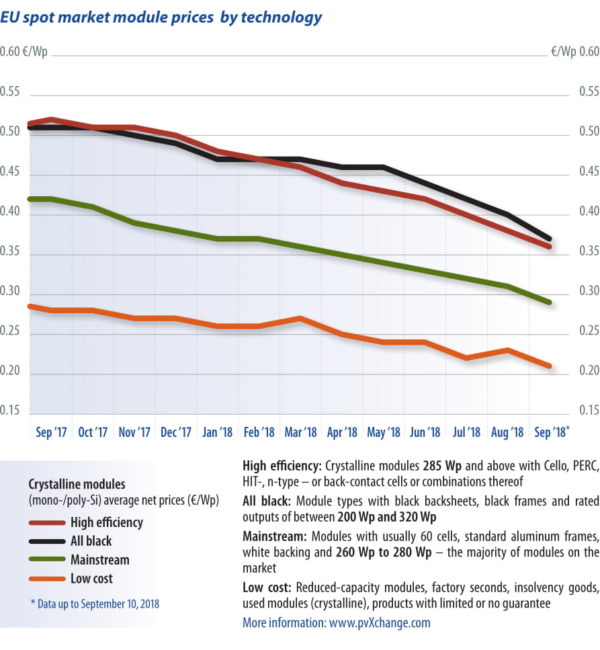 It’s official: as of September 3, the minimum import price is relegated to history! After the majority of EU representatives consulted in preliminary talks spoke out against further market restrictions, the Commission is refraining from a further review of possible acts of price dumping by Chinese manufacturers. In the context of protectionist measures in the USA and corresponding retaliatory measures by Europe and China, continued market restrictions for Asian solar products would have sent a very bad signal.
It’s official: as of September 3, the minimum import price is relegated to history! After the majority of EU representatives consulted in preliminary talks spoke out against further market restrictions, the Commission is refraining from a further review of possible acts of price dumping by Chinese manufacturers. In the context of protectionist measures in the USA and corresponding retaliatory measures by Europe and China, continued market restrictions for Asian solar products would have sent a very bad signal.
A chapter that opened in 2013 and led to major turmoil in the PV industry will finally be closed at the end of 2018. There is one thing the very contentious punitive tariffs and protective mechanisms have not achieved, however, and that is the rescue of European cell and module production. From this perspective, the policy was an incredible waste of resources and opportunities that set the European PV market back years. Numerous regions around the world have long since bypassed former leading markets such as Italy, Spain, and of course, Germany, in terms of installation figures. For many years now, European markets have been merely a footnote in solar history.
Waiting for a sign
But what does the abolition of market regulation mean for domestic markets and the further expansion of solar energy? Not all players are back from the summer break yet, either on the supply side or on the purchasing side. Following subdued demand over the past four to six weeks, when prices remained largely stable, machinery now has to be restarted, and many projects may have to be recalculated. To this end, players are awaiting essential price signals from the market. At the moment these are scarce – apparently none of the big manufacturers want to take the first step. They are biding their time, waiting to see when the competition will react, or pointing to well filled order books. For nearly all well-known brands, price corrections in supply contracts are not expected before the end of September, when the current turbulence has subsided.
Increasingly, however, smaller (tier-2) manufacturers are already taking action, and throwing modules into the ring at prices in the lower 20 cent range. Some tier-1 products are also already being offered at prices well below the current minimum import price, even though the information from Brussels is brand new. Thus, index prices have to be adjusted downwards by one to two cents per watt, almost on a weekly basis. Monocrystalline modules in particular have so far been trading here well above world market prices and have a lot of catching up to do. Prices for high efficiency and all black modules have fallen by up to three cents in the past three weeks, while the mainstream module price is only two cents below the previous month’s level. In percentage terms, this corresponds to a reduction of 5.3% to a maximum of 7.5% – the price avalanche is slowly but surely gathering momentum.
One wonders what the next steps will be, and when the first modules made in China will arrive on European shores. Until the official end of restrictions, they were not allowed to be imported into the EU without high penalties. However, we can expect containers to be unloaded in the ports of Rotterdam, Antwerp, and Hamburg in the next few days and weeks, and waved through customs without surcharges. Then, it is a matter of speculation as to what price level will establish itself. Supposedly modules are already trading at prices close to cost of production. On the other hand, large inventories have to be drawn down, and the law of supply and demand still applies. As the end of the price spiral is not yet in sight, there is a rush to liquidate inventories and if necessary to sell goods below production cost to avoid even greater write-downs.
For investors and installers, however, positive development is emerging. Lower prices mean that many projects, especially from previous tenders, can now be implemented more easily, and higher returns achieved. The only limiting factor will be scarcity of installation capacity, which is already becoming apparent. Of course, consideration should also be given to the influence of low prices on quality. Many manufacturers will probably be forced to cut costs wherever possible at the expense of the quality and long-term stability of their products. We therefore need vigilance and a bit of common sense not to leap at every bargain dangled in front of our noses.
Martin Schachinger, pvXchange.com
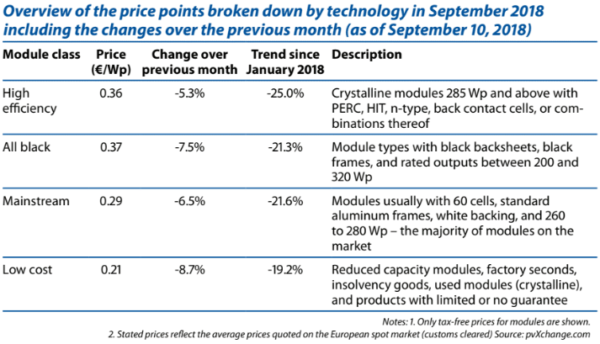
Table: pvXchange
September 2018: PV poker game
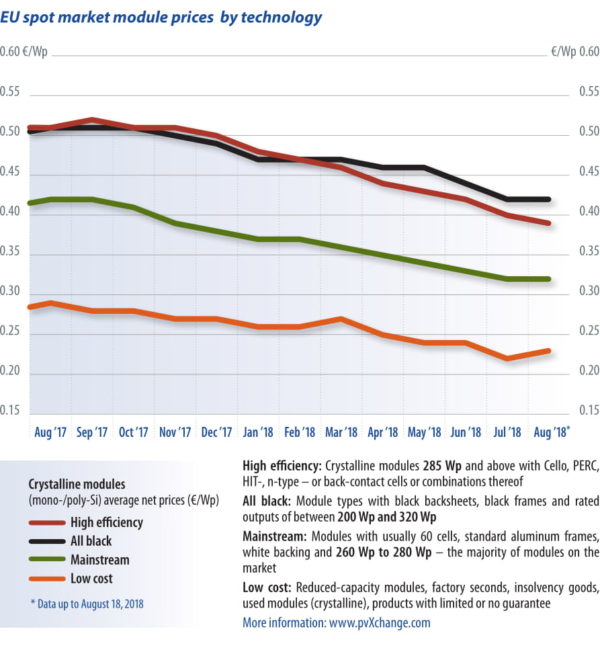
Graph: pvXchange.com/ Harald Schütt
With subdued demand over the past four to six weeks, prices have remained largely stable. Only certain products were offered at a discount over the previous month, which has led to minor price changes for high-efficiency modules and standard multicrystalline modules (mainstream). However, the price changes are actually smaller than the rounded index values make it appear, and are in the sub-0.5 euro cents per watt-peak range. Particularly with the major brands such as Hanwha Q Cells, JinkoSolar, and Canadian Solar, there is not much activity at the moment.
There are a number of reasons why retailers’ sales figures are generally weak. First of all, the persistent high tem- peratures combined with the school hol- idays in Central Europe should be men- tioned, which seems rather unspectacular, since this is a seasonal phenomenon and therefore occurs regularly in summer. However, there is another effect at play, which is due to the upcoming but still uncertain decision of the EU Commission regarding an extension of import restric- tions for Chinese cells and modules. On September 3, the measures currently in force will expire and the Commission will have to state whether it will continue to review the dumping and subsidy infrac- tions, or whether it will let the matter rest. In the event of a review, there is a risk of a provisional upholding of punitive tar- iffs and minimum import prices, at least until the Commissioners have reached a finding. However, this is not anticipated before the beginning of 2019. Since the stakes are high – particularly for man- ufacturers and retailers – rumors and wild speculation abound about the out- come of internal EU negotiations. It should be clear enough that this deci- sion will be influenced largely by foreign policy. Numerous politicians throughout Europe, but also affected companies, have already been consulted and mutual inter- ests weighed in order to come to a con- clusion. But authoritative information that gives an indication of the outcome of the negotiations is nowhere to be found – everything is still wide open, and there are still plenty of things that can happen.
Wait and see
All that remains for the affected compa- nies at all levels of the PV value chain is to wait and see or place a bet on the out- come of the negotiations. Depending on how they read the situation, suppliers are either calm and keeping to current price levels or are betting on the elimination of market regulation measures. As a result, more discounts are now being offered to reduce inventory levels and avoid even greater devaluation. With customers, however, the trend is toward fence-sitting until the decision is announced when they have had a chance to observe how the market reacts before making the deci- sion to purchase – possibly with negative effects. A closer look at the possible scenarios reveals why this is the case:
If import restrictions are lifted, suppliers of inexpensive Chinese goods will very quickly enter the European market, as demand in Asia is currently declining and warehouses are increasingly filling up with available goods. The resulting price slide will inevitably lead to a devaluation of existing inventories in Germany. Even a sharp rise in domestic demand will no lon- ger be able to accommodate the immense quantities of modules. Module prices in the low to mid-20 euro cent range are entirely conceivable for the rest of the year. This would be a highly posi- tive development for investors and builders, as the lower prices would naturally lead to higher returns. The only limiting factor will then be the scarcity of installation capacity.
If the import restrictions remain, however, cell and module prices are likely to stagnate. There are even rumblings of pos- sible price increases triggered by a bottleneck in MIP-free cells and modules. Supposedly, developers in Germany and through- out southern Europe have built up a project pipeline so large that there are not enough non-Chinese modules available to cover it completely and on schedule. The result would be a brawl over delivery capacities and deadlines, as well as a gradual price adjustment to the barely acceptable level, as has often been observed in such situations. Those who find themselves in this situation may regret that they did not take better precautions and avail themselves of one of the module offers currently available. The market is currently a game of chance, with all of the play- ers deciding for themselves which card to bet on, what risks they are willing to take in the game of module price poker, and what they stand to win or lose. Martin Schachinger, pvXchange.com
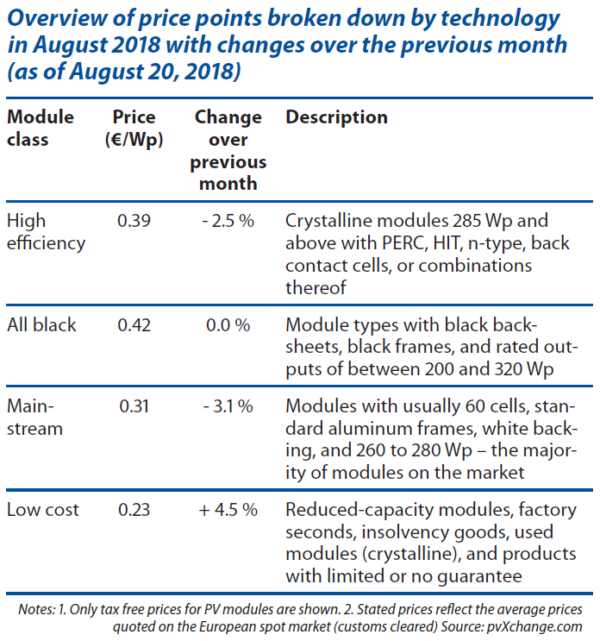
Table: pvXchange.com
August 2018: Greetings from the madhouse…
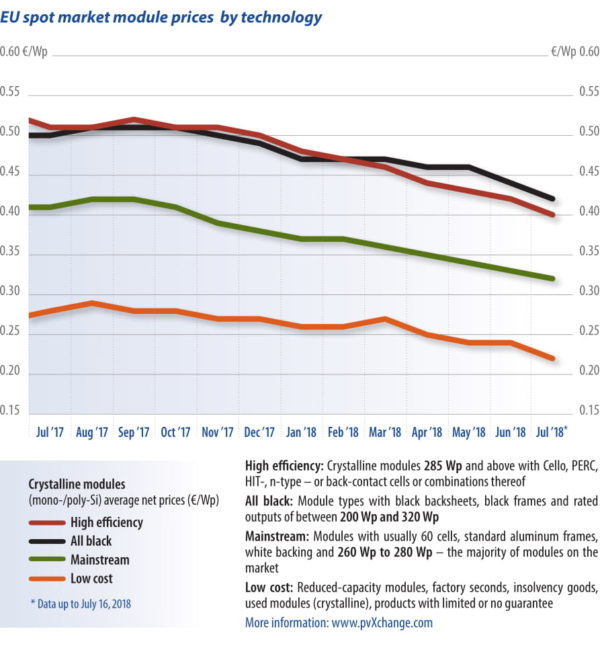
Module price index: So ended a recent e-mail from a good friend in the PV industry, a pioneer with over 30 years of experience. It was regarding an exchange about current market developments and the sharp price declines over the past few weeks and months – not a bad analogy!
But the influence on global brand development has never been as great as in this case. All of the forecasts of the past few months have already become obsolete. Instead of predicting a decline in installation figures, the European industry association SolarPower Europe, in its recently published global market outlook, now anticipates a small but very real increase of 3 to 4% in 2018, and 5 to 6% in 2019. Only then will there be a return to healthy growth of 12 to 15% annually, as we have already seen on average over many years. For Europe, however, the forecasts for the coming years are somewhat more optimistic, with an average increase of 15%. Within Europe, Germany should again become one of the strongest markets, with an increase of 20%, even without further political support.
Initially, prices for multicrystalline products in particular were expected to continue their precipitous slide due to imminent or current oversupplies. Buyers were hoping for a drop to the €0.25 mark, at least for megawatt-scale volumes. However, the major Asian manufacturers at all levels of the value chain apparently knew how to take quick corrective action. Through artificial shortages, such as production shutdowns, companies are now trying to counteract oversupply and the associated price free fall. Although the effect is not yet immediately apparent, as is evident from the continuing decline in prices, a major crash could probably be prevented in the long term. However, it is doubtful that this strategy will work out in the medium to long term and that prices will stabilize at the current level or just below it.
Europe’s MIP
Module and cell manufacturers with large production capacities in China are waiting for the EU’s minimum import price to be eliminated in September so that they can then offer their modules even more cheaply in Europe. If this actually happens, outlook for the remaining European manufacturers would likely be grim. Their survival would then depend heavily on general market growth, their international business orientation, and strong support from customers. Yet, even if there is a review of the dumping case against Chinese producers and the minimum import prices are kept in place for the next three to six months, it will only be a short reprieve for domestic producers.
I myself expect a general price dip of a maximum of €0.02 per watt peak across all technologies in the fourth quarter. The drop in prices for high-efficiency modules is currently already somewhat more pronounced than for other products, as high performance is itself becoming increasingly “mainstream.”
This is why I raised the lower limit for “high-efficiency” modules to 285 watts peak in May, but these products have become disproportionately cheaper over the course of the year. Nevertheless, the price spread to the mostly multicrystalline “mainstream” modules is still 8 to 10 cents per watt – at the current price level, a difference of 25 to 30%. This price spread cannot actually reflect the difference in the manufacturing costs between monocrystalline or multicrystalline cells, but rather indicates that many modules with lower performance classes are already being sold off close to the production cost to reduce inventories.
Strap on the straitjacket and off into the rubber cell would be the right course of action for some politicians who repeatedly manage to stop generally positive market development through erratic, ill-considered actions and tear down what they have already created.
The best strategy in this roller coaster market is probably to rely on one’s own experience and also a little on one’s own gut. So far, every downturn has been followed by an upturn – usually relatively quickly – because we in the industry have learned to adapt to adversity and make the most of it. In the medium term, the world market for renewables has still grown and system prices have fallen. The motto is to stick to your own vision, and the way ahead is to stay the course in an unsteady market gone mad.
Overview of the price points in July 2018, broken down by technology, including the changes over the previous month | ||||
Module class | Price | Change over | Trend since January 2018 | Description |
High efficiency | 0.40 | -4.8% | -16.7% | Crystalline modules 285 Wp and above with Cello, PERC, HIT, n-type, or back contact cells or combinations thereof |
All black | 0.42 | -4.5% | -10.6% | Module types with black backsheets, black frames, and rated outputs of between 200 and 320 Wp |
Mainstream | 0.32 | -3.0% | -13.5% | Modules with usually 60 cells, standard aluminum frames, white backing, and 260 to 280 Wp – the majority of modules on the market |
Low cost | 0.22 | -8.3% | -15.4% | Reduced-capacity modules, factory seconds, insolvency goods, used modules (crystalline), products with limited or no guarantee |
The prices shown reflect the average asking prices for goods cleared through customs on the European spot market, as of 16 July 2018. | ||||
Martin Schachinger, pvXchange.com
July 2018: Bad for the industry – but unfortunately, awesome
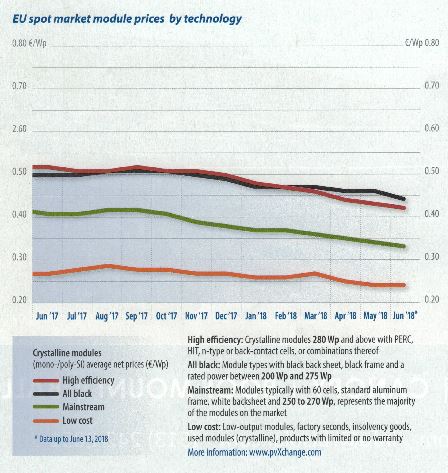
Module price index: Taken from a song by beloved German group Deichkind, the phrase ‘leider geil’, roughly translated as ‘unfortunately awesome’, applies quite nicely, in my view at least, to the current downward spiral of module and cell prices. Of course, it is clear that some companies – especially module producers – will again fall by the wayside. We wholesalers will also have to contend with the uncertainty of potential customers who cannot decide whether to buy now or rather in a few weeks or even months. But if we are honest and serious about restructuring the global energy system then falling prices are, unfortunately, awesome.
What is behind the continuing downward trend despite a general increase in demand? First and foremost, it is the somewhat surprising announcement made by the Chinese government in May, to make major cuts to subsidies and incentive programs for the further expansion of renewables. Analysts expect PV installation figures in China to fall by 20 to 30 gigawatts compared with last year, which is quite dramatic given the rapid increase in production capacities, particularly in Asia. The reasons given for capping renewables development include the high costs of the enormous build-out in recent years, as well as problems with grid expansion and the connection of new plants. It may be that the decline in China will only have a minor impact on global demand over the long term, being offset by other rapidly growing markets, but the pressure on manufacturers is already mounting due to the overcapacity already present in the market.
Delays in project implementation on the one hand, and uncertainty about future module price developments on the other, have led to large-scale cancellations by a number of major manufacturers in recent weeks. Some of the key players in the industry simply no longer feel bound by their perhaps too loosely worded purchase agreements, which has become a serious problem for suppliers. In times of oversupply the customer is suddenly king; and takes revenge for having been left in the lurch too often in the past. Gone are the days when module manufacturers could pull out of agreements with flimsy arguments to earn a few cents more in another market, and still manage to keep their buyers. Now the tables are turned! Bad for companies, good for market prices, good for customers – unfortunately, awesome.
Following a shortage of inexpensive modules due to artificial bottlenecks caused by market regulations in the U.S. and Europe, and the resulting stagnation in prices, we are now facing a glut of modules which will inevitably cause prices to fall. What seemed cheap yesterday is already too expensive for today's market. Of course, this causes buyers of PV systems to hesitate, and stocks which currently have to be devalued almost weekly, are growing. “I love this business – it never gets boring,” a wholesaler friend recently said to me, not without a touch of cynicism. Planning security? Not a chance! But the old hands of the PV industry have long since come to terms with this. The newcomers, on the other hand, are wide-eyed and wonder why their business models, which have proven so successful in other sectors, do not seem to gain traction in the solar industry. At best, they can quickly adapt to the volatile market situation. In most cases, however, this ends in bankruptcy or withdrawal from the market – and not without serious financial losses.
Does survival in the solar industry or in the entire energy sector really have to be so unpleasant and unpredictable; and if so, why? As long as the solar business – worldwide, by the way – continues to be at the mercy of policies driven by the purely economic interests of the old and large industrial sectors, we will remain a pawn of the forces that cannot be influenced by the environment-conscious citizens and voters of supposedly democratic governments. At the banquet of high politics the stakeholders in the renewable energy industry do not even have a seat at the children's table yet; at best they are permitted to lurk at the back door for a few leftovers to be tossed their way once the business dinner is finished. Good for the economy, bad for the citizen, bad for the environment – unfortunately, not very awesome.
In his recently published outlook for the next ten years, Kalle Remmers expects, “… for Germany […] little political will to implement core projects that serve the further development of our society. In a market as highly regulated as the energy industry, innovations are doomed to failure due to outdated rules.” I can only fully endorse that view! However, ever more rays of hope are coming from Brussels, where the influence of the industry lobby on EU policy is perhaps not quite as strong as on politics at the national level. Following the complaint I raised in my last commentary about excessive pollution in cities, binding targets have now been formulated for the Europe-wide expansion of renewable energies – not to 35 percent, as requested by parliament, but to 32 percent by 2030. Germany has shown itself to be an obstacle to meeting the targets, according to informed sources.
What has become of this country, which only a few years ago emerged on the international stage as an absolute pioneer in environmental issues and as the architect of the Paris climate protection agreement? Soon the requirements will be coming from Brussels and must then be transposed into national law by the EU member states within 18 months. Failure to do so could result in new lawsuits and severe penalties.
Overview of the price points broken down by technology in June 2018 with changes compared to the previous month:
| Module class | Price (€/Wp) | Change over previous month | Description |
| High efficiency | 0.42 | – 2.3 % | Crystalline modules 285 Wp and above with Cello, PERC, HIT -, n-type – or back-contact cells or combinations thereof |
| All black | 0.44 | – 4.3 % | Module types with black backsheets, black frames and rated outputs of between 200 Wp and 320 Wp |
| Mainstream | 0.33 | – 2.9 % | Modules with usually 60 cells, standard aluminum frames, white backing and 260 Wp to 280 Wp – the majority of modules on the market |
| Low cost | 0.24 | 0.0 % | Reduced-capacity modules, factory seconds, insolvency goods, used modules (crystalline), products with limited or no guarantee |
(The prices shown reflect the average asking prices for goods cleared through customs on the European spot market, as of 13 June 2018.)
Martin Schachinger, pvXchange.com
May 2018: He's gone again…
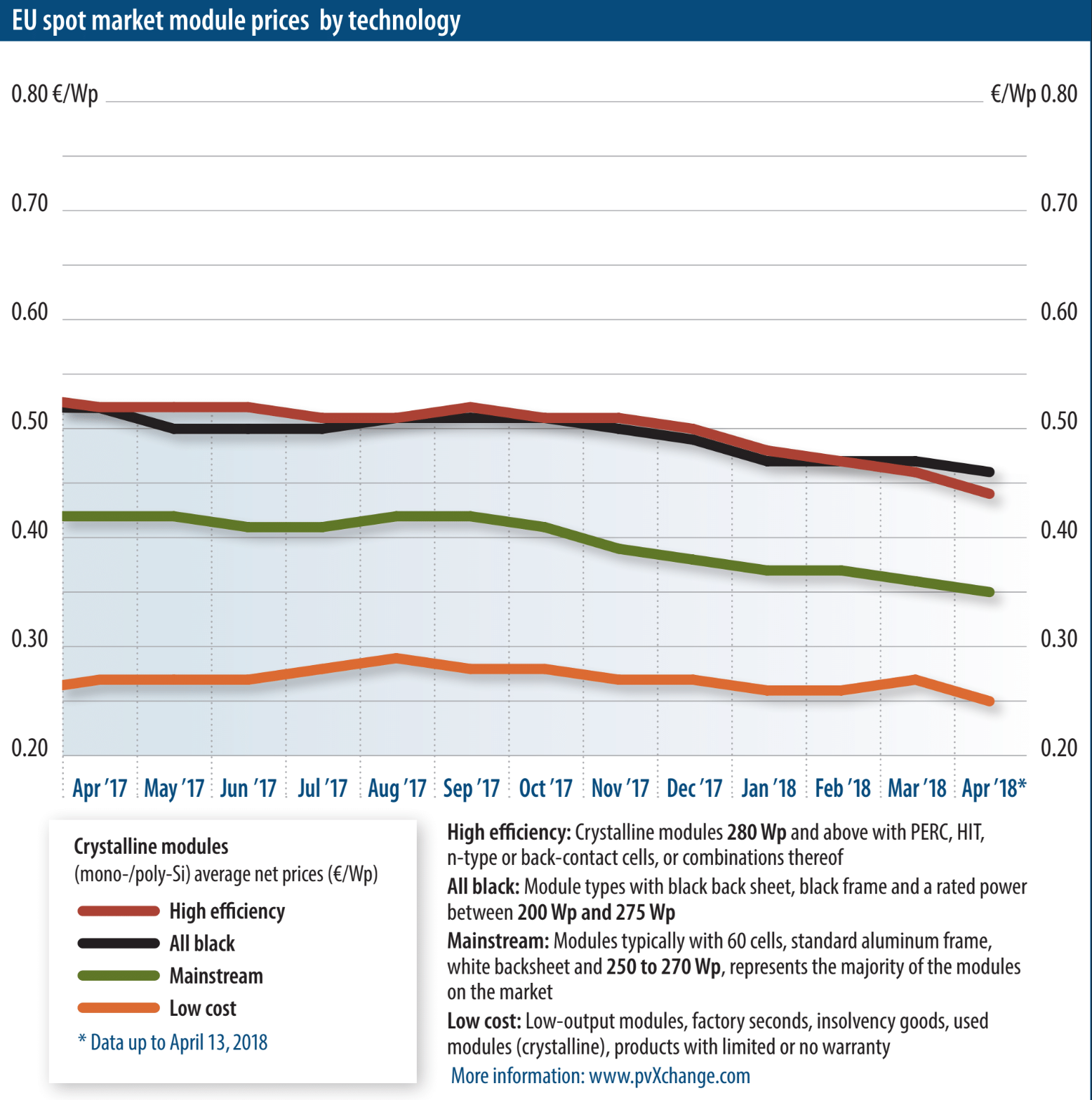 Module price index: … But is he gone for good? We are talking about Frank Asbeck and his company SolarWorld. It was only last August that I reported on the comeback of Mr. Asbeck as an investor and the new/old CEO of the PV module production and sales company that had risen from the ashes of insolvency. Now, the company has been shuttered once again – a new bankruptcy petition has been filed; employees fear for their futures, and the remaining customers for the value of their promised warranties. There do not seem to be many customers left, however; otherwise the story may have turned out differently. Trust in this formerly great German brand seems to have been permanently undermined.
Module price index: … But is he gone for good? We are talking about Frank Asbeck and his company SolarWorld. It was only last August that I reported on the comeback of Mr. Asbeck as an investor and the new/old CEO of the PV module production and sales company that had risen from the ashes of insolvency. Now, the company has been shuttered once again – a new bankruptcy petition has been filed; employees fear for their futures, and the remaining customers for the value of their promised warranties. There do not seem to be many customers left, however; otherwise the story may have turned out differently. Trust in this formerly great German brand seems to have been permanently undermined.
Will the “Sun King” try to ascend to the throne once again? I think he should drop it and abdicate. He has nothing more to prove to himself or us, his place in the history of photovoltaics is assured and he has certainly set aside a tidy sum for his well-deserved pension. Unfortunately, during his last tenure, he managed to cause quite a stir again, at least in the USA, by loudly supporting Trump in his measures to restrict the market. Now, the child has fallen into the well.
In Europe, the voices in favor of punitive tariffs and other protective measures have become quieter in recent months. Even if Asbeck should take up the scepter again, I do not expect any more activity in this respect. The influence of foreign investors in SolarWorld is now too great and level heads seem to have prevailed. As long as European manufacturers lack the financial resources of their Asian competitors and are unable to scale up their production capacities to the same extent, they will be on the losing side – tilting against windmills.
And, while we're on the subject of fighting windmills, this seems to be far from futile – at least in the recent open-technology tenders in Germany. To the contrary, all of the contracts were awarded to photovoltaic projects this time. This has demonstrated once again the technology that is most economical to implement in large projects, even if it only seems feasible using products from the all-powerful Asian competition. It is inconceivable that there could have been a similar result in the tender process if only German or European products had been permitted.
Unfortunately, another German module manufacturer has recently fallen: Calyxo. The manufacturer of cadmium-telluride modules was a spin-off of Q-Cells and has been struggling hard since the latter’s insolvency in 2011. Following the sharp decline in prices for crystalline solar cells, there has been less and less demand for thin-film modules in recent years. First Solar has proven, however, that technology does not necessarily have to hobble a company. The US manufacturer is apparently able to hold its own quite well against the crystalline competition from Asia, not least because of its size. Here, too, economies of scale have paid off, along with an intelligent marketing concept that relies mainly on large-scale plants developed and built either in-house or by a handful of partners. On the open market, First Solar modules are virtually unavailable or, if so, only after a long wait.
First Solar is currently launching Series 6, which it says is a particularly economical module. Considering the power classes from 420 to 450 watt-peak and the module dimensions of two meters by one meter, is already an indication that this is a product purely intended for large-scale commercial plants. Nevertheless, the broad-based rollout of this product is expected to exert price pressure on suppliers of crystalline modules, but not this year. The availability and visibility of Series 6 on the market is far too low.
However, what could put pressure on module prices is the elimination of all market restrictions on Chinese solar cells and modules. Following the official announcement of a gradual lowering of the minimum import prices by 2 cents per watt per quarter, rumors have been circulating for several weeks that the restrictions will be done away with completely. My research did not confirm this, however. The relevant documents only deal with the elimination of anti-subsidy duties, a very small proportion of the total punitive tariffs imposed. There has been no mention of eliminating the anti-dumping component yet. Even if all restrictions were lifted, the price trend would probably not change. Prices are increasingly decoupling from the effects of the EU Commission's market regulation measures.
At present, module prices are again affected predominantly more by supply and demand than by political influence. Moreover, the first large-scale plants in Europe are being built entirely without any major subsidies – in Spain, for example. In Germany, demand is rising continuously with rising temperatures, albeit at a moderate rate. Crystalline solar panels are available in sufficient quantities to trigger across-the board price declines since last month. However, silicon and wafer prices are pointing in the opposite direction, which means that the expected further price reductions at mid-year may not materialize for most module manufacturers. Have we already reached the bottom for the year? Somehow, I cannot really imagine we are there yet.
Martin Schachinger, pvXchange.com
April 2018 : It is not hard to become a dealer, but very hard to be a dealer.
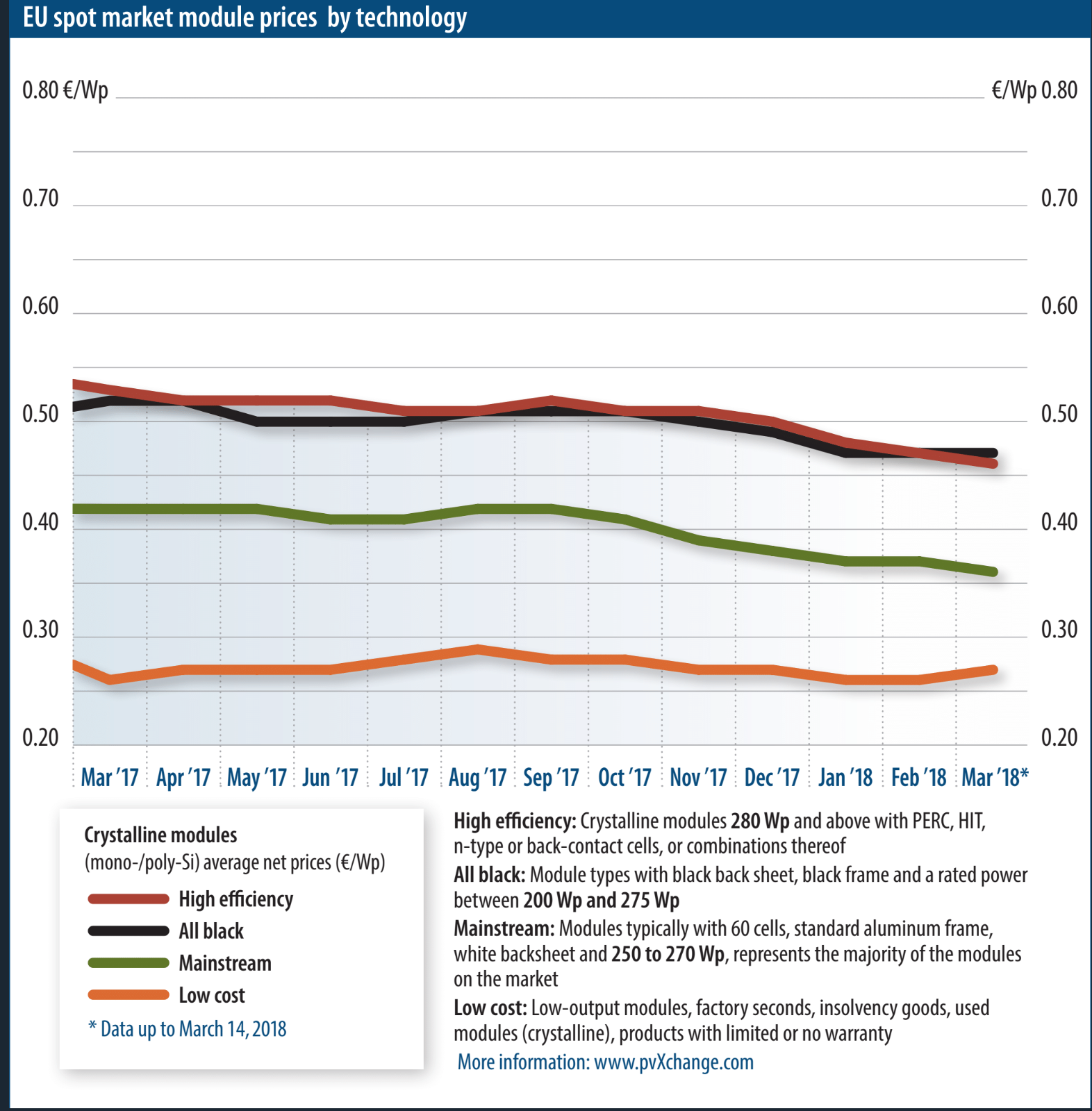
Module price index: Buying low, selling high, pocketing the difference – on the face of it, it does not sound complicated, and can also be quite lucrative if you do not have a large overhead. In the PV sector, too, there are still numerous small companies that operate like this without giving it much thought.
Many small wholesalers are not even aware of the risks they are taking. If something goes wrong, however, the personal damage in our economic system is also very small. Liability – except in cases of gross negligence – is limited to the company capital, which sometimes amounts to only a few hundred euros. In the worst case, the company is simply liquidated and then reopened under a different name. The real damage comes from the customers who made purchases in good faith from these irresponsible dealers because the price was a few cents cheaper there.
Many buyers probably think: “What could possibly go wrong if the brand behind the product is reasonably well-known? If there's a problem, I'll just contact the manufacturer.” That the buyer has been handed a bill of goods only becomes apparent when the manufacturer either ceases to exist or the customer is simply left twisting in the wind, “Not our responsibility, please contact the dealer!” The buck is passed back and forth until the injured party finally gives up. Lucky customers will have taken comprehensive risk insurance on their PV systems. In that case the insurance company is in charge and will somehow have to solve the problem.
It has to be made clear once again that the so-called distributor, i.e. the first entity that places a product on a closed market, is the party responsible before the law (importer's liability). What differs from case to case is whether a sovereign country or the economic community (e.g. the EU) is the determining factor in this respect. To be released from liability, the sales documents must clearly show that an upstream dealer was the actual distributor and can still be held liable if necessary. In the case of customs offences, however, it is possible to intervene right through to the end customer.
Within the framework of the European market restrictions for Asian modules, this is also the first hurdle to overcome when buying and selling such products. This practice raises a number of questions: Are the modules subject to the EU Directive for imports from Asia? Have duties been paid correctly and can this be proven plausibly? Has the manufacturer correctly identified the origin of the modules and the cells used to build them? Quite a few allegedly correctly declared modules have been withdrawn from the market in recent years due to forged documents, and the importers and manufacturers have faced steep penalties.
The next hurdle is the European Recycling Regulation, which contains the underlying idea of the polluter-pays principle but is implemented in very different ways in different countries. In this context, the national border defines the closed market, so that the obligations deriving from this regulation apply to the party offering a product for the first time in a local market. On a brand basis, the distributor has to register business involving PV modules, inverters, measuring technology and soon also cable material with the respective relevant authority. Only after a registration number has been issued, certain requirements are met, and financial securities deposited to guarantee subsequent disposal, may the products be put on the market.
Of course, in addition to all of these obligations it is important not to forget to regularly and conscientiously check the quality of the products traded. Unfortunately, it is not enough to have a handful of certificates issued by the manufacturer and trust that everything is correctly stated and that the documents are still valid. With the rapid pace of development and the short product cycles of today's PV modules, hardly any product available on the market is likely to match the version that passed an IEC certification. Due to the high costs, follow-up certifications tend to be sporadic. In principle, this is also no problem as long as no safety-relevant components are affected by the changes. A product-specific certification is always only a snapshot and not a guarantee of good product quality. But the current standard requires valid certificates to form the basis for the CE marking required in Europe. With these certificates, the manufacturer or distributor declares that the product meets the applicable requirements, also known as the EU Declaration of Conformity. Products that are not CE marked may not even be offered for sale!
The problems described here are only a small part of what a serious wholesaler who wants to act responsibly has to deal with in today's market. Since this involves financial and personnel expense, conscientious operators are naturally at a disadvantage over unscrupulous, or perhaps even ignorant competitors, the so-called free riders. But government checks are rare – people rely on reciprocal controls and reporting when irregularities are discovered. Many reputable trading companies are still wary of throwing the first stone, however, because they cannot be sure that this will not come back to haunt them. Many requirements are simply not feasible without changing the business model. There is an urgent need to correct this with legislation. Some obligations are reasonable and necessary, but often not known to those affected. There is an urgent need to remedy this situation, both through education and implementation.
Martin Schachinger, pvXchange.com
March 2018: Market up, prices flat
 Module price index: The scarcity of low-cost multicrystalline modules in the “mainstream” class, evident since the beginning of the year, continues. The Trump decision in the USA has not yet had any visible impact, such as increasing module volumes for the European market due to lower demand on the other side of the pond.
Module price index: The scarcity of low-cost multicrystalline modules in the “mainstream” class, evident since the beginning of the year, continues. The Trump decision in the USA has not yet had any visible impact, such as increasing module volumes for the European market due to lower demand on the other side of the pond.
Apparently, many U.S. installers seem already to have taken higher module prices into account. The cost-saving potential of other components and services seems almost to compensate for module prices, which are up to 30% higher, and the high demand so far this year and for future deliveries seems to be holding steady.
For the domestic market this means that there will be no price changes, at least for modules in the mid-range performance classes. As demand picks up at the beginning of February, prices could even rise again in some cases if additional shipments for Europe do not become available. Although German and European manufacturers claim that they can supply products at full capacity, this is still a drop in the bucket, considering their limited production capacities. If cells and materials purchased in Asia become scarcer, the tide could turn rather quickly.
Interestingly, in contrast to other module categories, the price for high power modules has slipped by a few percentage points. This is mainly due to the fact that more manufacturers are pushing their multicrystalline 60 cell modules into the 280 W range without demanding significantly higher prices for these products. As a result, the average price for ‘high efficiency’ modules is slightly lower. I will continue to monitor this phenomenon over the next few months to correct the classification at the appropriate time.
Another conspicuous feature is the proliferation of half-cell modules on the market. The claim is that by doubling the number of cells and further optimizations, such as increasing the number of busbars while simultaneously reducing the cross-section of wires, up to 3% more power can be teased out of a module. This is probably due mainly to the lower amperage at the cell level and the resulting reduction in transition losses. The downside is an increase of the inactive area between the cells and, because this format has many more soldered joints, an increased risk of hot spots due to poor soldering. We can only hope that there has also been a commensurate improvement in production technology, so that complaints and recalls of 120 and 144 cell modules can either be avoided or limited. In terms of price, these products are still in the upper segment, which makes them unattractive for medium and large-scale projects.
In recent weeks, demand for photovoltaic systems has risen sharply not only in Germany, but also in neighboring countries, where operators and installers have woken up. Whereas the demand for replacements of faulty existing modules was particularly high during spring maintenance, the demand for standard components for new systems has now also risen sharply. Overall, we anticipate an exciting and successful year for solar in Europe. Austria, the Benelux countries, France, and Spain are just a few examples of countries where ambitious PV expansion targets have been announced for 2018 and where corresponding incentives have either been introduced already or will be introduced. In Denmark and Sweden, too, the market is poised for an upturn if the announcements of politicians and industry insiders can be believed.
We can only hope that manufacturers have started the new year well-prepared, that they can quickly follow through on commensurate or planned capacity increases, and that the supply of raw materials is able to keep pace with demand.
Investors are also in the starting blocks and, in addition to China, they are focusing on Germany and Europe, according to the business consulting firm KPMG. We are thus well positioned for global market growth of 25 to 30% this year. After all, at current module prices there are still so many projects that can be implemented economically. There is no more reason to wait, unless…
Martin Schachinger, pvXchange.com
February 2018: What the new year
will bring …
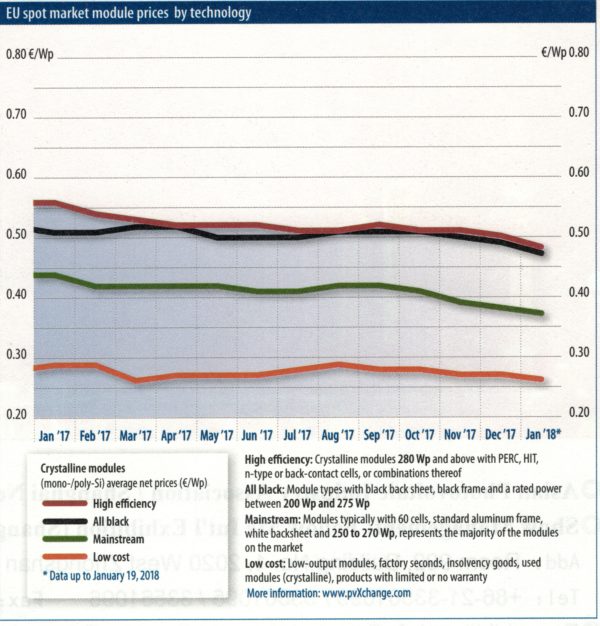 Module price index: Last year there was much speculation about what was coming in 2018. There were plenty of forecasts – and not just from me. Based on factors known to influence the market, such as module price development and other less distinct aspects – factors like the political and regulatory situation in high-volume markets or expected technological breakthroughs – the course appears to be more or less clearly mapped out.
Module price index: Last year there was much speculation about what was coming in 2018. There were plenty of forecasts – and not just from me. Based on factors known to influence the market, such as module price development and other less distinct aspects – factors like the political and regulatory situation in high-volume markets or expected technological breakthroughs – the course appears to be more or less clearly mapped out.
The year is still too young to lend certainty to expectations, or to spring any big surprises. Nevertheless, the past few years have shown time and again that as sure as the sun will rise, bumps in the road will come when they are least expected.
First, we were caught off guard in Central Europe with unusually early and severe winter storms and flooding. With the abundance of PV systems today, it goes without saying that buildings without photovoltaics were not the only ones affected. The maintenance and repair business has the capricious weather to thank for its first orders this year. However, it is not advisable to combine reconstruction with a planned repowering. It is important to be on the safe side of the law, in this case to ensure that the feed-in tariffs are not lost in a backfired attempt to boost profits.
Minimum import price
As reported last month, the gradual reduction of minimum import prices across all module groups is having an effect. An average reduction of €0.02/W at the beginning of the year can be observed, at least for higher-priced products, whereas prices for standard polycrystalline modules and special lots have fallen only moderately so far – on the order of €0.01/W. This was to be expected, however there is still insufficient availability of these sought-after reasonably priced products. Many installers are still biding their time to see whether the prices nudge down a bit before they buy any modules or sign contracts.
The absolute prices for modules with high efficiency by area (“high efficiency” and “all black” products) appear, at €0.48 or €0.47/W, somewhat too high compared to the general market sentiment. However, it should be noted that figures in the index are not weighted by supply volume. The prices for small lots of mono-PERC cells or other efficiency enhancing cell and module technologies are on an equal footing with project and wholesale prices for high performance multi-PERC modules. Products from manufacturers such as Panasonic, Sunpower, and LG are known to be traded at prices significantly higher than the average.
What advice can we offer project developers, installers, or contractors regarding their purchasing strategy? Well, it depends largely on the options available to them, which can vary considerably from project to project. If a high level of commitment is required – that is, on-schedule construction and a fixed purchase price – a contract model with more certainty is advisable. In this case, suppliers offer the reliable provision of the goods required on a monthly or quarterly basis. With appropriate security, such as a deposit on the next consignment or even the entire contract amount up-front, the modules or even all the other components are held in reserve exclusively for the contractual partner. Of course, these goods then have to be retrieved by the respective deadline, at the latest – a delay due to disruptions during the project is usually not an option.
Enhanced flexibility
Other suppliers are embracing a more flexible model. In this case, certain quantities, dates, and prices are also defined, but without a definite obligation to purchase. Bonuses are sometimes added to the agreement to increase the incentive to reach or exceed mutually agreed volumes. With this type of arrangement, there are generally no restrictions in place if the purchase target is not met. However, the non-binding obligation on the purchaser’s side comes at the cost of a certain non-binding obligation on the supplier side. Should the goods become scarce again, buyers may have to wait for the goods and may not be able to retrieve the desired quantities, or they may have to dig a bit more deeply into their pockets.
Irrespective of the contractual model, it is always advisable to discuss module quality with your supplier at an early stage, to announce spot checks and include relevant provisions in the agreement. These should regulate with legal certainty which measures are to be taken if the products supplied do not meet expectations. Trust is good – control is better! In his recent blog post, Karl-Heinz Remmers illustrated for us – in rather forceful terms – that this general wisdom can be applied in particular to the photovoltaics business. Even the biggest manufacturers sometimes make mistakes but are not always willing to admit them and provide an immediate fix. It is important to be vigilant and not to cut corners in the wrong places. It will be interesting to see what other ripples Remmers’s latest statement makes in the industry.
Martin Schachinger, pvXchange.com
January 2018: Always downwards – never up!
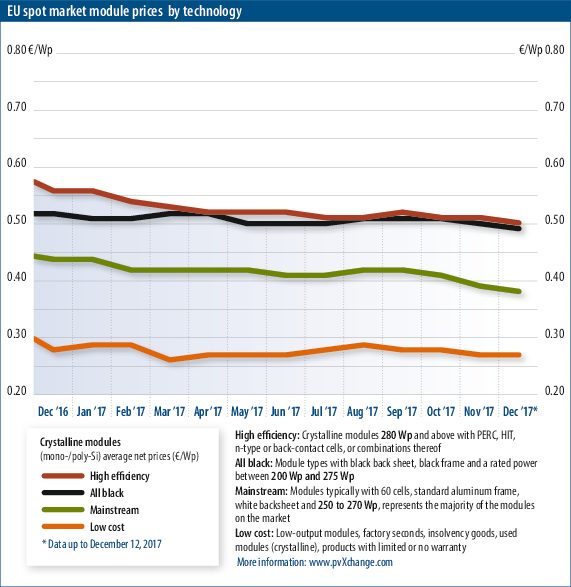 Module price index: This slogan will set the tone for developments in the first quarter of next year. What was already hinted at in the last quarter is becoming increasingly certain. On module orders for delivery in the coming year, there will be a discount of at least 10% compared to contract prices charged in 2017.
Module price index: This slogan will set the tone for developments in the first quarter of next year. What was already hinted at in the last quarter is becoming increasingly certain. On module orders for delivery in the coming year, there will be a discount of at least 10% compared to contract prices charged in 2017.
The coming price drop corresponds to a price for bulk purchases of €0.33 to €0.35 for multicrystalline and €0.39 to €0.42 for more efficient monocrystalline products. This price level is already reflected in the spot market, but only in the case of absolute fire sales, i.e. surplus lots or the resale of contract quotas, which have to be liquidated this year.
In particular, modules from tier-1 manufacturers are not available in unlimited quantities on any given date. Most major manufacturers claim to be fully booked up at least until the end of the first quarter, if not the entire second quarter of 2018. New customers with a need for inexpensive project modules are sometimes put on hold until April, May, or June, or have to make do with more expensive monocrystalline modules. This raises the question of whether installers and project-oriented companies should begin stocking up on spot market goods, even though the modules will only be needed in a few weeks’ or months’ time. At least when it comes to smaller quantities of less than one megawatt, there is currently still a relatively good selection.
But let’s turn briefly to the past year – which of the forecasts made at the end of 2016 have actually materialized and which have not?
The arrival of multi-PERC products which I forecast has not yet taken place on a very broad scale. Keeping the higher initial light-induced degradation (LID) within limits seems to have proven too complicated for many manufacturers. Although multicrystalline 60 cell panels with outputs beyond the
280 W mark are still a rarity, mono-PERC has also failed to gain acceptance to the extent expected. All in all, manufacturers and above all their customers have placed a strong focus on lower-priced modules in lower performance classes (mainstream). Traditional suppliers of high efficiency modules such as LG, AUO BenQ, and Sunpower probably lost market share. Likewise, SolarWorld AG also dropped off the radar and despite a change in strategy it has been unable to hold its own and has failed regain its feet following its insolvency. Confidence in this brand seems to have been severely undercut, and the allegedly loyal customers seem to have quickly moved on.
Overall, however, at least module prices in 2017 have fallen less than expected, or hoped for, following their mid-2016 price slide. For some technologies (high efficiency, all black), the decline in prices over the entire past year was only half as severe as that of the second half of 2016 alone, while for polycrystalline modules between 250 and 275 W, prices have held more or less steady. The lower price dynamics of modules were offset by a rapid drop in the price of energy storage systems. For example, small storage-linked systems have once again fallen significantly in price compared with the previous year. IHS Markit forecasts a bright future for the small-scale PV sector in Europe, with further significant growth rates.
Despite the relaxed market restrictions imposed by the EU Commission, there will probably not be a flood of Chinese products in the foreseeable future, as their domestic markets continue to be too attractive for manufacturers. In addition, there are now sufficient production capacities outside of China to serve regions such as the USA and Europe. However, a bottleneck is not expected in Europe due to the expected strong increase in demand for large-scale plants in Spain and France, because sales in the U.S. will probably decline markedly at the same time. Panic buying by American solar companies fueled by the anticipated tightening of import restrictions has probably come to an end, so that more MIP-free goods will find their way back to Europe.
Price pressure will likely be exerted primarily by Asian tier-2 producers, who are now regaining momentum as a result of the gradual reduction in minimum import prices. For example, some major manufacturers have already adjusted their pricing policies to the respective quarterly MIP levels, possibly motivated by the expectation of a shortage during the course of the year, as we saw in 2017. If this were to happen, it would again permit moderate price increases despite the competition. If necessary, bottlenecks could also be created by converting production lines to higher quality products or by controlling the flow of goods and limiting them in certain markets.
But let’s not paint such a gloomy picture. We should look forward with confidence to 2018! IHS Markit sees at least 15% worldwide growth in PV installations despite the alleged supply shortage, and I fully endorse that forecast. Will 2018 be another super year for solar? Get ready for peace and the energy transition!
Martin Schachinger, pvXchange.com
December 2017: Buy or wait?
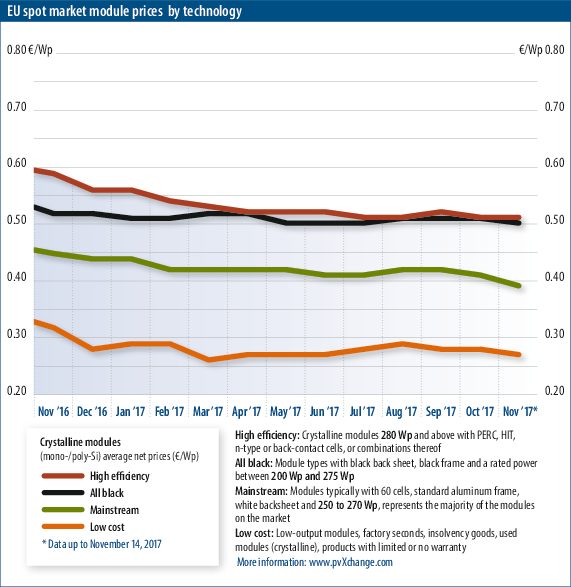 Module price index: This is the key question that confronts EPCs and installers nearly every late fall: which projects should be realized in the current year, and which can be postponed? How is module availability today, and how will it be in a few months? And of course: Where are prices headed?
Module price index: This is the key question that confronts EPCs and installers nearly every late fall: which projects should be realized in the current year, and which can be postponed? How is module availability today, and how will it be in a few months? And of course: Where are prices headed?
Giving a hard-and-fast answer to these questions is difficult for me as well. But I would like to try to narrow down the question, and at least provide a decision-making aid. Ultimately, the solution can only be worked out by each affected person, depending on individual situation, available installation capacity and liquidity or that of an installer’s customers.
Let’s first take a look at the current figures. After a long period of stagnation, standard module prices began a slow descent in October, whereas prices for monocrystalline modules with higher efficiency and a black frame or black backing (all black) did not start to fall until November. This trend is likely to continue, as more and more available lots are poured into the market and the gaps between the minimum import prices of €0.37 or €0.42/W published by the European Commission for October and the existing average prices in the market are closed.
Although many of the top tier manufacturers are still reluctant to adjust their prices downward for this year or the first few months of next year – citing good production capacity utilization and supply bottlenecks – their arguments have a hollow ring in view of the sluggish demand seen in Europe and the short-term direction of international markets as the year draws to a close. Thus, German manufacturers like Heckert Solar seem to sense their chances of claiming higher market shares, and are releasing their 2018 price lists unusually early, with module prices reduced by an average of 10%.
On the other side of the pond, the recommendations of the International Trade Commission (ITC) were handed over to the American President on November 13. They probably did not contain any surprises compared to the previously leaked version. Essentially, there are these well-known points: protection for the (nearly non-existent) domestic production plants, as well as market protection in the form of punitive tariffs on modules and cells from supplier countries with which the USA does not have a free trade agreement. Because there are hardly any cell or module production facilities in the free-trade countries, this is tantamount to import restrictions on nearly every major manufacturer and brand. There is one exception: Singapore. From the current perspective, REC could come out on top in this unbelievable game, since the manufacturer already operates a plant there with a production capacity of around 800 MW.
By 13 January, President Trump will have time to make a decision and present a bill. The only interesting aspect of this is Trump’s scope for interpretation and action. Although the President is free to implement or amend these recommendations, there are certain limits. The fine may not be set arbitrarily high, but rather only to a level that makes final prices no more than 50% above today’s average market prices. In addition, this protectionist measure may be imposed for a maximum of four years, but with the option of a one-time extension.
Back to the title topic
The current trend of falling prices will continue until the end of the year. In addition to project volumes becoming available, there will be an increasing number of clearance sales, so that the module shortage still noticeable in certain areas will probably disappear completely by the beginning of December. On the other hand, the emerging political uncertainty, at least in Germany, will not end so quickly.
It is far from certain that the Greens will prevail in the coalition negotiations with their positions on the energy transition – quite to the contrary. If the positions of the CDU/CSU or even the FDP should prevail within the framework of a future coalition, an end to the German Renewable Energy Sources Act (EEG) threatens retroactive changes. This would not be the first time the industry has been caught off guard.
Those who still have or can get free installation capacity should therefore consider building projects that have already been commissioned or at least developed on a turnkey basis, negotiate once again with their suppliers, and purchase the required material at reduced prices immediately. The main arguments against rapid project implementation this year are an already good capacity utilization to the end of the year and, of course, the increasingly deteriorating weather. In addition, the dependency on feed-in tariffs and the EEG will continue to decrease as prices fall. If a stable EEG is to be expected for the time being, longer guaranteed feed-in tariffs are another positive factor for construction and grid connection at the beginning of next year.
For 2018, further price reductions are emerging, both due to market and technology factors. In the case of mono-PERC modules, the expected drop in price is mainly due to economies of scale – more and more production lines worldwide are being converted to this cell technology, which will quickly increase the number of modules available on the market. In the case of multi-Si products, there are improvements in production technology, such as the increasing use of diamond wire saws. Experts believe that this could lead to a 5 to 8% reduction in cell and module prices.
The market prices for Asian-manufactured modules in Europe will probably be based on the currently valid minimum import price. From January, this will equate to €0.34/W for multicrystalline modules and €0.39/W for monocrystalline modules. Quarterly prices will then fall by about €0.02. This price trend can only be averted by a module shortage, but for the time being this is nowhere in sight. It would also be the first time in the history of antidumping duties and the minimum import price undertaking that actual module and cell prices would be above the legal requirements – unimaginable!
November 2017: Ratcheting up the pressure
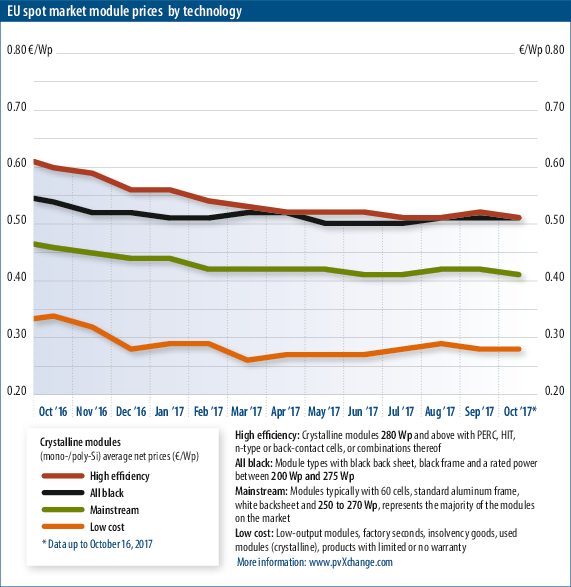 Module price index: Inexpensive multicrystalline, and to a greater extent monocrystalline, solar modules are still not available in sufficient quantities – more about this later – but the headline refers to something else …
Module price index: Inexpensive multicrystalline, and to a greater extent monocrystalline, solar modules are still not available in sufficient quantities – more about this later – but the headline refers to something else …
Although prices have not risen significantly in the last month, there is still no sign of an end to price stagnation. The EU Commission has reshuffled the deck and announced a gradual reduction in minimum import prices. However, this is not yet reflected in the short-term price trend. Also, the run on duty-free modules in the U.S. is not over. The industry is eagerly awaiting the recommendations of the International Trade Commission (ITC) on 13 November, and the subsequent decision from the White House.
Consensus is that it will be virtually impossible for the president to decide against the recommendations of the ITC extending protectionist measures. Currently, different camps in the U.S. are struggling to formulate concrete recommendations. Arguments for and against market protectionism – some valid, others less so – are making the rounds. The fact is that both Suniva, which fell on hard times and initiated the petition, and SolarWord Americas, which almost as a matter of course advocates further protective measures, have so far not been able to derive much benefit from the import restrictions on Asian products that have been in force in the U.S. since 2012 and in the EU since 2013. It is also unquestionable that if the minimum price of $0.74/W that Suniva is calling for on all newly imported solar modules were to prevail, the PV boom in the U.S. would come to an abrupt end.
Europe is far from such fanciful prices. The EU Commission recently adopted a new enforcement regulation. Starting in October, a minimum import price of €0.37/W for multi c-Si modules, and a threshold of €0.42/W for mono modules will apply. These amounts will then be reduced by €0.02 per quarter. It seems that a decision has been taken to differentiate between mono- and multicrystalline cells to better control import of the different types. It remains to be seen which strange effects and complications this will lead to. What is more interesting at present is what will happen to modules from manufacturers who have already voluntarily left the undertaking, and thus the obligation to submit to a minimum price. Among them are almost all of the well-known Chinese module manufacturers.
At present, it is still unclear whether these tier-1 manufacturers will now return to the undertaking, or whether an interesting new alternative will be tried, namely the imposition of a tax to bridge the gap between the target minimum import price and the original cell or module price. Sounds odd? – It is! As in the case with punitive tariffs, it would be possible to exact payment from the importer, the next link in the supply chain or even the end customer – that is, the operator. Products of Chinese companies that have been discovered in the past circumventing EU directives and involuntarily removed from the undertaking are still subject to high punitive tariffs.
Current reports on criminal prosecutions and arrests show that European customs officers are not to be taken lightly. I have reported several times on the attempts at circumvention and the more or less sophisticated methods used to funnel Chinese modules into Europe. Until now, however, there have been no concrete examples of successful investigations or harsh interventions by customs authorities. Now though, there have been several police raids and confiscations in the Nuremberg area, where Chinese modules of the brands Risen, Sunowe and Sunrise have been introduced into the market. There is talk of misappropriations in the two to three-digit millions, but this could be just the tip of the iceberg. It now seems that authorities are gradually working through investigations that have been going on in the background, and it will probably take years to decades for all of the cases to be closed.
So, what dangers lurk in the shadows? First and foremost, importers unable to fully prove the origin of imported modules are in the line of fire. As a rule, a certificate of origin for both modules and cells is required. Often enough, however, front companies or “sacrificial lamb” corporations are established to import questionable modules. If problems arise, they are quickly dissolved by the owners and can no longer be held liable. Customs officials are then authorized to turn to the next buyer in the supply chain, often a smaller middleman. The latter is then suspected of being guilty of tax fraud or tax evasion. This means that a purchaser of duty paid solar modules (e.g. DDP deliveries) also bears the risk of being held liable for improperly declared goods.
So what should you do if you want to buy inexpensive modules and not run the risk of having to pay retroactive duties and be subject to prosecution? You can still look for bargains and buy lower power modules or used products. There are also some larger lots of cheap Asian modules, for which it is essential to have all certificates of origin submitted before the contract is concluded, and a declaration that the certificates are also valid for the goods delivered. Alternatively, projects that have not yet started can be postponed until spring 2018. One thing is certain: at some point in the not too distant future, the situation in the U.S. will be resolved and the world market will have eased again. At that point, there will again be enough modules available and prices will inevitably fall, at least to the level of the minimum import price.
Martin Schachinger, pvXchange.com
October 2017: Brand name modules sold out everywhere!
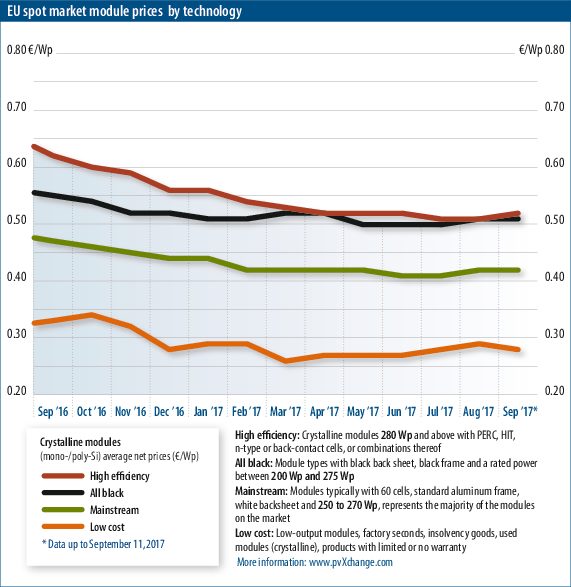 Module price index: The current situation in the module market could be called tense, if not dramatic. Now that there is finally healthy demand in the European solar market again, and many projects can finally be built, cheap products are scarce.
Module price index: The current situation in the module market could be called tense, if not dramatic. Now that there is finally healthy demand in the European solar market again, and many projects can finally be built, cheap products are scarce.
Standard multi-Si modules from Tier-1 manufacturers are virtually unavailable in bulk quantities, and the market for mono-Si modules doesn’t look any better. Prices for the remaining stocks have risen steadily over the past few weeks. Promised delivery dates are not adhered to and often postponed by days, if not weeks.
But it’s not only products from well-known Asian brands that are hard to come by on the European market. Even unknown module suppliers, some of whom manufacture in the EU, have been having difficulty keeping up with the increasing demand after the summer break. The same problems are even occurring with some well-known inverter manufacturers. Quite a few project developers and smaller EPCs complain that master supply agreements are not being adhered to by manufacturers and that the quantities ordered are not delivered as agreed. Most of all, efforts are being made to avoid upsetting their few major customers – internationally operating EPCs and distributors – and smaller customers are left in the lurch.
But where is this shortage of modules and inverters coming from, when module manufacturers are steadily reporting new sales records?
The problems in Europe are due in part to strong demand in China, which was driven by the gradual reduction in solar incentives mid-year and at year end. China’s National Energy Administration (NEA) recently announced the addition of 24.4 GWp of photovoltaic capacity in the first half of 2017. According to forecasts, well over 40 GWp of new PV capacity is expected to be added over the year as a whole. In contrast to the same period last year, growth will remain relatively high in the coming months. The government has introduced subsidy programs to build a further 5.5 GW as part of the Top Runner project – the deadline is the end of September 2017 – and the goal is to construct highly efficient PV systems.
The second market that has a major impact on regional development in Europe in the globalized world is the U.S. Here, many more PV systems were built in the second quarter of 2017 than originally forecast. According to GTM Research, newly installed capacity was just under 2.4 GW, more than 8% above the same quarter last year. However, it is becoming increasingly evident that many installers are willing to pay higher module prices than customers in Europe. The strong demand in the USA is mainly due to the anticipated announcement of the Suniva Petition by the International Trade Commission (ITC), which is expected to take place on September 22, 2017. Depending on the outcome of the investigations and the final decision of the president, there will either be further market foreclosure, or not, and the situation will improve.
Many U.S. investors and PV companies seem to be expecting tighter market restrictions for Asian products, and are therefore buying up any modules that can be delivered before the cut-off date. However, since average prices in the USA are 10% higher than in Europe, and up to 20% higher than in the rest of the world, it is not surprising where the urgently needed modules in this country end up, or why prices have been rising since the middle of the year. Nevertheless, the industry is optimistic, at least for the coming year, and predicts further growth in Europe. Whatever the outcome of the U.S. petition, the end of uncertainty will have a positive impact on the rest of the world market.
Martin Schachinger, pvXchange.com
September 2017: He's at it again!
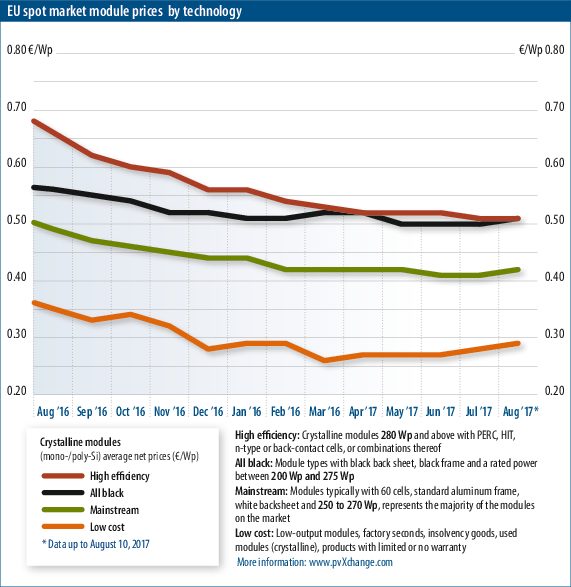 Module price index: Frank Asbeck just can’t leave well-enough alone. Now he has actually managed to find a deep-pocketed partner with whom to establish a new company to take over large parts of the old SolarWorld AG and its subsidiaries and continue operation. This would save some – far from all – of the company’s jobs in Germany.
Module price index: Frank Asbeck just can’t leave well-enough alone. Now he has actually managed to find a deep-pocketed partner with whom to establish a new company to take over large parts of the old SolarWorld AG and its subsidiaries and continue operation. This would save some – far from all – of the company’s jobs in Germany.
It remains to be seen in the area around Arnstadt, in Thuringia, and in Freiberg, Saxony, whether former employees will find subsequent employment – or, rather, not. Most of them will not be able to remain faithful to the photovoltaics industry, which at the manufacturer level, at least, is limping along.
In a way this is tragic because there were apparently other parties interested in the takeover of SolarWorld AG and its subsidiaries who were able to present a more credible intention to continue employing either the entire staff or a large part of it. Apparently, their concepts and offers were simply ignored, as there had already been talks at an early stage between Frank Asbeck and the insolvency administrator. Moreover, it is highly questionable whether Frank Asbeck at the helm of a SolarWorld 2.0 is really a constellation that has any chance of success. Is this really necessary?
That raises the question of the motivation of the self-styled “Sun King” and also what this means for the future development of a European solar market that has just started to turn around and return to its former size. Apparently saving jobs in Germany is not very high on the list of priorities in Asbeck’s concept of continued operations. Rather, the intent seems to be a desire to prove that the SolarWorld corporate strategy was not wrong and that economic success on the European and American markets can only be achieved when Asian competitors are shut down.
Now we come to my second question: what does “Asbeck-reloaded” mean for the photovoltaic industry in Germany and Europe? Over the past few months, it has become increasingly evident that individual markets in a globalized world cannot be seen in isolation. Deliveries of European solar panels have gradually dwindled, despite a continuous rise in demand. Once again, buyers are fighting tooth and nail to get their hands on the few containers of goods that have made their way into Europe. Buyers who did not plan ahead and secure module deliveries by concluding a master supply agreement, for instance, have been relegated to look on from the sidelines and postpone their projects until the fourth quarter, if not the beginning of next year. Before that time, there are no modules to be had, at least not from the well-known and solid manufacturers (tier-1).
Naturally, such a situation is immediately reflected in prices. While monocrystalline modules (high-efficiency and all-black) are still broadly stable on the spot market, we are already seeing rises of 0.5 to 1.5 euro cents per watt for polycrystalline modules.
The only buyers purchasing at the same price they paid in the second quarter are those previously mentioned, who concluded supply agreements. The price drop forecast at the beginning of the year for the third quarter was quickly compensated for when the scramble began for what are thought to be last duty-free modules of the year in the U.S. Because modules now cost up to 10% more in the U.S. than in Europe, it is not difficult to guess where Asian manufacturers prefer to sell their wares.
Whom do we have to thank for this situation, which is so unfavorable to us, Europeans? Not least, Frank Asbeck. Asbeck was instrumental in initiating anti-dumping investigations in the EU and the U.S. and bears significant responsibility for the resulting mandatory measures put in place in the form of market constraints and punitive tariffs. He is also fighting on the front lines of a new investigation in the U.S., the consequence of which has raised the specter of an even more radical Balkanization of the market.
In anticipation of a large bottleneck in affordable solar cells and modules, American project developers and wholesalers are apparently snapping up whatever stocks are available on in the global market.
Investors and potential European developers will now have to wait and see what happens when the dust settles in the U.S., or until the story there comes to a happy conclusion – that is, that the U.S. International Trade Commission (ITC) rejects any further protectionist measures. It is also unclear what Mr. Asbeck and his followers have up their sleeves for the European market. They are still holding fast to the principle protecting SolarWorld 2.0 against unfair competition from Asian competitors, no matter what the cost or who pays.
Martin Schachinger, pvXchange.com
August 2017: Origin must not be a factor – only quality should count!
Module price index: European manufacturers struggle to survive, while developers face problems importing from Asia. This needs to stop!
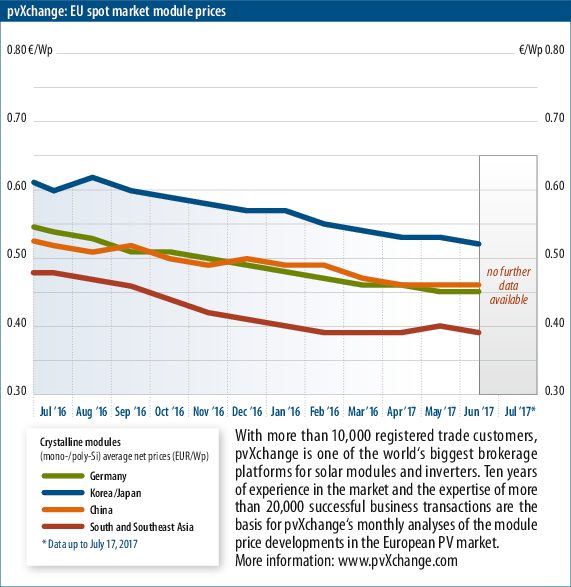 Nationality, skin color, and race must not influence judgment or treatment. What for people in an enlightened democratically organized society is considered, if not a matter of course then at least decidedly desirable, has not applied to PV panels for quite some time. Intrinsic value should, of course, be considered far more important than origin. Applying this principle to cells and modules, production quality should be the ultimate evaluation criterion. Quality is decisive for both future energy yield and the longevity of a PV installation. Price and availability are also very important for profitability.
Nationality, skin color, and race must not influence judgment or treatment. What for people in an enlightened democratically organized society is considered, if not a matter of course then at least decidedly desirable, has not applied to PV panels for quite some time. Intrinsic value should, of course, be considered far more important than origin. Applying this principle to cells and modules, production quality should be the ultimate evaluation criterion. Quality is decisive for both future energy yield and the longevity of a PV installation. Price and availability are also very important for profitability.
In reality, however, country of origin unfortunately plays a decisive role in the evaluation both of people – the current refugee problem is a case in point – and solar modules. We Europeans, and also Americans have a fear of being overrun by cheap foreign labor (or cheap modules) which could threaten or even destroy our domestic economy. At the same time, there is plenty of demand for both of these resources. And yet, we rarely pay attention to qualifications or quality. What we always recoil at is place of origin and apparently unlimited availability.
The European solar market requires large quantities of high quality, low cost modules. Chinese producers could satisfy this demand. Nevertheless, the European Union has been preventing them from meeting the urgent need for modules for nearly four years. This has massively obstructed market development, in particular the value chain upstream of the manufacturer. International meetings of the largest economic powers cynically pledge on a regular basis to lift trade barriers and end protectionism. This happened again recently at the G20 summit in Hamburg. Yet the result is mostly conciliatory words – no decisive action is taken.
Of course, at the same time, rules have to be established to ensure fair competition is possible and that local standards do not suffer. No one in the EU is happy with poor-quality modules, even if they are liquidated at fire-sale prices. Admittedly, there will always be a couple of players that also buy such goods, but they generally know what they are getting into. But all of the major Chinese producers work to very high technical standards. They can produce very good quality if given the chance, and when the market demand is there. And even when their products face strict quality requirements, higher degree of automation and economies of scale still make them less expensive than products from the much smaller European plants. The price difference is anything but huge, assuming equal quality, but in larger projects it is a decisive factor.
Based on the price dumping and unfair competition arguments, however, highly professional providers are essentially excluded from the EU market, while the gates are open to products from elsewhere in Asia, often with murky origins and dubious quality. The Chinese companies adapted to the new conditions very quickly, renting space in Taiwanese, Vietnamese, or Malaysian factories and dialing back quality standards in order to hold their own against price pressure from the new players in the market. Meanwhile, the quality of modules on the market has nearly dropped below the level it was at four years ago, and problems with faulty new products are beginning to pile up.
Overall, the availability of solar modules across all designs and cell technologies is poor at the moment, which has led to a general stagnation in price development, which was previously heading south. On the one hand, there are simply not enough European manufacturers to meet the current rising demand on their own, particularly following the demise of the major supplier SolarWorld. On the other hand, it is becoming more and more difficult to import Asian modules, even if the manufacturer is on the European Commission’s “white list.” Scarcely any Dutch providers still offer fiscal customs clearance for Taiwanese or Malaysian modules as the liability risk is too great and the situation is currently too opaque. Wholesalers wanting to import such modules to Europe can often only do so with expensive detours through other customs warehouses outside the large ports. We have to stop this nonsense immediately.
I announced an end to the publication of an origin-based price index a year and a half ago. I justified this step by pointing to the increasing difficulty of establishing the provenance of individual modules at all – basically, nothing has changed in that regard. In addition, the diversity of market actors since then has significantly decreased. This month I am officially and demonstrably ending the compilation of module prices by regional origin – true to the sentiment and the title of this commentary.
Martin Schachinger, pvXchange.com
 July 2017: The air is getting thin, but we won't let that spoil the mood!
July 2017: The air is getting thin, but we won't let that spoil the mood!
Module price index: Even after the European solar industry trade fair in Munich, Intersolar 2017, prices for all regions of origin and technologies have remained largely stable. The feared shortage is particularly evident in the market for high capacity modules, as well as in European products and previously European brands. Former SolarWorld customers are shifting their purchasing activities in the direction of comparable modules and in the medium term have bought up everything the market has to offer, which is why the modules of some manufacturers will not generally be available again until August or September. Nevertheless, providers remain locked in a fierce price war, preventing the cost of modules from rising, despite a looming bottleneck.
In the module sector, largely unknown manufacturers from the cell and wafer business with tier-1 status are rushing into the market. After Talesun and China Sunenergy (CSUN), HT-Solar (HT-SAAE) and especially GCL are making life rough for the established module manufacturers. Now that SolarWorld, one of the last major non-Asian producers, is out of the race, mainly Chinese companies are battling it out amongst themselves. And although local producers have just barely managed to stay competitive in the European project environment, they have long since missed the boat on international tenders. Prices in international projects – often no more than $0.30/W – are at a level that Europeans can no longer keep up with.
One thing that is still playing right into the hands of domestic companies is the fact that customs clearance for modules from Taiwan and Malaysia is becoming increasingly difficult, even when they are not modules from China with disguised origin, but goods actually produced in these countries. The European Commission is now so strict and resolute that many logistics companies offering importing or fiscal customs clearance as a service have had their fingers burnt. The draconian punishments – retroactive levying of the punitive tariff plus a fine – have led many service providers to make a wide arc around solar modules and cells. In the Rotterdam area, if not across the Netherlands, it is nearly impossible to find a customs agent willing to import Asian modules.
Despite the still turbulent times, the mood at the solar trade fair in early June was generally very good, even though the visitor numbers, and the crush at the trade fair stands, was rather modest. This left more time for intensive discussions and promising sales negotiations. Another thing worth mentioning perhaps is that it was the first Intersolar in Germany for more than two decades – if not since the advent of the solar trade fair itself – held without the participation of SolarWorld. The insolvency administrator preferred not to offer a platform for any embarrassing questions and keep the event at arm's length. Whether this was the right approach for a continuation scenario remains doubtful.
Module and inverter manufacturers were the focus of intense interest, even though you had to look long and hard to find genuine technical innovations in the area of conventional PV technology. That was offset by the many the many new products and services to discover in the energy storage area. Simplified billing methods and the electricity communities that are cropping up everywhere make it seem like we are on the cusp of a breakthrough. Convinced of this certainty, the market leader Sonnen was not alone in partying after the official close of the trade fair, Senec and Mercedes, too, invited guests to their booth parties offering both culinary and acoustic counterpoints – a battle of the parties fraught with symbolism.
Energy storage systems are the next big thing in the photovoltaic industry… heard that before years ago? Well, now it seems it is finally becoming a reality!
Martin Schachinger, pvXchange.com
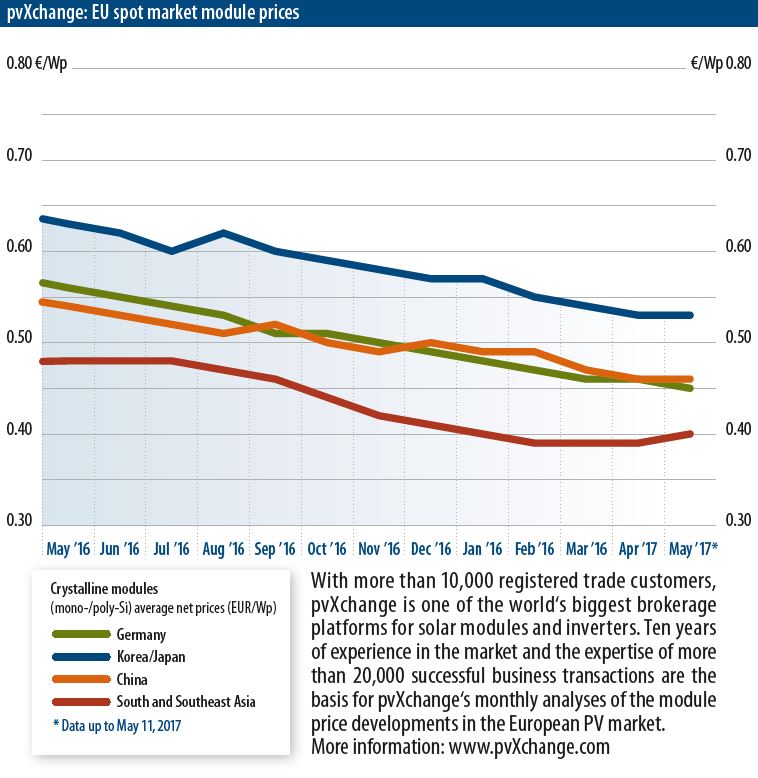 June 2017: An occasion to celebrate… or is it?
June 2017: An occasion to celebrate… or is it?
Module price index: SolarWorld is broke! At least one of the best known international solar companies in Germany has filed for the initiation of insolvency proceedings. “Can it be?” say some, “It’s about time!” say others, and they are in the majority. The latter are basking in schadenfreude and most of all, relief.
I personally could not decide if I should celebrate or mourn the loss. Of course, I am an opponent of the partitioning of the U.S. and European Solar markets initiated by Frank Asbeck and SolarWorld through punitive duties on Chinese cells and modules. Nevertheless, I am not yet sure if the failure of the self-proclaimed sun king is really a reason to celebrate.
Yet another high-profile bankruptcy at a time when the market is just starting to pick up again is likely to hurt the reputation of the industry. There are still hard-headed people who doubt the success story of renewables, and will do whatever it takes to undermine it. For these people, such a bankruptcy is a godsend. They will claim that at the expense of the public, an industry that cannot survive on its own has been propped up until its demise was finally inevitable. This is of course complete nonsense. By clinging to old structures and business concepts, Asbeck has no one to blame but himself for his company’s fate. It is not hard to find alternative scenarios at other pioneering German solar firms, which are now well-positioned on the international market.
In my opinion, there are now two possible scenarios for the European and U.S. solar industries: the “tough get going!” scenario and the “chalk it up to experience and drive on!” scenario. Asbeck and like-minded entrepreneurs are now starting to lash out wildly, demanding even more protectionist measures (even though they have not really had any effect) to drag even more companies, such as suppliers and sales partners, down into the pit. Suniva, which recently went bankrupt, has been an adherent of the “tough get going!” faction. The company is suing in the USA for import tariffs on solar components and a world-wide minimum import price for modules of $0.78. If it manages to push this through, it would be the coup de grace for the North American solar industry.
It seems easier to empathize with the “chalk it up to experience and drive on!” scenario. Now that the Asbeck era is drawing to a close, there are scarcely any advocates of anti-dumping tariffs and other market restrictions. Once again, market price will be determined by supply and demand and no longer by protectionist measures. Most European manufacturers produce where cost-efficiency is most favorable anyway; in Asia. Solar components will have an ever-diminishing share of the total value of an energy generation and distribution system. Good engineering, maintenance, and optimization will increase in importance. These are services that can only be provided on-site and not outsourced to Asia.
What is going on beyond the headlines? Prices for c-Si modules in Europe continue to hold steady around the €0.40 mark or slightly higher. The local market has stagnated somewhat in the first quarter due to the weather. In April, everything seemed to fall into place, installation figures have been rising steadily, particularly for small and medium-sized systems. Even the slightly falling feed-in tariffs coming soon to Germany will not stand in the way of this trend. The comparatively high installation figures in November and December caused by one-off effects (EEG adjustment in January) have again triggered the mechanism laid down in the EEG. In other European countries, like France, new incentives and the success of political moderates will likely also spur positive development.
It will be exciting to see what happens to price and market development after the third quarter of this year. It appears that the current stagnation in module prices is only superficially the result of a shortage. In reality, many players in the industry are expecting a global price decline in the third or, at the latest, in the fourth quarter of the year. The expectation is based on the rationale that demand for modules in China will dwindle, which in the past has always been observed at the end of the year. In order to start the price war at the highest possible starting value, many manufacturers are currently trying to maintain the highest prices possible. We will have to wait and see if this assessment pans out.
Martin Schachinger, pvXchange.com
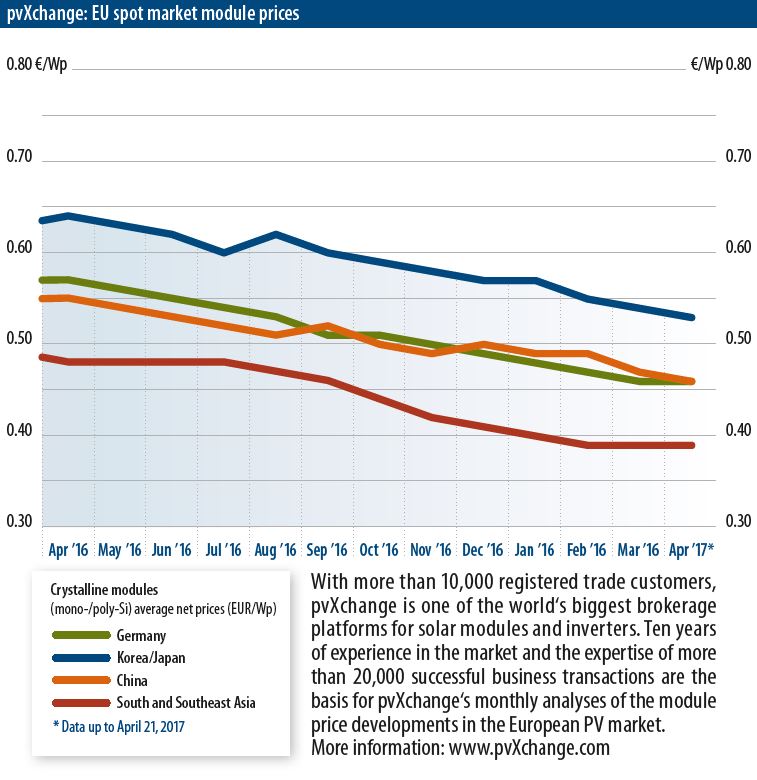 May 2017: Two-class society
May 2017: Two-class society
Module price index: Due to a leap in demand in early March isolated supply bottlenecks have actually even nudged prices upward, at least for panels from tier-1 manufacturers available on short notice. Delivery times of one to two months for higher performance classes exceeding 265 Wp are currently not out of the ordinary. Only those who have planned ahead and concluded a delivery agreement with a trusted manufacturer can afford to sit back. Seat-of-the-pants outfits will either have to wait or hope that inventories are freed up.
Installers who think they can simply fall back on cheap monocrystalline modules of a lower performance class are headed for a rude awakening. Neither the supply, nor the price is favorable at the moment. Apart from the fact sub-270 Wp monocrystalline modules are scarcely available on the European market anymore, the price difference between them and their polycrystalline counterparts with the same output is 4 to 8 euro cents per Watt-peak, which at current price levels is 10 to 20%. Scarcely anybody is willing to shell out this extra cost. Somewhat more relaxed is the current supply situation for polycrystalline modules up to 265 Wp, in particular products of lesser known brands.
As recently as two years ago, the demand for monocrystalline modules, even for large-scale commercial PV plants, was definitely noteworthy. Some, especially Chinese manufacturers, provided only this type of cell because customers were still willing to pay above the minimum import price of 53 to 56 euro cents per watt-peak for the monocrystalline varieties. However, the price for polycrystalline modules of the more prestigious manufacturers at that time were just a bit lower. But since the price collapse in the middle of last year, the gap between the prices for these technologies is widening. Module manufacturing costs, still largely dictated by cell prices, cannot be discounted at the same rate, making monocrystalline modules very uncompetitive in the reawakening volume market.
This module variant continues to be attractive only at performance classes that polycrystalline modules have not achieved yet. This efficiency range is now dominated by the PERC technology, for which module outputs of 300 Wp in a standard module with 60 cells is not problem anymore. Also, the increase in the number of cell connectors from three to four, five or even more bus bars, as well as other semiconductor doping methods or heterojunction technology make it possible to boost cell, and thus module, performance. The price war with ever-cheaper polycrystalline products is still an uphill battle, however. For instance, high performance modules are increasingly serving a market niche, which demands these fine pedigree products for reasons of limited space or visual requirements. The mass market, in particular the project business, is increasingly embracing inexpensive polycrystalline modules.
Although numerous manufacturers are making the foray into Poly-PERC technology, few have dared to launch their products on the market. On the European market such products are only available from a few providers, including Hanwha Q-Cells and REC Solar. Many manufacturers are still working feverishly to improve the persistent problems of mechanical stability and output stability. There are known cases in which initially above-average performance of polycrystalline modules has dropped by up to 10% on average just a few months after delivery. No manufacturer wants to face the resulting wave of complaints, which means that for the time being the high-performance module market will continue to be the dominion of monocrystalline modules.
SolarWorld announced recently that it would gradually reduce its product range of polycrystalline modules to completely specialize in high performance monocrystalline modules. Even now, the manufacturer offers a wide range of standard modules, glass-glass and bifacial modules with monocrystalline PERC cells. In so doing, this manufacturer, like others that follow in its footsteps, will veer away from the mass market, over the medium term, and into a niche. Whether this niche is big enough to accommodate many different, primarily European, Japanese and Korean manufacturers is doubtful. New, more all-encompassing product concepts are needed, but you still need a magnifying glass to find them.
Martin Schachinger, pvXchange.com
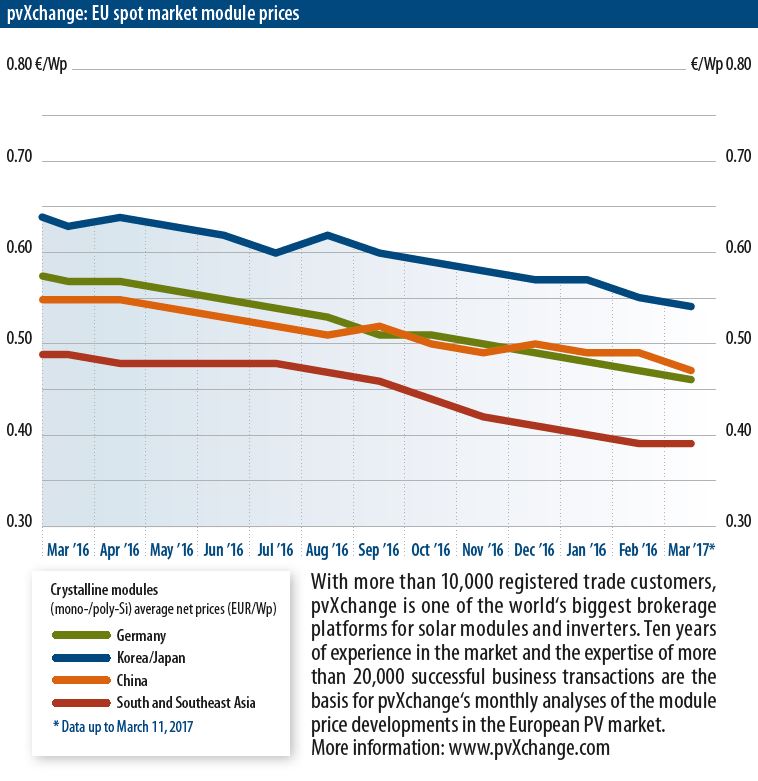 April 2017: Season off to a false start? Not necessarily…
April 2017: Season off to a false start? Not necessarily…
Module price index: The European photovoltaics market has not yet lived up to the expectations many observers had for it after the strong increase in installation figures in November and December 2016. Although there has been an overall revival by comparison to the first quarter of last year, the market has still failed to really take off. The weather cannot really be the root of the problem — the winter has been and continues to be very mild. But it cannot be down to module prices either, as these continue to fall, albeit more slowly, but continuously and on a broad front. Except for the prices of Chinese crystalline modules, prices in every other category have fallen at least 1.0 euro cent per watt-peak from January to February – although, they have rebounded somewhat in March.
Why is it, then, that the rate of PV expansion is seeing such slow growth? Should we concede to the view of Milan Nitzschke, of EU Prosun, who continues to maintain that market development has nothing to do with the price of panels and claims that the high minimum import price imposed by the EU commission is not harmful to the industry? The strong gains at the end of last year, so the story goes, were the result of a last-minute panic prior to the amendment of the German Renewable Energy Act (EEG). I maintain, however, that that is precisely why the installation figures have not exploded yet.
The players in the industry need time to get used to the new regulations and adapt their business models. Revised versions of the EEG never provide acceptable preparation time or planning security due to the numerous corrections usually made to draft legislation right up to the last moment. Existing concepts and pre-developed projects have to be adapted to the new conditions, for instance, before a company can think about building them. In the current case, it is the inclusion of all roof installations above 750 kilowatts in the tender process, and freeing up of open areas on this scale that is creating plenty of work for designers.
However, given attractive module prices, numerous solar companies are building a respectable project pipeline, which can be worked off over the coming months. Companies are continuously seeking and comparing offers for material for those projects, even though the actual delivery dates are not even scheduled yet. In view of the still volatile prices, hardly anyone wants to make a long term commitment, which is not making forecasting and planning any easier for suppliers. Nevertheless, the order books are filling up, which is cause for optimism in the German and European photovoltaic markets in general.
In many companies and larger O&M service providers, the annual maintenance season has also begun. After the winter many installations have to be inspected, cleaned and defective modules replaced. Since many of the module types used are no longer produced, procuring a suitable replacement is not always easy. Certain providers can supply identical or similar products, but often only in limited quantities and at prices many times higher than the current market price. Particularly at the now low price levels, more and more operators are opting for a complete overhaul; that is, getting rid of all of the old modules and installing the latest generation of crystalline modules.
This is also true of PV systems installed just a few years ago with thin film panels that now have yields 15 to 20% below the anticipated value. Unfortunately, the module manufacturers are only liable in a scant few cases, since many of them filed for bankruptcy years ago. Often, the only option left for operators is a complete rebuild at their own cost. What until recently was not feasible economically is at today's module prices worthy of consideration. In favorable circumstances, so-called “re-powering” of a PV plant can pay off in just a few years for plants with a relatively high feed-in tariff that still valid for a long enough time.
Martin Schachinger, pvXchange.com
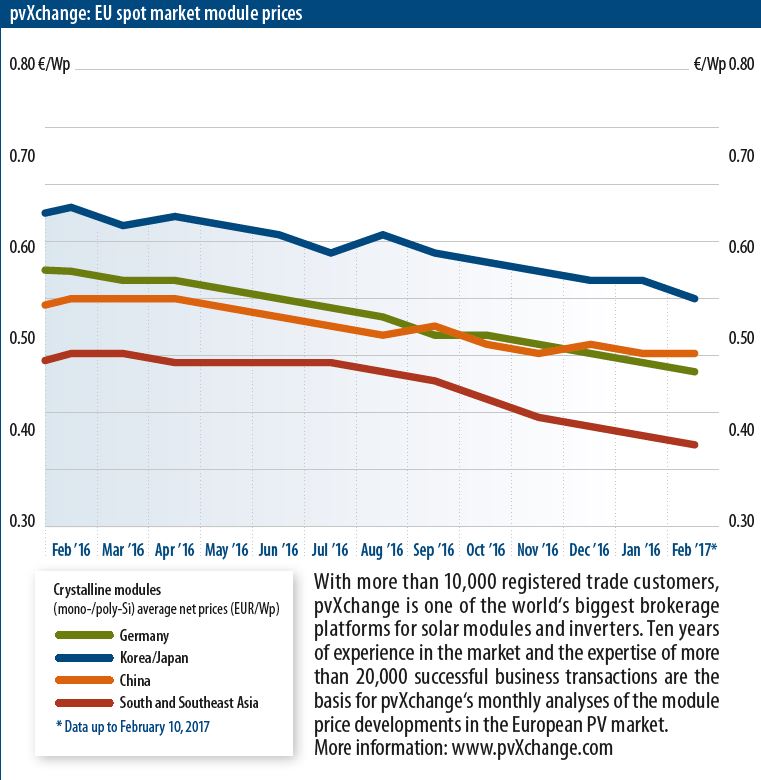 March 2017: China first!? – Make Photovoltaics great again!
March 2017: China first!? – Make Photovoltaics great again!
Module price index: Donald Trump's pronouncements and platitudes are on everyone's lips these days – they are frequently quoted, misquoted and lampooned, and always met with a healthy portion of dark humor. But Trump’s utterances can also be very pithy and can reduce the most complex issues to a few superficial words. Even ordinary citizens like you and I can understand him. But sometimes, such simplistic statements are right on the mark.
The European solar industry is apparently not so easily influenced by the new American strongman, even though some of Trump's words and actions are certainly cause for concern. But, luckily, the final word has not yet been spoken – not by a long shot – and positive developments are gaining traction. The construction boom in Germany, spurred by continuous price declines in recent months, continued unabated in January. At 600 megawatts-peak, the cumulative amount of additional construction in November and December amounted to nearly half of newly installed photovoltaic systems for the entire year. Both rooftop and ground-mounted systems alike saw a considerable increases.
There can be no doubt that the increase is due to highly favorable price developments for operators and installers. In the last quarter of 2016, module prices slumped across all regions of origin by up to 15 percent. But the price decline seems to have slowed somewhat and in January and February there were no major changes – at least for higher-quality modules. But some rack and inverter manufacturers have lowered their prices across the board, which has made complete PV systems available at historically favorable conditions.
The lowest prices ever recorded – at least since the beginning of module price monitoring and record keeping – have led to a strong increase in demand, as expected. That makes it all the more strange that the European Commission still refuses to budge on its market restrictions in the form of punitive tariffs. The EC has softened its original plan to keep the measures in place a further 24 months. The background is that the EU Member States called upon to vote two weeks ago rejected the restrictions with a simple majority, which unfortunately was not adequate to completely overturn them. Now a new proposal is on the table to shorten the extension of the existing measures, which have been in place since 2013, to 18 months and consider a “phased elimination” of the measures altogether, whatever that means.
Of course, there were immediate protests from minimum import price advocates from the camp of the manufacturer SolarWorld and the EU Prosun association. They argued that a longer duration was urgently needed to finally create fair competition and planning security for investments. The Commission Vice President Frans Timmermans countered, however, that the EU had to respect the interests of companies that depend on these imports to sell their products and services, companies that also employ thousands of people in Europe. Moreover, he said, solar energy was essential for the achievement of Europe’s environmental and climate-protection goals.
Obviously, some of the players in the industry either have not fully grasped China’s existence and role in the whole process or have ignored the fact in a negligent manner. Those who actually believe that the Chinese solar industry will allow itself, through isolation and punitive tariffs on Chinese-made products, to be deterred from dominating the market and winning the trade war is living a fantasy. It is simply part of the Chinese self-image to break through resistance, interpret rules as they see fit, and adeptly bypass rules that threaten economic disadvantage.
Experiences over the past three years with anti-dumping and anti-subsidy measures have shown how seriously Chinese cell and module manufacturers take this issue – and pangs of conscience: non-existent. Such restrictions entice the smaller companies not listed on western stock exchanges to exercise special creativity in disguising and bypassing EU measures, whereas the larger and more prestigious companies prefer to build and open production facilities all over the world whose output is not subject to import restrictions. Until we get over this, the European market will simply be left by the wayside – what a smashing success for us Europeans!
Such pedantry can never defeat an emerging global economic power like China or even constrain it for two or three years, as has been demonstrated. Even if the EU Commission hammers out some sort of lazy compromise solution, who cares? A workaround will be found. But probably not a single European manufacturer will survive thanks to these measures alone. But why waste time playing air guitar? Why not enter into a dialogue and work out deals that help both Chinese and European companies achieve equal measures of success? Accusations and prohibitions do nothing more than challenge the confident economic power of China to wage a trade war that we cannot possibly win. On the other hand, a good deal for both sides will make China an ally.
Martin Schachinger, pvXchange.com
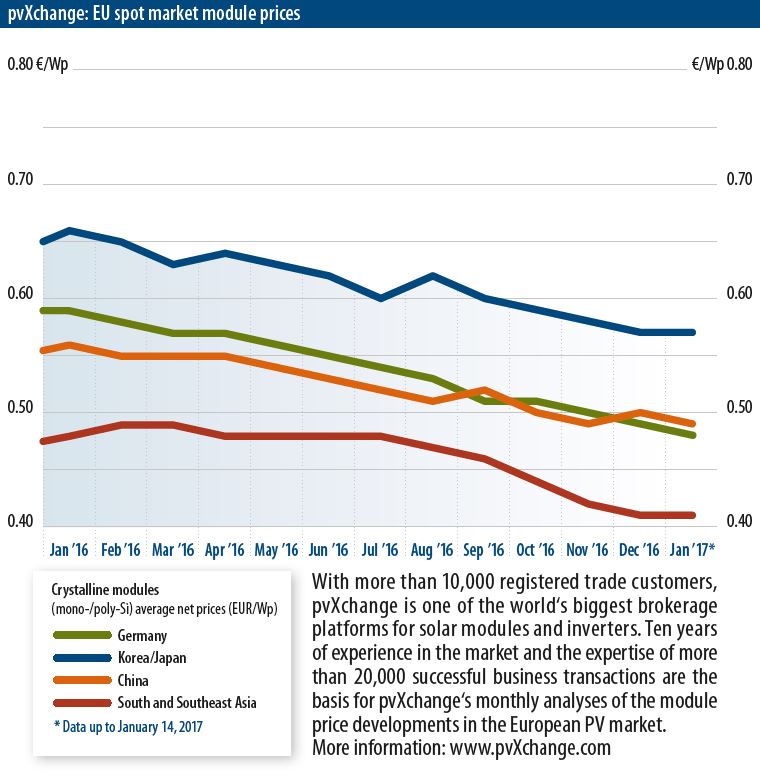 February 2017: Back to the old size – will 2017 be a super year for solar?
February 2017: Back to the old size – will 2017 be a super year for solar?
Module price index: Module prices are falling steadily, and the November installation figures in Germany already show an increase of around 50% over the previous month. While the exact figures are not out yet, December is also likely to deliver similarly positive results. The 1 GW mark may be slightly exceeded in 2016, which is likely thanks solely to the current drop in prices. However, following an across-the-board decrease in December by an average of 2% in nearly every region of origin, prices stabilized noticeably in January.
The jump in demand over the past few weeks has already prompted some manufacturers to report their first bottlenecks and supply problems. However, they should be able to take up the slack again in February, so customers will just need a bit of patience. Many orders had already been placed in December, even though the corresponding projects will not be completed until sometime in the first quarter of this year. For planning security reasons, master agreements are once again being negotiated. But because it is not entirely clear which direction module prices are headed, flexible price clauses are finding their way into these agreements – some suppliers and manufacturers are quite open to such practices. Buyers able to incorporate these clauses into their contracts should stipulate that the final price for each individual purchase should be dependent on the development of the market price relative to the negotiated price at the date of the signing. The reference for the adjustment should be a generally recognized photovoltaics price index.
But it is still difficult to provide a reliable forecast for all of 2017. Overall, the prospects for this year are very good, because there is pent-up demand, particularly for systems intended for German ground-mounted PV plant auctions. An increase in the EEG feed-in tariff is also expected in February. Although some analysts are still cautiously optimistic, all project a noticeable increase over last year's installation figures. The forecasts for the year ahead range from 1.4 GW in Germany to more than 2 GW. It is even possible that we could meet the German government target corridor of 2.3 to 2.5 GW, and thus at least double the expansion figure. For Europe as a whole, a solid increase is expected but will likely be a bit more staid because the United Kingdom's contribution to installed capacity will probably have little effect this year.
What else could have a negative impact on development? The European Commission is still clinging to its protectionist measures and its minimum import price for Chinese modules. However, the level of the minimum price going forward is still up in the air. It may be that the commissioners are simply succumbing to the pressure of individual actors but do not even believe anyone still cares about the measures. Chinese manufacturers have long since adapted to the situation and built up large production capacities in regions free of punitive tariffs. Only a radical tightening of the conditions could stem the comeback of Asian modules on the European market.
Punitive tariffs would have to be imposed on all products produced outside the EU. But that would deal a hefty blow to some well known European brands like IBC, REC, Luxor, Q-Cells and even SolarWorld. We can, therefore, expect that the big Chinese manufacturers will soon reconquer the European photovoltaics market. After dropping off the radar for the past two or three years, the tier-1 manufacturers Suntech, Trina and others – none of which are part of the undertaking – are piling back into the market with very attractive prices. Most notable among these are Hanwha Q-Cells, Canadian Solar and Jinko Solar, which have formulated ambitious sales targets.
A big downward move in prices is probably not on the cards, as that already happened in the last quarter. Prices for standard modules will initially cluster around the 40-cent mark, or perhaps slightly below that for high volume orders. But at that price level, nearly any type of project can be implemented economically – there is no longer any reason to hold off before starting a project. But this will ultimately bely the claims of proponents of EU punitive measures who have denied the connection between market price and market development, because political conditions in Europe have not changed fundamentally since last year.
Martin Schachinger, pvXchange.com
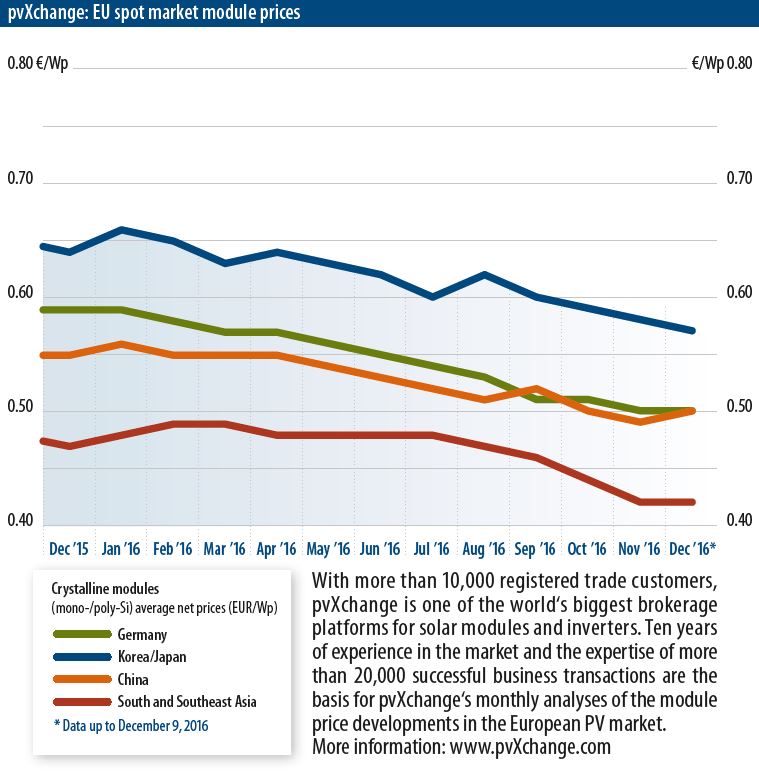 January 2017: Efficiency up, price down – more power for less cash in 2017
January 2017: Efficiency up, price down – more power for less cash in 2017
Module price index: After another sharp drop in November, prices for PV panels have generally stabilized in the first few days of December. Dealers seem to have woken up to the fact that even prices under €0.35/W are not enough of an incentive to make a purchase in the last few weeks of the year. PV plants that had to be built in 2016 have already been thoroughly planned and the materials purchased. And buying modules for projects coming up next year is not on the minds of many installers. Although conditions and prices are being carefully monitored, hardly anybody wants to commit in a market with such volatile prices. It is still unclear whether prices will continue to fall further, especially for panels in the higher performance classes. We have seen astonishing development in that segment over the past few months.
Availability of newly produced modules in the mid-range performance classes is drying up. Although 255, 260 and 265 W for modules with 60 monocrystalline cells was the general standard until recently, there is now a strong trend in the direction of 270 to 280 W. Up to now, however, this kind of performance could only be achieved by modules with monocrystalline cells which, justified or not, were then sold at a markup. Through the widespread use of PERC and PERT technologies in European and Asian module manufacturing, high capacities can now be achieved with polycrystalline, resulting in much cheaper cells.
Some manufacturers, such as Q-Cells, have announced the launch of polycrystalline modules that achieve output up to 290 or even 300 W, which will be available in the first quarter of 2017. The peak output of monocrystalline modules from the top manufacturers in Europe and Asia are already pushing 310 W and at lower prices than those offered by LG Electronics, AUO, BenQ and Panasonic, which until recently divided the market for ultra high efficiency modules amongst themselves. And how have these manufacturers responded to the trend for ever-higher performance at steadily falling prices? At Sunpower, at least in Asia and the United States, a large-scale consolidation phase is underway, which unfortunately has cost a lot of people their jobs. At the same time, Sunpower is gradually taking over joint cell production in Singapore, while AUO is investing more money and energy into the development of its own high-efficiency cells.
LG Electronics recently launched a 60-cell bifacial glass-glass module, which due to its active back panel can deliver up to 25% more yield in optimal conditions. The company says that the new solar panel can achieve peak performance of up to 375 Wp. In contrast to the now insolvent US manufacturer Solyndra, the company bases its price calculations on the maximum front-side output under STC of 300 Wp. There is so little variety and availability of glass-glass unifacial and bifacial modules that prices have not dropped under competitive pressure or high demand. The prices for products available on the market – products from companies like SolarWorld or Sonnenstromfabrik – are still trading above the €0.60 mark.
But other companies are constantly working to optimize the performance and efficiency of their modules. Through new contacting techniques and material combinations, efficiencies beyond the 20% mark will soon be commonplace. Due to the resurgence of heterojunction technology (HJT/HIT), efficiency improvement to up to 30% even appears to be within striking distance for industrially manufactured cells. Furthermore, light-induced degradation (LID), which used to be a standard variable in all simulation programs and economic feasibility calculations and on which performance specifications are based, could become a thing of the past through the transition to n-type solar cells. The near future is certain to hold some exciting developments and product launches.
Does it make sense in today’s market to sign supply agreements before year's end or even lay up goods in a warehouse that will not be installed until springtime, or would it be better to wait and see? Forecasting price developments for the near future is not an easy call right now. Some manufacturers are convinced that the market has found the bottom, and that module prices will rise slightly at the beginning of the new year. They are basing their claim on rising demand, particularly in Asia, in the face of supply bottlenecks. However, current unutilized capacities in China may be so vast that they can easily cover any uptick in demand, either domestically or in any market not saddled by restrictions. That would argue against any noticeable price rise.
People who want to equip their PV systems with highly efficient modules can afford to wait and speculate on ever-expanding product diversity and falling prices. The only ones who need to hurry are designers and installers whose projects have been collecting dust in a desk drawer in the hope of better times – for instance, the numerous yet-to-be-built systems from German ground-mounted plant tenders. Many of these systems were designed to use modules at the lower end of the efficiency spectrum. But the availability of such products, as already mentioned, is starting to wane, which does not exactly bode well for price development.
Martin Schachinger, pvXchange.com
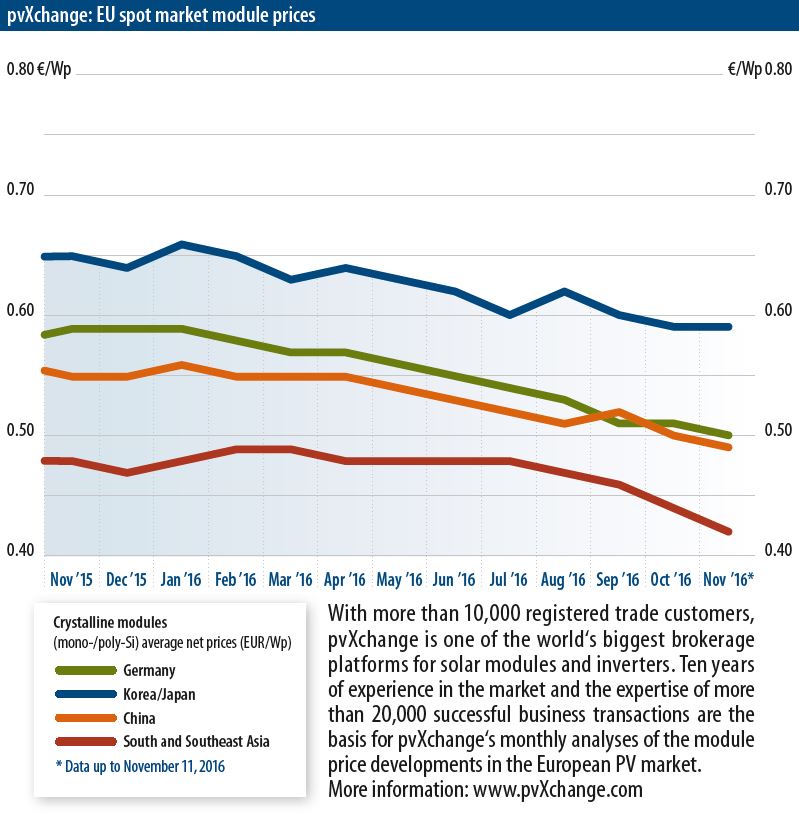 December 2016: Red light, green light
December 2016: Red light, green light
Module price index: Once again the market is running circles around the politicians. A look at current module price development makes this imminently clear. While the European Commission continues its brooding over the question of whether Chinese manufacturers are still engaged in price dumping and whether market protections are still justified, module and cell prices have long since reached a level that is as much as 30% lower than the minimum import price. Of course, effects such as year-end inventory clearance sales and overproduction in a faltering market again come into play, but even most European manufacturers are adapting to the general trend without complaining, and reducing their module prices month after month. But where's the bottom? That is a question dividing the various stakeholders and analysts. In any case, prices continue to fall, particularly for high-performance modules.
A continued decline in prices without any significant rise in installation figures in the German and European markets is expected in the final months of 2016. However, a more or less significant uptick in the market is projected for 2017, in Germany at least. Prices are expected to stagnate or rise slightly before gaining traction. The industry will have to adapt to the expected final draft of Germany's Renewable Energy Act (EEG) 2017. The final draft has been approved by the European Commission with regard to the new rules for tender procedures, which means that no more pushback from Brussels is expected. A boom in commercial-roof and ground-mounted systems up to 750 kWp is expected, since there is no tender obligation. Although EEG feed-in tariff levels for PV systems will initially remain unchanged in January, the adjustment mechanism has been adapted to react more quickly to changes in the market.
Remember that the EEG 2014 specified a gross expansion corridor of 2,400 to 2,600 MW per year and a monthly degression of 0.5%. The review and reference time-frame was 12 months. In the event that the corridor was exceeded by more than 900 MW, the feed-in tariff degression would increase to 1.4%. The rates would remain the same if less than 1.5 GW (2,400 minus 900 MWp) were installed. By the way, we have been in this mode since the fourth quarter of 2015. According to the old EEG, rates did not really start to climb until new installations fell short of the 1 GW mark (2,400 minus 1,400 MWp). In the EEG 2017, the reference period has been shortened to eight months, and the steps have also been reduced. According to the new scheme, feed-in tariffs will be eligible for a rise of up to 3% per month after 1 February 2017 – a positive prospect indeed, and a solid support for the market growth desired.
Far less positive is a recent report that the European Commission's Director-General for Energy is planning to eliminate the feed-in priority for photovoltaics and wind power in the new renewable energy directive. If this rumor turns out to be true, it would be a yet another crushing blow to renewable energy. Renewables would have to compete directly with conventional power plants, which could result in a renaissance for coal and nuclear power in Europe. That would be a sure way to torpedo the European climate targets and miss them by a mile. Such a profound lack of understanding of the necessary consequences of one's own actions and depth of ignorance about the climate protection efforts of the member states is hard to imagine, even in Brussels.
For a while it looked as if the German environment minister Barbara Hendricks would fly to Morocco for the COP 22 Global Climate Change Conference without any concrete climate protection plan. Now, the German government seems to have gotten up to speed at the last minute and agreed on a common formulation. Nevertheless, the result cannot be regarded as anything less than a lazy compromise because there are still far too many concessions to business interests and no concrete date for pulling the plug on coal. The erstwhile front-runner of climate protection has become a tired old nag. That will be sure to trigger a few discussions and fuel plenty of misunderstanding with regard to the challenges that lie ahead. How clear do the signs have to be, how great the emergency before political elites are ready to follow up their high flying talk with meaningful action?
Martin Schachinger, pvXchange.com
November 2016: Red light, green light
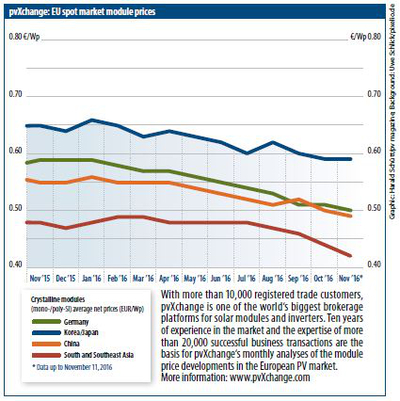 Module price index: The market is once again running circles around politicians, with Europe particularly leaden-footed.
Module price index: The market is once again running circles around politicians, with Europe particularly leaden-footed.
While the European Commission continues its brooding over the question of whether Chinese manufacturers are
still engaged in price dumping, module and cell prices have long since reached a level that is as much as 30% lower than
the minimum import price. Of course, effects such as year-end inventory clearance sales and overproduction in a faltering
market again come into play, but even most European manufacturers are adapting to the general trend without complaining, and reducing their module prices month after month. But where’s the bottom line? That is a question dividing the various stakeholders and analysts. In any case, prices continue to fall, particularly for high-performance modules.
A continued decline in prices without any significant rise in installation figures in the German and European markets is expected in the final months of 2016. However, a more or less significant uptick in the market is projected for 2017, in Germany at least. Prices are expected to stagnate or rise slightly when the market gains traction. The industry will have to adapt to the expected final draft of Germany’s Renewable Energy Act (EEG) 2017. According to the new scheme, feed in tariffs will be eligible for a rise of up to 3% per month after February 1, 2017 – a positive prospect indeed, and a solid support for the market growth desired.
Far less positive is a recent report that the European Commission’s Directorate General for Energy is planning to eliminate the feed-in priority for PV and wind power in the new renewable energy directive. If this rumor turns out to be true, it would be yet another crushing blow to renewables. They would have to compete directly with conventional power plants, which could result in a renaissance for coal and nuclear power in Europe. That would be a sure way to torpedo the European climate targets and miss them by
a mile. Such a profound lack of understanding of the necessary consequences of one’s own actions and depth of ignorance about the climate protection efforts of the member states is hard to imagine, even in Brussels.
For a while it looked as if the German Environment Minister Barbara Hendricks would fly to Morocco for the COP 22 Global Climate Change Conference without any concrete climate protection plan. Now, the German government seems to have gotten up to speed at the last minute and agreed on a common formulation. Nevertheless, the result cannot be regarded as anything less than a lazy
compromise. The erstwhile front-runner of climate protection has become a tired old nag. That will be sure to trigger a few discussions and fuel plenty of misunderstanding with regard to the challenges that lie ahead. How clear do the signs have to be – how great the emergency before political elites are ready to follow up their high flying talk with meaningful action?
Overview of new price points for October 2016 with changes indicated:
Module Class | Price (€/Wp) | Change comp. with previous month | Description |
High Efficiency | 0.60 | -3.2% | Crystalline modules 275 Wp and above with PERC, HIT, n-type or back-contact cells, or combinations thereof |
All Black | 0.54 | -1.8% | Module types with black back sheets, black frames and a rated power between 190 Wp and 270 Wp |
Mainstream | 0.46 | -2.1% | Modules typically with 60 cells, standard aluminum frame, white backsheets and 245-270 Wp, represents the majority of the modules on the market |
Low Cost | 0.34 | +3.0% | Low-output modules, factory seconds, insolvency goods, used modules (crystalline), products with limited or no warranty |
The prices shown indicate the average asking prices for duty-paid goods on the European spot market for the month of October 2016.
Author: Martin Schachinger, pvXchange GmbH
October 2016: Price slide continues
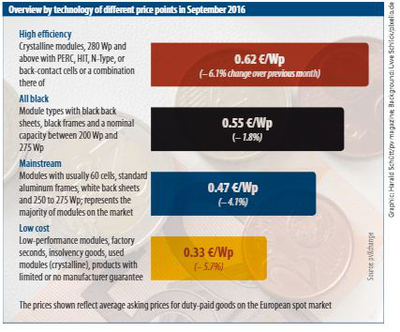 Module price index:Prices down and installation numbers up – will we turn the corner?
Module price index:Prices down and installation numbers up – will we turn the corner?
The slide in prices that began last July across all types of module from every region is gathering momentum. Chinese products were the one exception to this trend in September. But in early October even they succumbed to the downturn. Project prices are increasingly dipping below the €0.40 mark. Even volume pur-chases from European manufactures are not far from this, though average prices in the index are significantly higher. Bro-ken down by module technology, high-efficiency panels of 280 Wp and more currently show the most pronounced price dynamics.
This development has triggered specu-lation about whether we are experiencing a new trend in the PV market. Will solar in Europe quickly return to its former size? On that question, both camps in the photovoltaics trade dispute – proponents and opponents of the EU’s regulation measures – still harbor wildly divergent opinions. While the SolarPower Europe industry association is convinced that the lull in new installations is due to the minimum import price, the EU Prosun association sees the cause in misguided industry policy. Falling prices would not automatically result in market growth, which is evident from the continued stag-nation, it says.
“We have experienced a 20% drop in module prices since July, without any resulting market growth. The reason for the reluctance to invest is not price, but political instability. Member states have cut subsidies or even introduced sur-charges on solar power. Another fac-tor is the artificial limitation of system expansion through restrictive tender processes,” says Milan Nitzschke, the spokesperson for EU Prosun.
But the supposed 20% price drop over the past two months that Nitzschke alludes to is not reflected in the price index. Depending on the region of ori-gin, prices for Asian modules between March and September have fallen 5-8%, at most. Astoundingly, products from German manufacturers are an excep-tion, currently a full 10% cheaper than they were half a year ago.
The price slide has really picked up steam over the past month and is sure to continue through to the year’s end. We might still break the 20% mark in December when compared with prices from the beginning of the year.
But why does demand in Europe con-tinue to be so tame? Do prices really play as critical a role as EU Prosun would have us think? In my view, lower prices and the associated new opportunities for return on investment have not materialized yet. First, offers have to be recalculated and formulated. Experience shows that it also takes time for end customers to make a purchasing decision based on the revised offers. Added to that is the fact that sum-mer ended abruptly in Europe at the end of September. The cold, drizzly weather that has prevailed since is scarcely con-ducive to frenzied construction of solar power plants.
Furthermore, the unchanged EEG feed-in tariff in Germany creates little pressure to complete projects by the end of the year. To the contrary, operators would throw away nearly an entire year of a guaranteed feed-in tariff by installing their systems in November or December, rather than waiting until January. Even the winners of the first round of PV ten-ders, who have postponed implementing their projects due to high prices, have little incentive to start construction this year. They will wait and see what happens to module prices while taking all neces-sary steps to ensure that their systems are commissioned punctually by April 2017.
For this year I expect at best a slight increase in installation figures. Manu-facturers and wholesalers will offer their products with additional discounts to avoid starting the new year with excessive warehouse inventories. Some of the big Chinese manufacturers will again turn up their pressure on the market since they have, almost without exception, left the undertaking while at the same time ramping up production capacities out-side China. This is sure to make 2017 an interesting year. In my view, there is no question that we will return to noticeable market growth within Europe. However, it is difficult to predict what growth rates in the individual countries will be – I’d be happy to take bets on that question. My tip for Germany: 2 GW in 2017, which represents 100% growth over 2016. This is mostly on the back of this year’s weak figures!
Author: Martin Schachinger, pvXchange GmbH
September 2016: The price war begins
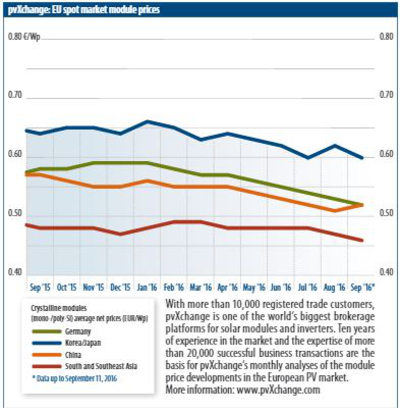 Module price index:Across most of the globe, module prices have plummeted as the industry comes out of a strong manufacturing period.
Module price index:Across most of the globe, module prices have plummeted as the industry comes out of a strong manufacturing period.
The downward trend in module prices over the past few months has held steady in August. The only outliers in the down-ward slide were modules from Japan and South Korea, with average prices slightly above the €0.60 ($0.67) mark. Trend lines for products from China and Europe are once again converging, but at a level some 10% below that of last year. These mod-ules cost an average of €0.52 ($0.58) per watt in August. The modules surveyed span a price range of €0.45 ($0.50) to €0.65 ($0.72) for Chinese products and €0.49 ($0.54) to €0.73 ($0.81) for German goods.
The most recent minimum import price of €0.56 per watt negotiated between the EU and Chinese manufac-turers appears to have completely gone out the window. Now that they are free from the burden of restriction, Asian manufacturers appear to have slipped casually back into their low-price poli-cies. The continued punitive tariffs lev-ied on modules manufactured in China are no great annoyance to these corpora-tions, since nearly all of them now oper-ate cell and/or module production facili-ties outside of their home country and are therefore not impacted by the penalties.
Up to now, the average price spread for the year between European and Chi-nese products has been €0.02, However, German manufacturers Aleo, Heckert and Solarworld almost simultaneously slashed prices in the first weeks of Sep-tember. They justified the reduction cit-ing lower global market prices for cells on the one hand, and general overpro-duction on the other. The latter is under-standable with the loss of the U.K. market and significantly slower expansion rates for PV elsewhere, however we could not confirm a drop in cell prices.
Thus, a steadily escalating price war at every level of the value chain is on the cards. The first manufacturers are already surging ahead and others will have to rush to follow suit. Big Chinese manufac-turers have taken up their positions and will not yield ground to European competitors without a fight. Some manufac-turers could offer discounts in the range of 10% – in some cases these are already in the works. In any case, fairer mar-ket prices will give the European solar industry a boost, as long as the players can manage to pass on the low wholesale prices at least in part to their customers.This raises the question of what justi-fies continued market restrictions against China if all of the manufacturers beyond a certain size are now in a position to unload modules for significantly less than €0.50 ($0.56), 20% under the cur-rently applicable minimum import price?
At least one thing seems certain: The protectionist measures of the EU are hav-ing less and less effect. It will be inter-esting to see the upshot of the European commission’s review of the policy, and what new regulations Brussels will come up with to avoid scrapping the whole thing. Perhaps we will soon celebrate a new minimum import price of €0.46 for all non-EU modules – a comfortable level for the remaining European manufacturers.
Overview of new price points for August 2016 with changes indicated:
Module Class | Price (€/Wp) | Change comp. with previous month | Description |
High Efficiency | 0.66 | -2.9% | Crystalline modules 275 Wp and above with PERC, HIT, n-type or back-contact cells, or combinations thereof |
All Black | 0.56 | 0.0% | Module types with black back sheets, black frames and a rated power between 190 Wp and 270 Wp |
Mainstream | 0.49 | -2.0% | Modules typically with 60 cells, standard aluminum frame, white backsheets and 245-270 Wp, represents the majority of the modules on the market |
Low Cost | 0.35 | +2.9% | Low-output modules, factory seconds, insolvency goods, used modules (crystalline), products with limited or no warranty |
The prices shown indicate the average asking prices for duty-paid goods on the European spot market for the month of August 2016.
Author: Martin Schachinger, pvXchange GmbH
August 2016: What counts …
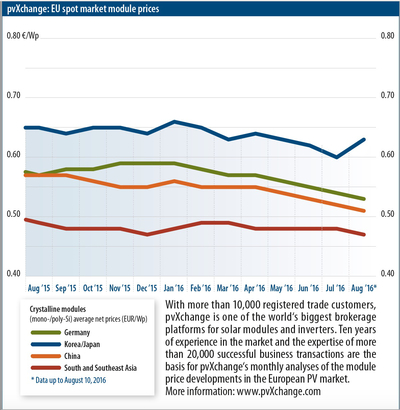 Module prices: In an overall quiet market characterized by the onset everywhere of summer vacation, module prices generally declined in July. Prices for European and Chinese modules were in a neck-and-neck race to the bottom, and even reached a low for the year.
Module prices: In an overall quiet market characterized by the onset everywhere of summer vacation, module prices generally declined in July. Prices for European and Chinese modules were in a neck-and-neck race to the bottom, and even reached a low for the year.
To complete the unfinished sentence in the headline, I’ll allow my self a small digression. Every one of us makes purchasing decisions every day. These affect our future life; sometimes more, sometimes less. We apply a standard to the offers made to us, a standard derived from our experience and expectations. The more diverse the offers are, the more difficult and lengthy the selection process is. A lack of information can also make the decision difficult. Ultimately, the gut plays a decisive role in many of our decisions.
Let’s apply this simple wisdom to the module market. Although the diversity on offer has become much smaller than it was even just a few years ago, it is still hard to get one’s head around. The information we get about the products, however, is usually fairly paltry and highly influenced by the sales ambitions of the purveyor. Often, even the origin of the modules and their composition (cell quality and origin) are scarcely discernable. You can trust the manufacturers’ information, or not. The current situation of market restrictions and MIP has provoked sellers to mask the origin of materials.
Another key point is product quality, which also depends on origin. If the origin is unknown, judging quality is reduced to a crapshoot. Buyers who do not check this themselves, but instead trust manufacturers’ guarantees, are naive. So many apparently solid producers have already overstepped boundaries, making their warranties worth little more than the paper they are printed on. Even random testing of every delivery has failed to protect buyers from surprises. Nevertheless, meticulous visual inspections and performance testing at least provide a minimal measure of assurance.
Should a problem with a purchased and installed product crop up in the future, the presence of a solid warranty is desirable. But this is only true in two instances: either the manufacturer still exists and has a European branch office, or the buyer has purchased warranty insurance. Unfortunately, false information about insurance leads to mistakes, which can bring disappointment when trouble strikes. The insured party must always be the owners of PV systems themselves. Insurance drawn on insolvent manufacturers is worthless. Larger systems should therefore be insured directly and comprehensively. One indicator of the solidity of a manufacturer is the bankability of its products. Caution is advised with non-bankable products.
Without binding information, it is impossible to make a decision. The variety of products on the market is a high-stakes gamble with potentially big losses. For instance, if presumably MIP-free modules actually come from China after all, buyers may risk criminal charges. In any case, the punitive tariff would have to be paid retroactively, regardless of the channel used to acquire the panels.
Chinese firms now lead the list of tier-1 manufacturers, a collection of the most solid and financially strong PV producers in the world. Combing through the few surviving European producers reveals that most of them, even those that still produce, have just a few years left at best, even with the continuation of MIP. Technologically, Asian manufacturers no longer have to hide behind their American or European competitors, thanks in no small part to the intentional or unintentional knowledge transfer over the past few years.
But how can buyers tell if the price is right? Simple: they follow the monthly price index, which in addition to information regarding origin also takes technological differences into account. An offer for modules with a price that falls below the average price in the index can be considered a bargain. If all of the other factors, such as module efficiency, quality, and security are also above average, a buyer can make a purchase in good conscience.
Having thought this through and put it down in writing, I now wonder how the results of the recent installer survey can be arrived at. Supposedly, more than half of all of the European installers are in favor of extending the MIP regulation if subsidies artificially hold down the price level of Asian products. That would mean that the majority of those surveyed are in favor of a worse cost-benefit ratio, take the risk of a greater chance of product failure, and are willing put their own existence on the line! Come again?
Overview of new price points for July 2016 with changes indicated:
Module Class | Price (€/Wp) | Change comp. with previous month | Description |
High Efficiency | 0.68 | +1.5% | Crystalline modules 275 Wp and above with PERC, HIT, n-type or back-contact cells, or combinations thereof |
All Black | 0.56 | +1.8% | Module types with black back sheets, black frames and a rated power between 190 Wp and 270 Wp |
Mainstream | 0.50 | -2.0% | Modules typically with 60 cells, standard aluminum frame, white backsheets and 245-270 Wp, represents the majority of the modules on the market |
Low Cost | 0.34 | -5.6% | Low-output modules, factory seconds, insolvency goods, used modules (crystalline), products with limited or no warranty |
The prices shown indicate the average asking prices for duty-paid goods on the European spot market for the month of July 2016.
Author: Martin Schachinger, pvXchange GmbH
July 2016: Pimp my PV
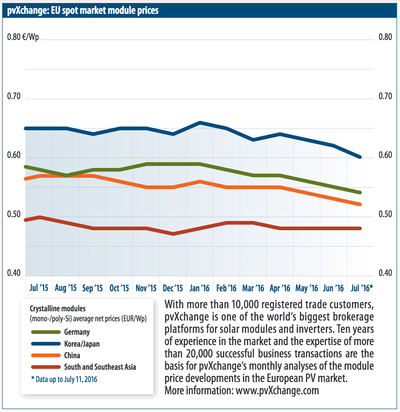 Module prices: New installations not on the cards? Then at least tune up the existing systems! Retrofitting storage systems to arrays is a lucrative business, as is site expansion.
Module prices: New installations not on the cards? Then at least tune up the existing systems! Retrofitting storage systems to arrays is a lucrative business, as is site expansion.
The market for new systems in Europe has all-but flatlined, and slowly sinking prices of PV panels has done little to change that. But there is a way out! I'll get into that later. First, let's get back to price development: as indicated in recent months, prices for modules from Germany, Europe, Japan and Korea, as well as those from Chinese factories, are slowly converging toward the level of Southeast Asian modules, whereas prices for the latter seem to be set in stone. It's tempting to think that we've hit bottom; a market price that cannot go any lower.
That is not the case, but understanding why requires knowledge of what goes into the price index figures. The average values for Southeast Asian modules contain not only prices for Taiwanese, Vietnamese, and Chinese brands with local production facilities, but also increasingly prices for German brands produced in the region. Modules from German brands are usually offered at higher prices. These brands can also show up in several categories of the price index if the companies produce modules in both Europe and Asia. This can make market prices for Southeast Asian modules somewhat deceptive, whereas modules that are actually manufactured in Germany appear to get cheaper and cheaper.
The desolate state of the PV market is not likely to change anytime soon. Its fate has been sealed by, among others, members of government in Berlin who waved through a half-hearted revision of Germany's Renewable Energy Act (EEG) without any major opposition. One wonders why it is so hard for policy makers to back their own announcements and policies with a suitable legislative framework to ensure that the targets they have set can be met in the scarce remaining time available. Instead, they buckle in the face of the conventional energy sector and slow the pace of progress. The PV industry is once again confronted with the sad realization that the political will is lacking for a return to the expansion corridor of 2.5 GW per year in Germany.
Consequently, reactions to the revised EEG, which will take effect in 2017, have been mixed. A change that met with broad approval was improved support of tenant-PV models through the reduction of the EEG surcharge, which will pave the way for new business models. As anticipated, cuts in PV and wind power through expansion of the tender and a concurrent reduction of tender volume have been rejected.
What remains for PV professionals? If installed capacity cannot be increased significantly in the foreseeable future, solar professionals will have to resort to increasing the energy yield of existing PV systems. Existing systems represent a segment that goes well beyond simple service and maintenance tasks. Let's think about retrofitting storage systems, particularly for PV plants installed between 2010 and 2012 – a highly attractive business. In many cases, expanding systems is also worthy of consideration, particularly in areas where the grid connection capacity has not yet been reached and/or direct consumption is possible. Perhaps most promising is seeking out so-called distressed systems, and then repairing and optimizing them.
A distinction should be made between repowering and refitting. The latter describes the restoration of the proper, expected functionality; for instance, by reworking the substructure or wiring concept without interfering with the actual array capacity. If, however, aging modules and inverters are replaced by the latest high-performance models, this is repowering, a term borrowed from the wind industry. In the latter case, it is advisable to follow the letter of the law to avoid a potentially nasty surprise in the form of lost feed-in payments or even the withdrawal of a feed-in permit. There is still much to do, so let's get to work!
Overview of the newly introduced price points in June 2016 including changes
Module Class | Price (€/Wp) | Change comp. with previous month | Description |
High Efficiency | 0.67 | +1.5% | Crystalline modules, 275 Wp and above with PERC, HIT, N-Type, or back -contact cells or a combination thereof |
All Black | 0.55 | -3.5% | Module types with black back sheet, black frame and a rated power between 190 Wp and 270 Wp |
Mainstream | 0.51 | 0.0% | Modules with usually 6o cells, standard aluminum frames, white back sheets and 245 to 270 Wp; represents the majority of modules on the market |
Low Cost | 0.36 | -5.3% | Low-performance modules, factory seconds, insolvency goods, used modules (crystalline), products with limited or no manufacturer guarantee |
The prices shown reflect average asking prices for duty-paid goods on the European spot market in the month June 2016.
Author: Martin Schachinger, pvXchange GmbH
June 2016: Waiting in vain
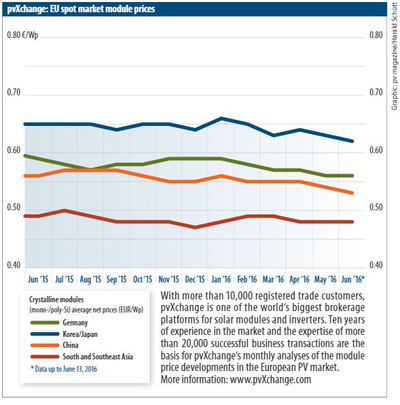 Module prices:Will the EU market revitalize itself? And if not now, when? The wait is interminable as installation figures and order volumes decline, and further strands tangle the China-Europe pricing impasse with each passing day.
Module prices:Will the EU market revitalize itself? And if not now, when? The wait is interminable as installation figures and order volumes decline, and further strands tangle the China-Europe pricing impasse with each passing day.
Module prices from all regions and in nearly every product class are below those of the previous month, and it looks as if this trend will continue in June. An oversupply in the European market is gradually building, which is becoming apparent through price reductions on a broad front. Chinese suppliers are being proactive about influencing the market with the means at their disposal. On the one hand, inexpensive modules in ever higher performance classes are crowding in: 275-280 Wp 60 cell modules are no longer a rarity. On the other hand, polycrystalline products in the lower perfor-mance classes from China are increasingly finding their way to Europe. Their origin is no longer concealed, but listed in accompanying certificates of origin. Now that the EU Commission is also monitoring goods from China and Malaysia, this loophole is apparently no longer attractive. The Chinese have come to terms with the minimum price guidelines and are officially importing their products at the allowed prices. These modules are offered at far lower prices, as the continuous drops the average prices in our price index over the past two months shows.
What is the business model behind importing modules to the EU at above-market prices and then dumping them at a 20% discount? The EU Commission’s position on this practice is unknown. Small, unknown manufacturers have adopted this practice. The industry has settled down since the commission charged punitive tariffs to some of the big-name brands and tossed them out of the Undertaking. It is likely that the commission is preoccupied with reviewing the process and lacks the capability to look into new cases of circumvention. Or it could be that the commission has opted for a measured response to cases not involving high delivery volumes. The fear among installers and investors of being subject to retroactive punitive tariffs and the financial ramifications that may be involved is too great. Although we know of no cases in which buyers have been required to pay retroactively for properly taxed goods, as long as they were not the importers, there is always risk. The importers are often tiny Chinese companies with inadequate liability capital that are capable of rapidly dropping off the radar if necessary. Who can guarantee that customs authorities will not look to the next link in the supply chain whose assets they can get a hold of?
Module Class | Price (€/Wp) | Change comp. with previous month | Description |
High Efficiency | 0.66 | -7.0% | Crystalline modules 275 Wp and above with PERC, HIT, N-Type or back-contact cells, or combinations thereof |
All Black | 0.57 | -3.4% | Module types with black back sheet, black frame and a rated power between 190 Wp and 270 Wp |
Mainstream |
0.51 |
+2.0% | Modules typically with 60 cells, standard aluminium frame, white backsheet and 245-270 Wp, represents the majority of the modules in the market |
Low Cost | 0.38 | +2.6% | Low-output modules, factory seconds, insolvency goods, used modules (crystalline), products with limited or no warranty |
(The prices shown reflect average asking prices for duty-paid goods on the European spot market in the month May 2016.)
Author: Martin Schachinger, pvXchange GmbH
May 2016: Scant cause for celebration
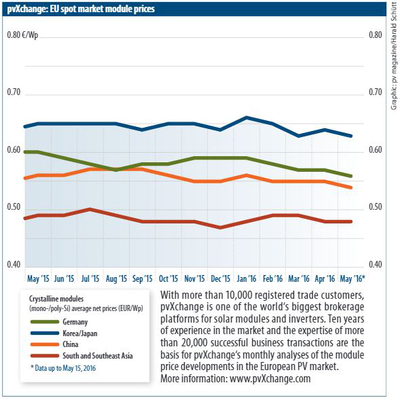 Module prices:Germany’s REA debate reloaded.
Module prices:Germany’s REA debate reloaded.
The current state of the European mar-ket offers scant cause for celebration. Following a somewhat lively first quar-ter compared with the same period last year, demand between mid-April and mid-May has apparently dropped off once again. The interest in PV installations is certainly present – what is lack-ing is decisiveness on the part of consumers and investors. Few new systems are being built and installers are turning to other business segments. Appar-ently there is little pressure to complete projects in the pipeline: FITs continue to be stable, at least in Germany. Numer-ous projects already planned are thus being pushed toward the second half of the year. Renewed uncertainty about the revision of the German Renewable Energy Act (EEG) and fear of retroactive cuts is one reason for this.
German Finance Minister Wolfgang Schäuble wants to eliminate the tax exemption for self-consumption of PV. The negative effects of the EEG surcharge on both PV installations and the imple-mentation of innovative direct market-ing concepts are still a bitter memory. The recent federal-state special summit on the EEG revision was initially unsuc-cessful because the individual positions were apparently too far apart. The public tender requirement for wind and PV applies to projects with 1 MWp of capac-ity and larger, although some would like to see the threshold set at 30 kWp, which would have catastrophic effects.
The progressive transition to the tender model is intended, among other things, to take the wind out of the Commission’s sails. Brussels wants to promote tenders in general rather than defined FITs. The EC has been torpedoing the EEG for years. Now the already hotly debated tax breaks in EEG 2012 have been identified as a form of anti-competitive state subsidy, which should have been subject to special approval by the EC. At the same time, the German government is promoting expansion targets for renewable energy that are tantamount to slamming on the brakes at a time when progress is already at a crawl. By 2025, the govern-ment is targeting 40-45% of generation from renewables. That means it is allowing a full nine years to increase the current share of 30-35% by just 10%. Because the last German nuclear power plant is scheduled to be taken offline by 2022, the remaining energy demand will be met with coal and gas-fired power plants or imports. While everyone eyes Berlin and Brussels with anticipation, France is releasing expansion targets for renew-ables. For PV, the plan is to more than triple installed capacity by 2023. The tar-get is 18.2 to 20.2 GW of total capacity. By 2018 there should be at least 10.2 GW of installed PV in France. This would corre-spond to an annual rate of 1.5 GW. There is also some positive news from IHS: Europe just hit 100 GW of installed PV capacity.
Module Class | Price (€/Wp) | Change comp. with previous month | Description |
High Efficiency | 0.71 | -2.9% | Crystalline modules 275 Wp and above with PERC, HIT, N-Type or back-contact cells, or combinations thereof |
All Black | 0.59 | 0.0% | Module types with black back sheet, black frame and a rated power between 190 Wp and 270 Wp |
Mainstream | 0.50 | 0.0% | Modules typically with 60 cells, standard aluminium frame, white backsheet and 245-270 Wp, represents the majority of the modules in the market |
Low Cost | 0.39 | +2.6% | Low-output modules, factory seconds, insolvency goods, used modules (crystalline), products with limited or no warranty |
(The prices shown reflect average asking prices for duty-paid goods on the European spot market in the month April 2016.)
Author: Martin Schachinger, pvXchange GmbH
April 2016: Turning the screw
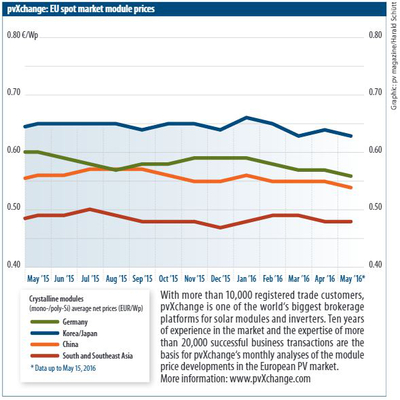 Module prices: The PV industry still has not shaken off its winter slumber, and yet IKEA wants to take the market by storm.
Module prices: The PV industry still has not shaken off its winter slumber, and yet IKEA wants to take the market by storm.
Despite spring-like temperatures and snowless roofs, the solar market is still on ice this year. The installation figures in Germany, Italy and France lag those of previous years. Module prices, too, have scarcely budged. The price level of Chinese and Southeast Asian products has remained nearly unchanged since the beginning of the year, while European and Japanese module prices are converging slightly toward it. The new recycling directive taking effect may also be contributing to the market paralysis. Many market players are still undecided or even completely in the dark about what steps they have to take to be in conformity with the law. Unfortunately, the information policy of European lawmakers has left quite a lot to be desired in that regard.
It is likely, however, that the end to generous incentives in the U.K. will affect module availability and, therefore, the price level in the rest of Europe. Up to March, many deliveries still ended up on the island, creating a bottleneck on the continent, particularly with regard to products in the lower end of the market. But by April the U.K. effect should have tapered off significantly. Currently, there is a steady demand for replacement modules, not least because many solar companies and large O&M service providers have started their annual maintenance and defective modules will have to be replaced. Many of the module types are no longer manufactured, however, and finding suitable replacements is not always easy. Although the relevant providers can often offer identical or very similar products in small quantities, when large quantities are needed sometimes the only option is complete replacement. The old modules that are still functional can usually be used elsewhere or sold.
Swedish furniture chain IKEA has now taken up the challenge of overcoming investment inertia among consumers. The Scandinavians want to become, in their own words, “the largest retailer of rooftop PV systems.” Initially the company will begin sales in the U.K, the Netherlands and in Switzerland. Later, the network of solar distributors will be expanded to branches around the world. Industry insiders know all too well that such an undertaking is none too easy for a latecomer to the business. Some home and garden store chains – and just about all of the big energy companies – have already fallen flat or are tottering towards failure in the hotly contested small system segment, even though at first glance they appear to have a natural affinity to the PV market. But, as always, the devil's in the details, in the actual implementation, that is. We will have to wait in suspense to see what sort of disruptive concepts IKEA has up its sleeve to achieve this presumably impossible task.
“It will have to be a very simple, transparent sales process for customers, and has got to be affordable,” one observer said. Will PV kits be packed in portable boxes and deposited in the furniture warehouses, each package including the tools and generously illustrated assembly instructions with which IKEA customers are familiar? All too often, experience has shown that end consumers are better served when their PV systems are designed from the ground up by a professional solar company with components best suited to their needs. Package or complete systems – and DIY solutions, in particular – often involve unforeseen follow-on costs for retrofitting or rebuilding. The Scandinavians would be well advised to think long and hard about the undertaking and prepare as best they can for a complete entry into the solar market.
Module Class | Price (€/Wp) | Change comp. with previous month | Description |
High Efficiency | 0.69 | -3.0% | Crystalline modules 275 Wp and above with PERC, HIT, N-Type or back-contact cells, or combinations thereof |
All Black | 0.59 | -5.4% | Module types with black back sheet, black frame and a rated power between 190 Wp and 270 Wp |
Mainstream | 0.50 | -0.0% | Modules typically with 60 cells, standard aluminium frame, white backsheet and 245-270 Wp, represents the majority of the modules in the market |
Low Cost | 0.38 | +5.6% | Low-output modules, factory seconds, insolvency goods, used modules (crystalline), products with limited or no warranty |
(The prices shown reflect average asking prices for duty-paid goods on the European spot market in the month March 2016.)
Author: Martin Schachinger, pvXchange GmbH
March 2016: Trends in two directions
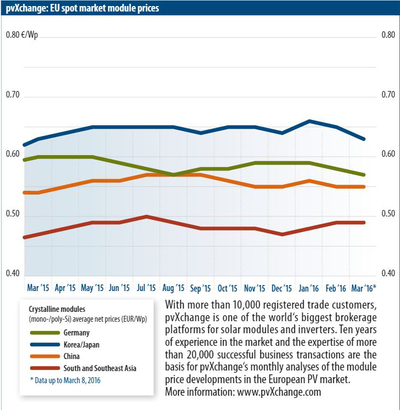 Module prices: Solar pioneers are being insourced by energy companies. Solar firms have begun reporting significantly better numbers.
Module prices: Solar pioneers are being insourced by energy companies. Solar firms have begun reporting significantly better numbers.
Market sentiment in Europe appears to be looking up again for the first time this year. A contributing factor has been the very mild winter, which has already spurred the pace of installations in many parts. Note, however, that this is the big European picture. Germany, with its disappointing January and February figures, has yet to feel the effect of the upturn. Nevertheless, throughout Germany, the small and medium-sized system sector has been much livelier.
There is still a shortage of inexpensive modules in the European Union. Over all, the selection of modules has become very limited. Due to minimum import prices, which still apply, manufacturers are mostly only focusing on products with higher efficiency or smart junction boxes, such as with built-in module optimizers or other intelligent circuits.
Several solar companies have reported their annual sales figures in recent weeks. Once again, the figures are looking up when compared with the previous year, even for European companies. Thanks to a steadily growing global market, most manufacturers, system integrators and project developers did well. Last year also saw significantly fewer bankruptcies in the solar industry than in previous years. That is, of course, also due to the fact that the wheat has now been separated from the chaff.
The enormous losses these days are mainly being racked up at conventional energy companies because in that sector the restructuring has only just begun. To speed up the expansion of their renewable energy business, the major energy suppliers in Germany have been happily insourcing solar people and businesses, some of which are among the pioneers in the industry and until recently the staunchest opponents of the coal-nuclear lobby. But with the new outlook and a bit of sloganeering, all is right with the world, it would seem – beggars can’t be choosers. What does leave a bad taste in the mouth, however, is when these hastily greenwashed conglomerates act as if they had invented solar energy.
The question is whether it is really so simple to merge the old world with the new in the energy sector. PV, in particular, has always been a fast-moving business with ups and downs following in rapid succession. The business has always demanded imagination and flexibility – virtues which most would concede are hardly the strong suit of E.ON, RWE, and their ilk. There is a huge danger that many business models will be stifled by excessive bureaucracy and risk aversion, that speed and innovation will fall by the wayside, and that the veterans and founders of the solar industry will soon throw in the towel in frustration.
But maybe a fresh breeze will waft through the boardrooms of the power companies and their pure financial strength will be turned to the task of moving mountains.
Overview of price points – first time introduced in October 2015 – including changes:
Module Class | Price (€/Wp) | Change comp. with previous month | Description |
High Efficiency | 0.67 | -2.9% | Crystalline modules 275 Wp and above with PERC, HIT, N-Type or back-contact cells, or combinations thereof |
All Black | 0.56 | -3.4% | Module types with black back sheet, black frame and a rated power between 190 Wp and 270 Wp |
Mainstream | 0.50 | -2.0% | Modules typically with 60 cells, standard aluminium frame, white backsheet and 245-270 Wp, represents the majority of the modules in the market |
Low Cost | 0.36 | +5.9% | Low-output modules, factory seconds, insolvency goods, used modules (crystalline), products with limited or no warranty |
(The prices shown indicate the average asking prices for duty-paid goods on the European spot market in the month of February 2016.)
Author: Martin Schachinger, pvXchange GmbH
February 2016: A gathering storm
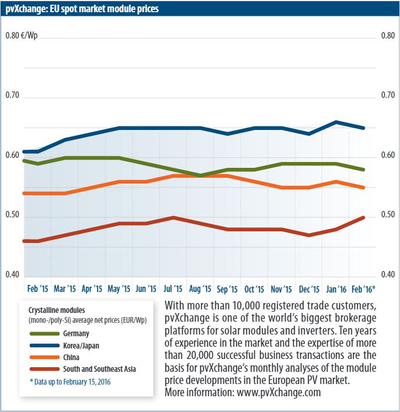 Module prices: New clouds are gathering on the PV horizon as difficult market conditions for modules persist, exacerbated by an unwieldy, if good-intentioned, take-back and recycling scheme.
Module prices: New clouds are gathering on the PV horizon as difficult market conditions for modules persist, exacerbated by an unwieldy, if good-intentioned, take-back and recycling scheme.
In January, module prices of products from Asia climbed by a few percent age points across the board. Only the figures of the few remaining German and European products remained stable. The local market, mainland Europe at least, is still inadequately supplied with cheap modules. A disproportionate amount of goods are still ending up in the British Isles, where the last major projects are hastily being connected to the grid before the likely end to the free-for-all at the end of March.
The temporary boom in the U.K. has more or less singlehandedly brought the European market back to moderate growth following three years of decline. Still, at a growth rate of 15%, it lags far behind the global PV market; a market that grew by 25% in 2015 to more than 50 GWp of newly installed capacity. The German market, which has continued its slide, accounted for just 3% of the total, or 1.5 GWp. No wonder Asian manufacturers continue to lose interest.
And as if that was not already troubling for German PV sellers and installers, yet another scourge befell Germany at the beginning of the year in the form of the amended ElektroG2 law or, at the European level, the Waste Electrical and Electronic Equipment Directive (WEEE). First came the punitive tariffs and minimum import prices for Chinese cells and modules, then mandatory tenders for ground-mounted systems, and now this new PV-blocking law.
What in theory is a well-meaning and basically welcome measure, a system for finan
cing disposal and recycling of electronic waste from the polluter with insolvency protection, has become a farce in practice. After the voluntary PV Cycle turn-in scheme failed to have the desired effect when nowhere near enough PV panel manufacturers signed on with that or similar services, a system has now been introduced that makes it possible to intervene right down to the level of the solar installer.
Installers are now responsible for organizing and financing the turn-in of all of the electronic devices they sell, unless otherwise arranged further upstream. Since 24 October 2015, not only inverters but also PV modules have been subject to the new regime; on 1 February the transitional period ended for the registration of all brands and products offered for sale.
What that means for the individual stakeholders is difficult to predict. Although it is always possible to study the legislation, and there is now plenty of informational material (e.g. from the German Solar Industry Association, or BSW), there is still plenty of room for interpretation, and finding qualified independent expertise is not easy. At the moment, there is just too little experience with the actual feasibility of implementation and the consequences of ignoring the rules. There is also too much chaos surrounding the EAR Foundation, the body responsible for product registration and administration of financial guarantees. Applicants sometimes wait months for a registration number, which is technically required now before goods can be brought to market.
In early February, of the hundreds of brands and products currently on the market, just 50 were officially registered. Mostly Japanese and European manufacturers with generally higher-priced products can boast a registration number, while their Chinese and Southeast Asian counterparts probably do not know or want to know about their “good fortune”. To top off all this nonsense, each member of the EU wants to implement its own national system for return and recycling. The likely outcome is that further international manufacturers will pull out of the EU market, causing the price level to rise again in 2016, particularly if the cost of the newly organized system is transferred to products.
Overview of the newly introduced price points in January, including changes:
Module Class | Price (€/Wp) | Change comp. with previous month | Description |
High Efficiency | 0.69 | -1.4% | Crystalline modules 275 Wp and above with PERC, HIT, N-Type or back-contact cells, or combinations thereof |
All Black | 0.58 | +1.8% | Module types with black back sheet, black frame and a rated power between 190 Wp and 270 Wp |
Mainstream | 0.51 | +2.0% | Modules typically with 60 cells, standard aluminium frame, white backsheet and 245-270 Wp, represents the majority of the modules in the market |
Low Cost | 0.34 | -8.1% | Low-output modules, factory seconds, insolvency goods, used modules (crystalline), products with limited or no warranty |
(The prices shown indicate the average asking prices for duty-paid goods on the European spot market in the month of February 2016.)
Author: Martin Schachinger, pvXchange GmbH
January 2016: Suspension during review
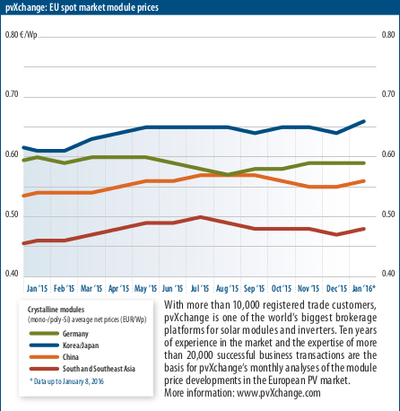
Module prices: While the European Commission continues its review of anti-dumping measures put in place, market restrictions should be suspended in order to offer further protection against the PV industry.
Once again, December scarcely saw any changes in module prices over the previous month. The downward movement of prices for Japanese and Southeast Asian goods is marginal at best and is no indication of a trend. To the contrary, as January approached, the price of most of these modules increased following the sell-off of a few remaining warehouse stocks at bargain prices. Considered over the year as a whole, there seems to be no momentum to price development. Price stability within Europe is paralyzing the market and can be traced directly to regulation by the EU commission, which is an essential contributing factor to the European market finishing below the previous years' level for the fourth year in a row in 2015.
Until now, the PV industry has unquestioningly been gnashing its teeth over the fact that minimum import prices have remained in place during the ongoing review of anti-dumping measures. However, a statement by the British energy minister has brought a breath of fresh air to the debate. She has called for a moratorium on the undertaking and collection of tariffs during the review process. Unlike the German federal government, she is taking a clear stand against existing market restrictions.
The question of why the applicable market controls have remained in place during the EU commission’s review process is certainly justified. If, for instance, the EU concludes after a couple of months that the market restrictions for Chinese products are unjustified, it will be almost impossible to compensate for the damage to society and the PV industry caused by the inflated prices. Let us briefly recap the background and rationale of the anti-dumping process:
“Dumping: a product is considered to be dumped if its price when exported to the Community is lower than the comparable price of a like product in sales in the course of ordinary trade in the exporting country (normal value).” In this particular case, what that means is that a dumped cell or module generally has to be sold at higher prices to customers within China than to consumers in the EU. This is demonstrably untrue.
“Subsidy: the presence of a subsidy is assumed when the government in the country of origin or exporting country offers a financial contribution or any form of income or price support for the manufacture, production, export or transport of any product.” This is true for manufacturers in China and the EU alike.
“Damage: it must be determined that a branch of industry in the Community is materially damaged or threatened with damage, or that the establishment of a branch of industry in the community is significantly delayed.” A decrease of production capacity within Europe was observed, but was partially compensated for by investments from Asia and the establishment of local production facilities. On the other hand, even in China, manufacturers unable to withstand competition have had to file for bankruptcy.
“Causal link between dumping and injury: there must be a direct causal link between dumping and the observed damage.” For this to apply, we would have to have observed unmistakable dumping and a market collapse even before the introduction of market restrictions. There was certainly a consolidation, but due to the extraordinary number of independent manufacturers, it had been expected for quite some time. A very clear market collapse did not come until 2013, the year the protective tariffs went into effect.
“Community interest: the introduction of an anti-dumping or countervailing duty must be in the interest of the Community. In this case, the EC Commission has to strike a difficult balance of interests: the core issue is whether the interest in imposing a punitive tariff of the producers filing the complaint outweigh the damage to importers, industrial processors and possibly consumers arising from the imposition of anti-dumping or countervailing duties.” Comprehensive damage to the overall market is assumed and can only be refuted with evidence to the contrary.
Advocates of the market restrictions often deny that the demise of the European PV industry has anything to do with punitive tariffs and minimum import prices. The only way to prove this contention is to lift the restrictions immediately and wait to see what happens. If nothing happens, and growth in installations continues to fall short of the policy volume targets, advocates of the restrictions will be justified, and the market will have to be stimulated with other measures. If installation figures see a sharp rise, however, and a burgeoning market develops over the course of the year, this indicates a causal link between the lifting of the restrictions and the market recovery. Let's let the market decide.
Here is an overview of new price points introduced in December, including changes:
Module class | Price (€/Wp) | Change | Description |
High Efficiency | 0.70 | + 2.9% | Crystalline modules 275 Wp and above with PERC, HIT, N-Type or back-contact cells, or combinations thereof |
All Black | 0.57 | 0.0% | Module types with black back sheet, black frame and a rated power between 190 Wp and 270 Wp |
Mainstream | 0.50 | + 2.0% | Modules typically with 60 cells, standard aluminum frame, white backsheet and 245-270 Wp, represents the majority of the modules in the market |
Low Cost | 0.37 | 0.0% | Low-output modules, factory seconds, insolvency goods, used modules (crystalline), products with limited or no warranty |
(The prices shown reflect average asking prices for duty-paid goods on the European spot market in the month of December 2015.)
Author: Martin Schachinger, pvXchange GmbH
December 2015: It could have been easier
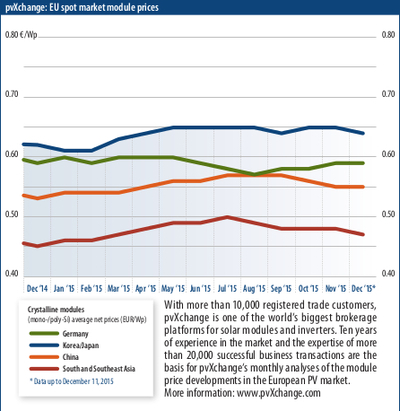
Module prices: As the year draws to a close, there has been little movement in module prices. A slight bottleneck in polycrystalline standard modules noted in November failed to lift prices, counteracted by the usual clearance sales in December.
Overall, prices across nearly every region of origin have ended up at the level they started 2015. At the same time, feed-in tariffs – at least in Germany – came down considerably over the same period. Degression was not halted until October when the so-called breathing cap began to take effect. Accordingly, the monthly installation figures in Germany remained below the 100 MW mark.
And now it is official: import restrictions on Chinese cells and modules will not be lifted anytime soon. The EU Commission has finally taken up a protracted review process for anti-dumping and anti-subsidy measures, which will likely result in a price freeze for a further 12-15 months. As expected, the EU Prosun association requested this review, forcing the commissioners to initiate the process. Only a veto from policy makers could have prevented this procedure, but it never came.
Had the protective tariffs, and thus the minimum prices and quantity limitations specified in the Undertaking been laid to rest on December 7, life would have been much easier, at least for the vast majority of players within the European PV industry. The time-consuming review of certificates of origin of all the products imported into the EU and the associated delays would not have been necessary. Faster processing of all imports and reliable delivery data on delivered quantities and arrival dates would in turn increase planning security.
Although the expected module prices in the lower 40-euro cent range would put European manufacturers under pressure, SolarWorld and its associates demonstrated in mid-2015 that they can keep pace with prices under 50 euro cents. Not long ago, pv magazine raised the question of whether modules for projects could be produced for 41 to 45 cents without subsidies. Outside the EU, and other regulated markets, Asian modules from leading manufacturers have already been easily available at these prices for some time. Overall, a significant market recovery would be the result, particularly in the industrial and large-scale project segment. Dealers and installers could once again achieve satisfactory margins with solar panels, which is nearly impossible at present.
Unfortunately, we have missed the boat on this opportunity. As such, we can look forward to another year of sideways cell and module prices linked to the minimum import prices of Chinese products. For many Chinese manufacturers, the undertaking has proved more a burden than an opportunity, however, especially where larger production capacities outside of China had already been developed. Distrust and constant monitoring by the EU Commission have also complicated the sale of non-Chinese products in the EU. Recently Trina Solar has bid farewell to the Undertaking, and other manufacturers are sure to follow. Since Chinese products can no longer be sold here anyway, their producers are not bothered by the punitive tariffs. Guarantees of origin have to be provided already for non-EU products entering the EU anyway.
The question remains whether under the current circumstances all of the German projects awarded in public tenders can actually be implemented. Many companies certainly speculated on the elimination of minimum import prices at the end of the year when they submitted their bids. But with the unchanged price level expected in 2016, some large-scale plants will likely be uneconomical, unless SolarWorld jumps into the breach with prices, a move sure to spark talk of dumping.
Last but not least, what follows is an overview of new price points introduced last month, including changes:
Module class | Price (€/Wp) | Change | Description |
High Efficiency | 0.68 | – 2.9% | Crystalline modules 275 Wp and above with PERC, HIT, N-Type or back-contact cells, or combinations thereof |
All Black | 0.57 | – 3.4% | Module types with black back sheet, black frame and a rated power between 190 Wp and 270 Wp |
Mainstream | 0.49 | 0.0% | Modules typically with 60 cells, standard aluminum frame, white backsheet and 245-270 Wp, represents the majority of the modules in the market |
Low Cost | 0.37 | – 5.1% | Low-output modules, factory seconds, insolvency goods, used modules (crystalline), products with limited or no warranty |
(The prices shown indicate the average offer prices for duty-paid goods in the European spot market in the month of November 2015 again.)
Author: Martin Schachinger, pvXchange GmbH
November 2015: What's Germany's Energiewende really all about?
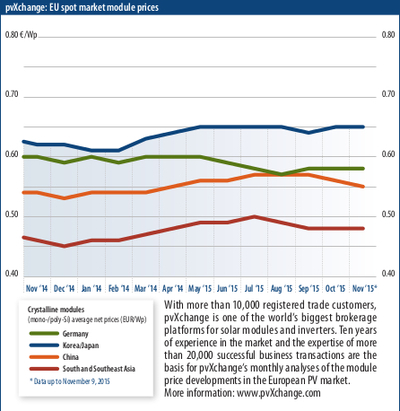
Module price index: With module prices flat in Europe, pvXchnage takes aim at the double standards at play at the heart of Germany's Energiewende.
There were not many surprises in last month's market and module price development. With broadly stable prices, the markets in Germany and Europe saw, at best, a slight improvement from September to October, but on the whole it is still at a disappointing level. I'll take this state of affairs as an opportunity to look into the reasons for why the current market is in such a state and not faring better. This is not an especially difficult exercise. Once again we are getting a lesson these days from the big policy makers in what the new energy economy is all about: cold-blooded power and big business politics at the expense of the consumers and taxpayers.
Billion-euro lawsuits or threatened legal actions from nuclear power companies, forced gifts and subsidies to coal power plant operators, years of fraudulent behavior in connection with emissions limits – this is the dire news of the shameless business practices of some of Europe's biggest corporations that has been dominating the headlines over the past few weeks. Meanwhile, we stare dumbfounded at how the expansion of renewables falters and how the introduction of environmentally friendly vehicles is undermined. Is that the necessary course of the energy transition, or is this about profits for large-scale investors and power structures?
Other countries have long since passed Germany by and are setting the example for how committed green energy policy is done. Officials in Chile have now confirmed that PV power is the cheapest source of electricity in the country. As such, the country is promoting efforts to decommission fossil fuel based power plants and break its dependence on energy imports by building ever more PV systems and not strangling the market. Here in Germany, across all of the political camps the support for a transition to a renewable source of energy unanimous. The trouble is that none of them can decide which source that should be and how fast the transition ought to take place.
Catering to the conventional energy industry seems to know almost no bounds in Germany. The influence of the “Big Four” utilities is apparently still too strong. Flying in the face of reason, admissions are being made that will end up costing of us huge sums of money, which will no longer be available for the expansion of renewable energy. The latest act of bungling is the multi-billion euro payouts the big energy conglomerates are collecting for reserving capacity from coal-fired power plants that are actually already supposed to be switched off.
And the debate is still raging over who will pay the horrendous costs associated with the government plan to drop nuclear energy, the taxpayer or the utility customer! And how is this, despite years of massive profits at every one of the big energy companies, even possible?
At the same time, the government passes out gifts to the deeply entrenched energy industry; it has announced a rise in the renewable energy surcharge. Of course, consumers are not happy. Ever-rising electricity costs are all the fault of renewables, right? What else could it be? Nonetheless, in January 2016, feed-in tariffs for PV power fed into the grid will not likely be lowered again, but rather remain at the December level. This is the result of low installation numbers over the past few months and is long overdue. The idea that this could revitalize the market in some way is highly doubtful, however. The level is simply too low to produce acceptable returns at current system prices. That is why within the ranks of the solar industry, there is already talk of eliminating the renewable energy act to put an end to the counterproductive effect of the renewable energy surcharge on the overall market, and thus boost the image of renewables.
Elimination of import restrictions on Chinese solar panels and cells, which would bring PV panel prices down by some 20%, could have a really positive effect on market development. But even on this issue, the German government is highly indecisive. The current attitude can be summed up as: “We have other problems right now and have no desire to take up this issue yet again. Why don't we just leave well enough alone.” A group or EU parliamentarians in Brussels spanning a number of different factions has shown much more foresight on this issue and has called for a quick scrapping of the trade restrictions to save the solar industry. If only this call would be heard!
The bottom line is that the transition to clean energy cannot be achieved by throwing money at energy conglomerates or preventing the import of important environmental technology. The politics of empty promises and misdirected efforts is a policy that leads only to undershooting our own targets. What we need now is an urgent change of course in the direction of responsible support of the only sustainable energy source and its intelligent use. If we fail to do this, the formerly touted energy transition that won international recognition for Germany could end up making the country an international laughing stock. To put it in the words of our Chancellor: We can do it!
Last but not least, below is an overview of the new price points for last month, including changes:
Module class | Price (€/Wp) | Change | Description |
High efficiency | 0.70 | + 1,4% | Crystalline modules to 275 Wp with PERC, HIT, n-type, or back-contact cells or a combination thereof |
All black | 0.59 | 0.0 % | Module types with black back lamination, black frame, and a nominal capacity between 190 Wp and 270 Wp |
Mainstream | 0.49 | – 3.9 % | Modules that usually have 60 cells, standard aluminum frames, white back lamination, and 245 to 270 Wp; the majority of modules on the market |
Low cost | 0.39 | + 2.6% | Low-output modules, factory seconds, inventory liquidation, used modules (crystalline), products with limited or no manufacturer warranty |
(The prices shown represent average asking prices for taxed goods on the European spot market for the month of October 2015.)
Author: Martin Schachinger, pvXchange GmbH
October 2015: New criteria, stable prices
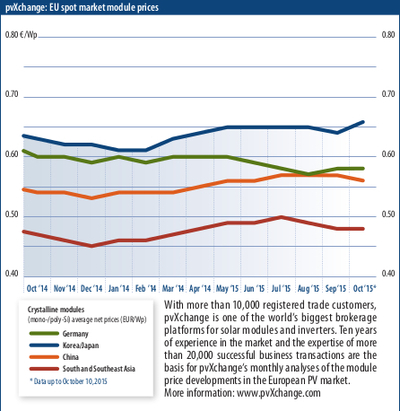
Module price index: pvXchange has altered the criteria for its October module price index to reflect European market pricing. There has been little movement of late.
In September, the PV markets varied very little over the previous month and module prices from all regions changed only marginally. Fluctuations in one direction or another will mostly be smoothed out again in October. Downward price adjustments that would favor of a revival of the PV market are virtually impossible for most producers due to EU Commission restrictions. Inexpensive products are becoming increasingly rare in Europe due to more stringent controls.
The limited supply of factory seconds and insolvency goods continue to be shunned by many investors for their lack of quality certificates and warranties. The same is true, unfortunately, of used modules in particular, which – if tested and from a well-known manufacturer – certainly can be an alternative to expensive new products.
But this market commentary is not primarily concerned with price development and the events in the market, but rather on changes in the offing to the price index itself. These changes are necessary because sorting out offered prices by the selected regions has become increasingly difficult in recent months, such that the results are only partially representative. The separation according to production regions is no longer as relevant, because the remaining module production facilities in Europe are increasingly operated by corporations of Asian origin, whereas many European PV manufacturers now produce in Asia, or at least buy a large part of the raw materials there.
Examples include the formerly European manufacturer (Hanwha-) Q-Cells, REC, Solon and Axitec, which produce their panels exclusively in Asia, whereas Jinko Solar, Renesola, BenQ and Astronergy operate manufacturing facilities in Europe, even though their parent companies are located in Asia. Original Chinese brands are even more confusing with module declarations of origin listing a country in Southeast Asia or a name suggesting that they are not a Chinese company – Canadian Solar or Amerisolar are good examples.
In coordination with pv magazine, pvXchange has therefore decided to revamp the module price index. In the future, the price survey will be performed in light of manufacturer developments in recent years. In the future, more weight will be given to the technology used or to product quality, rather than the supposed origin of the products. This approach also makes price differences easier to understand and puts them outside the influence of politically prescribed market restrictions.
Effective immediately (Oct 2015), average prices in the European market for the following module classes will now be surveyed:
Module Class | Price (€/Wp) | Description |
High Efficiency | 0.69 | Crystalline modules 275 Wp and above with PERC, HIT, N-Type or back-contact cells, or combinations thereof |
All Black | 0.59 | Module types with black back sheet, black frame and a rated power between 190 Wp and 270 Wp |
Mainstream | 0.51 | Modules typically with 60 cells, standard aluminum frame, white backsheet and 245-270 Wp, represents the majority of the modules in the market |
Low Cost | 0.38 | Low-output modules, factory seconds, insolvency goods, used modules (crystalline), products with limited or no warranty |
With this new classification scheme, there will still be no distinction made between mono and polycrystalline modules, as I have not observed any significant price differences in this respect. The only decisive factors in the sale price are demand, availability and module efficiency. Thin-film technologies are still not taken into account because there is still too little supply on the European market for a representative survey.
The price survey and presentation for the above-mentioned types will take place concurrently with the region of origin categories, effective immediately and to the end of the year. If this new price break-down proves itself, it will replace the old one completely in the coming year. Since the selected performance classes that define the price groups are subject to technological development, they will be reviewed periodically and adjusted as necessary.
Overall, the expectation is that the new price index will better serve the information needs of readers and users, even if it is no longer much good as a reference for checking the minimum import prices. But that chapter will soon be behind us anyway!
Author: Martin Schachinger, pvXchange GmbH
September 2015: Positivity and conflict
Trade it in: As the summer draws to a close, there is a slight upturn in the market, also in the camps of supporters and opponents of trade restrictions.
For the first time in 10 years, the average price of solar panels manufactured in China reached parity with the cost of solar panels produced in Europe. But this notable situation was short-lived; by early September the prices had already begun to drift apart again. The slight drop in the cost of Asian panels is due to sporadically emerging inexpensive lots, but cannot yet be described as a trend. Furthermore, only a very few deliveries from Asia find their way to the European market. Currently, monocrystalline panels are the only ones being imported from China anymore, because they can still command a sale price above the MIP (minimum import price). This is particularly true of pure black modules, which are only used in the small array sector.
Polycrystalline modules come mostly from Southeast Asia, and are not subject to price restrictions – at least, not yet. However, the production capacity of this region is rushing to keep up with demand from the U.S., which is leaving less volume available for the European market. In Germany there should be no shortage of polycrystalline modules, since a number of Chinese manufacturers have established their own fabs in Europe and Africa. Persistent repressive measures imposed by the European Commission, however, have had the result that facilities in these locations either produce panels only for the U.S. market or have shut their doors entirely. Commissioners justify their negative attitude with the claim that it is no longer possible to determine which products come from Europe and which originate from China.
German and European products have become more expensive again with the surge in demand in late August and early September. The slide in prices in recent months appears to have been stopped for the time being. German panels on offer for prices far below the MIP for Chinese products have become few and far between. The official explanation from domestic manufacturers is that the low prices were only special offers, which the strong order situation no longer justifies. On the other hand, they say that the purchase prices of cells and other raw materials have gone up.
However, one cannot help entertaining the suspicion that there are different reasons for the back-pedaling. The argument of the MIP advocates and their mouthpiece, the EU Prosun association, is that the panel prices of many Asian manufacturers do not reflect the actual cost of production and are dumping prices that can only be sustained with the help of government subsidies, and that argument of course loses credibility if the companies that espouse it are selling their own panels at the same prices. Now, the MIP advocates are regrouping for the next round of the “Solar Trade Wars”, which aims to uphold the import restrictions and expand them to other regions in Asia.
The coming months will show the wisdom of this calculation. After all, there is a strong opposition to the increasing restrictions, which is steadily attracting support from more companies in the solar industry. In July, the Solar Alliance for Europe – SAFE, for short – formed around high-profile companies like BayWa r.e., MVV, EnBW, Schletter, IBC Solar and Lichtblick to call for an end to all trade restrictions and the expiration of the Undertaking on December 6.
Interestingly, both camps cite job losses as one of their key arguments. EU Prosun claims that European producers will shed jobs as a result of cutthroat Chinese competition, while SAFE says that the overall decline in new installations will be the cause of a far greater loss of employment.
But there is one thing that both supporters and opponents of punitive tariffs and import restrictions agree on: policymakers have failed and urgently need to create reasonable conditions for a more positive development of the European solar market.
Author: Martin Schachinger, pvXchange GmbH
August 2015: High level convergence
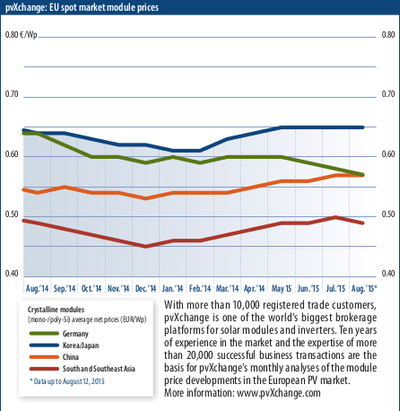
Space rendezvous: Prices for European and Chinese solar panels converge at the same high level for the first time.
Despite sight monthly fluctuations, prices for Asian panels remain stable overall, whereas prices for European products have seen a gradual but steady decline. In August, the average watt-peak price for solar panels produced in China will converge for the first time in recent PV history with prices for Europe-produced solar modules. In view of the fact that much lower prices are possible on the world market, this is a dubious moment and for many industry players certainly no cause for celebration.
Still, one wonders how economically feasible it is to build utility-scale and ground-mounted at current module prices and feed-in tariffs. Many EPCs are therefore holding out the hope of grabbing a piece of the public tender pie in Germany, and not without considerable risk. For most of them, however, the chances are not so good. Indeed, the pie is so small (only 150 MWp per tender round), that two-thirds of the participants will come away empty-handed. Not until Germany’s Federal Network Agency makes its assessment will it be clear whether bids significantly higher than the current rates of compensation will be awarded contracts and if new players will be among the awardees or whether the contracts will be awarded to the same companies who came out on top in the first round.
Since the beginning of Germany’s school holiday season in mid-July, the interest in PV appears to have tapered off further in the small plant sector. Moreover, the high summer temperatures scarcely permit long periods of outdoor work, which has added to Central European installers’ woes. But even PV systems are running up against their limits – both inverters and crystalline modules are operating at lower efficiency due to the high outdoor temperatures. Once again, the technology to achieve a better solar yield both in low light and at high outside temperatures is lacking. Thin-film modules have a well-known advantage under such conditions but have been pushed into a niche. Currently there are hardly any available products on the market, let alone groundbreaking new developments.
However, the latest efficiency announcements in the field of commercially produced CIGS modules, in the range 20% to 22%, are very promising. But the panel manufacturers involved owe us an answer to the question of whether economies of scale can actually make this technology more cost-effective than crystalline silicon. This is easier to believe coming from developers of organic photovoltaics (OPV) because they are not reliant on a ready supply of rare earths or complex manufacturing processes. The active layers can easily be printed on suitable substrates – on transparent films or sheets of glass, for instance. Again, with OPV, respectable efficiencies, up to 12%, can now be achieved. Of particular note is the Dresden-based company Heliatek, which was recently honored by the World Economic Forum as a Technology Pioneer 2015. The company’s ultra-lightweight solar-active film could be particularly important in bringing about a breakthrough in building-integrated photovoltaics.
Author: Martin Schachinger, pvXchange GmbH
July 2015: The empire strikes back
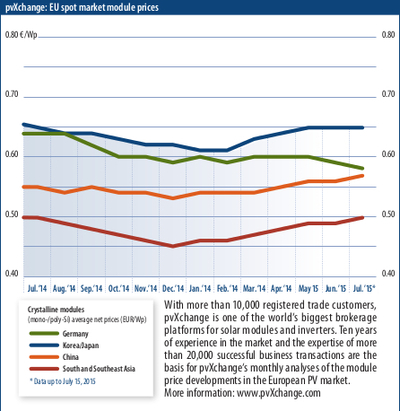
Module prices: A group of European solar companies refuse to accept an extension of the minimum import price regulation without a fight.
In reality, unlike in the Star Wars saga, the line between black and white and good and evil is not always clear and distinct. This is evident in the debate over anti-dumping duties and the unintended effects of the resulting market restrictions in Europe.
At first, the initiative of the EU Prosun association spearheaded by Frank Asbeck and his company SolarWorld against alleged dumping prices from China appeared welcome and worthy of support to most solar stakeholders. The idea was to instrumentalize the EU Commission to prevent the European PV market and companies based there from being crushed under the weight of government-backed Chinese companies. In true Jedi fashion, the Europeans stood fast against the dark side and forced the imperial invaders to retreat or submit to European prices.
They skillfully parried further attacks in the form of evasion attempts by Asian competition. Commissioners were constantly presented with alleged irregularities and, in response, defensive measures were repeatedly strengthened and minimum prices raised. The rebels seemed to have successfully saved the photovoltaic universe from the overwhelming power of the empire – fade to credits…
But something seems out of place in this PV trade war tale. Unfortunately, this confrontation has left the market – and most of the European companies across the entire value chain – by the wayside. Solar installations bring a high level of regional value creation, even if non-European modules are used. But when affordable solar modules are lacking, there are no installations, no value creation, and no jobs. And since Europe is not the center of the galaxy, the solar starfleet has long since lifted off and flown onward to more lucrative regions.
So, did we really throw our support behind the right side when we joined the rebels? No one can seriously doubt that even Mr. Asbeck acted in his own interest when he and a handful of like-minded entrepreneurs submitted their complaint to the European Commission and got the ball rolling on the investigations and resulting measures. To date, the minimum import price has mainly ensured the survival of SolarWorld, and if it is allowed to remain in place will enable the Bonn-based company to expand its market share significantly in Europe and develop a dominant position as one of the few remaining cell and module manufacturers in Germany – the “Sun King” consolidates his empire.
Can it be good for a market when diversity dies, when prices are artificially inflated when in fact they could easily be 10-15% lower, as is evident in the price levels of adjacent free markets? Who benefits from a price level at which large PV systems can no longer be built economically and project expertise either moves out of the region or is lost? Since the introduction of the minimum import prices, the European market has already contracted significantly, since no coordinated measures have been adopted to counteract their effects. For some time, the German market has been developing at a rate below the government expansion target. “Oops, we didn’t see that coming. Maybe we went a bit too far!”
So now, under the banner of SAFE, the Solar Alliance for Europe, made up predominantly of German companies – let’s call them “friends of the Empire” – a movement is taking shape to stand against the threat of extinction of the regional PV market and take up the fight against continued restrictions. It is a well known fact that competition revitalizes markets. The intent is to create room for Asian companies to develop in Europe again, put a stop to the trend of rising prices, and stand in opposition to the looming monopoly of a company called SolarWorld. The organization held its first press conference on Wednesday, July 15 to formulate a finely woven argument against minimum prices and punitive tariffs, as well as to present policy makers with a list of demands. But this was only the beginning, it said, and announced that further actions would follow. May the force be with you!
Author: Martin Schachinger, pvXchange GmbH
June 2015: No turnaround in sight
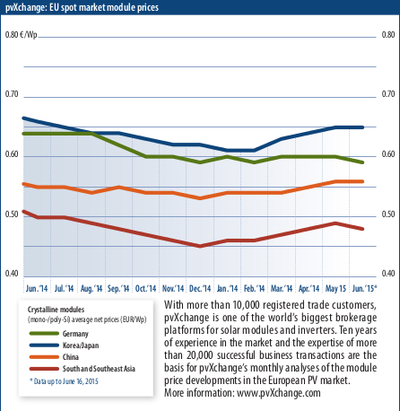
Graphic: Solarpraxis AG/Harald Schütt Module prices: Steadily rising prices prevent market growth in Europe – the solar industry continues to shed jobs.
No turnaround in sight. This is the bitter conclusion, yet again, following a look at PV market development in May. Although prices of panels from all Asian regions rose again by one or two percentage points, German and European panel prices remained flat. The fact that domestic manufacturers’ prices have held their own, apart from slight fluctuations, since October 2014 at an average of $0.60 cents per watt-peak is doubtless the result of the European Commission’s anti-dumping measures. Panels from other regions of origin are increasingly approaching this mark, but at what cost to the solar industry?
In light of the creeping decline in installations within the EU, this development is anything but good news. With new PV installations in Germany falling short of the 100 MW mark for the third month running in April, according to the German Federal Network Agency, and due to continuously rising prices that point to no real market growth, May and June are likely to be just as catastrophic. Other European countries are not faring much better. The burgeoning interest from markets such as Poland and Greece is not nearly enough to offset the weak demand from the traditional PV markets.
At the same time, artificially inflated panel prices are not necessarily needed to protect European manufacturers against competition from China. German manufacturers, in particular, with their highly automated production facilities see themselves in a position to offer their panels at prices well below the current minimum import price and not lose money. However, most domestic manufacturers rely on cells from places like Taiwan, as European cell production capacities are too low to keep up with the module production rate. This allows them to swim comfortably in the pond without fear of being swallowed up by predatory Chinese competitors, which Mr. Asbeck and the EU Commissioners are culling in increasing numbers.
Meanwhile, the systematic effort to force Chinese companies out of the European market has now taken on almost absurd dimensions. Even those operating production facilities within the EU are forced to comply with minimum prices. The reasoning behind this is that it is now supposedly impossible to distinguish whether panels that end up on the European market are of Chinese or European manufacture, as long as they have similar specifications and the same branding. The up-shot of this is the closure of production facilities due to lack of product attractiveness and a complete withdrawal from the EU area. Now there’s an outstanding way to ensure further job cuts!
We should not expect a change in this trend any time soon – to the contrary. This is particularly true in light of the European Commission’s announcement that its investigation will continue, this time with a view to imports from Taiwan and Malaysia. Fewer choices, longer waiting times, higher prices – that is the unfortunate outlook for the coming months, which will almost completely rule out a much-needed general market recovery in Europe. The U.K. is just one market that continues to be a source of good news. Once again, more than 1.6 GWp of capacity was added in the first quarter of 2015. However, to bring Europe back around to fair competition and positive growth, the alleged protectionism through market constraints must be abandoned. The plan has backfired.
Author: Martin Schachinger, pvXchange GmbH
May 2015: Minimum import price effect takes hold
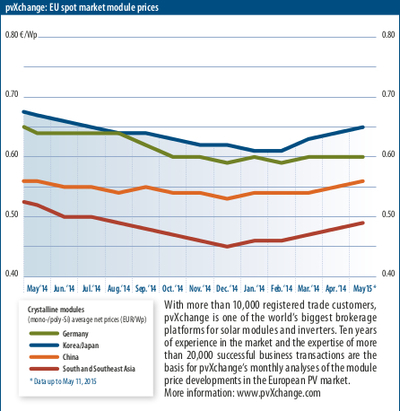
Module prices: Asian modules continue their price rise throughout April, but advocates of the minimum import price are winding up to deliver the next blow.
As expected, the rise in prices for Asian products has continued unabated in April. The module prices of the few surviving German and European manufacturers appear to have been bogged down since the start of the year. A slight updraft in the lower price segment, led primarily by German manufacturers, such as Heckert and Astronergy, countervails softening prices in the upper price segment. Nevertheless, producers continue to squeeze ever more generation capacity into the same area. These days, 260 to 270 Wp 60-cell modules have become the standard, and output continues to rise. Higher capacities by area are currently possible only with heterojunction cells (HIT cells) in Panasonic and Silevo modules, n-type cells from LG or back-contact cells made by BenQ and Sunpower, which also command significantly higher prices than the average.
Restrictions imposed by the EU Commission, in combination with comprehensive customs inspections, have slowed the flow of inexpensive goods from China and Taiwan into the European market. Furthermore, the latest increase in the minimum import price is apparently beginning to have an effect, as the slight recovery of the euro exchange rate was not accompanied by a commensurate drop in module prices. That is making it increasingly difficult to build financially attractive PV projects. It will be interesting to see which products and regions of origin are the basis of the winning bids in the recently concluded first round of German utility-scale projects and when the work will begin. Current price developments, at least, do not favor starting construction any time soon.
EU Prosun, an association initiated and dominated by German manufacturer Solarworld, has now lodged a new complaint against Chinese manufacturers. The CEO Frank Asbeck intends to spare no expense to prevent the currently valid undertaking with regard to minimum import prices and import restrictions from expiring on 7 December 2015. To the contrary, he wants to ensure the rapid enactment of a follow-on regulation to prevent an expected price drop. Meanwhile, the European Photovoltaic Industry Association (EPIA) has concluded that such protectionism in the European industry does more harm than good and has hobbled market development, prompting the association to call for the elimination of all market restrictions. This call deserves full and unqualified support.
The danger of European manufacturers with a similar anti-subsidy bent forming a front against the USA to prevent price dumping in the sale of power storage systems, as Karl-Heinz Remmers reported in his recent tongue-in-cheek commentary, is unlikely. At least that alliance would certainly not be led by Solarworld, since Asbeck earns good money in the states from subsidized module production. After all, it is unwise to mess in your own backyard. In China, however, the supporters of EU Prosun do not even have plot to set up shop on, much less a backyard. That makes it easy to set up a bogeyman against whom they can let off years of pent up steam. The absurdity of this fight cannot be reiterated enough, and a common strategy to counter it has to be developed and implemented. The EU has still not reached a decision about the future of minimum import prices – not yet, anyway.
Author: Martin Schachinger, pvXchange GmbH
April 2015: Upturn but no boom
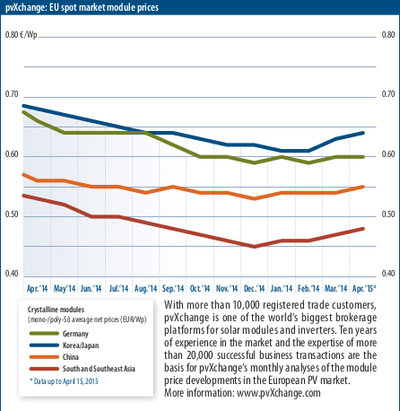 Module prices: Prices rise in March but not due to higher minimum price levels – the weak euro is to blame.
Module prices: Prices rise in March but not due to higher minimum price levels – the weak euro is to blame.
The steadily climbing prices for modules from outside the euro area have continued unfalteringly in the second quarter. One by one, Asian manufacturers have been raising their prices by a few percentage points, but ever so gradually, being well aware of the effect of higher prices. Only German manufacturers have managed to hold prices stable for the most part. A closer look reveals that, in some cases at least, stable prices can be traced to providers writing down inventories and selling modules at below list prices.
The wave of closures and insolvencies has, unfortunately, not yet subsided.
Just as the mercury climbs in the springtime, the demand for solar components also usually rises. After all, customers with their eyes on the bottom line want to take advantage of every last kilowatt hour they can squeeze out of their new PV systems at a low price. That regularly fills up the order books of installers. But this year is different. The sustained weakness of the euro exchange rate has pushed prices up continuously since the end of last year. Module manufacturers and distributors recently confirmed that the latest rise in the minimum import price (MIP) for Chinese products by three-euro cents has had a negligible effect on current prices.
The widening gap between falling feed-in tariffs and rising prices is creating a noticeable drag on a market in desperate need of a boost. Even the lower cost of energy storage systems has not helped pick up the pace of sales. Although there is good demand for small PV arrays with storage systems, and profits are steadily rising in the segment, this can hardly be called a boom. Of course, price-conscious customers are waiting for prices to fall even farther and for the technology to improve before placing their orders — if they do at all. Apart from those customers, this is a trend that is almost entirely limited to Germany. On the European level, widespread use of PV systems with smart power storage and energy management is still a pipe dream.
A small segment of the photovoltaics industry is enjoying increased demand, even if the cause is nothing to celebrate. With the end of winter and the severe storms in recent weeks, the demand for replacement modules has climbed sharply. Replacing a single defective module or entire strings keeps European installers and specialized wholesalers busy while bringing in healthy revenue.
Author: Martin Schachinger, pvXchange GmbH
March 2015: Uncertainty reigns
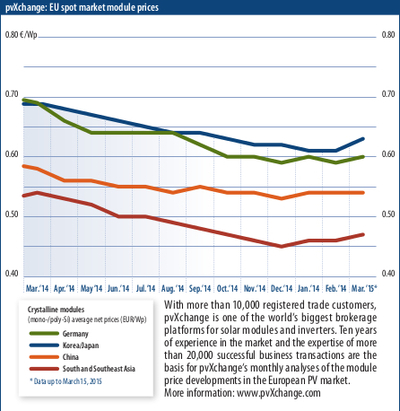
Module prices: A planned increase in the minimum import price undermines confidence in the European market. The first Chinese manufacturers are turning their backs on the “voluntary price undertaking” agreement between China and the EU.
Despite relatively mild temperatures, PV demand in Europe has not quite hit its stride yet. March saw a slight price increase for modules from all regions of origin. That was primarily down to the weak euro, however. Nevertheless, a general shortage of cheap Asian goods is discernible.
In Germany, despite the weakening market, a rise in feed-in tariffs for PV is nowhere in sight. Over the past half year, less than 100 MW of capacity a month has been installed. This represents a significant shortfall from the planned expansion corridor and should actually trigger an immediate rise in the feed-in tariff. This is sure to be a topic of discussion over the next few weeks.
February has already seen lively debate over Chinese solar producers such as Canadian Solar, ET Solar, and Renesola. The EU Commission has accused these manufacturers of evading on a massive scale the voluntary price undertaking, a negotiated agreement between China and the EU aimed at avoiding a rise in import duty. The companies under fire have reacted very differently to the accusations, from outright denials to disinterested shrugs. Renesola, for instance, has announced that it wants to pull out of the agreement altogether and simply accept the duty on Chinese goods. The company already manufactures its goods outside of China anyway, and a vanishingly small proportion of its solar panels are bound for the European market. Moreover, dropping the agreement would in many respects make life easier for the company. Other producers will likely soon follow suit.
In addition, rumors that the minimum import price (MIP) will be raised by three euro cents to the original level of €0,56/Wp are solidifying. Against this backdrop, Chinese manufacturers in particular have announced price increases of up to ten percent. As of the publication date of this article it is not yet fully clear whether this is just a marketing ploy European solar companies are using to put dealers and installers under pressure or if the price rise is actually necessary. Impending price rises are known to bring short-term increases in demand and stocking-up purchases. The idea is that this brings down existing stock levels faster before the new goods are delivered at the current import prices.
It is obvious, however, that the European market could not handle a general price increase in the single- to double-digit percentage range. Already catastrophically low demand would completely flat-line, and the body count of bankrupt solar companies would inevitably rise. To avoid this fate, the solar industry must once again come together in a concerted effort and send a clear signal to the European Commission and the European Parliament that the minimum import price and the volume cap must be scrapped and anti-dumping measures done away with before it is too late.
Author: Martin Schachinger, pvXchange GmbH
February 2015: Job losses despite protectionism
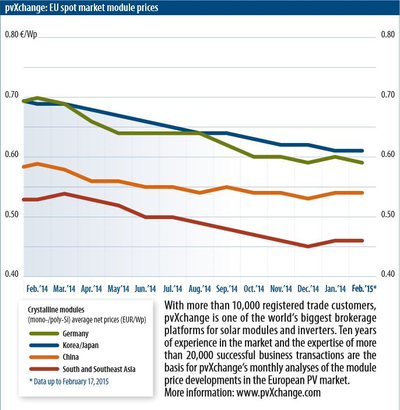
Module prices: The antidumping duties are not helping the European solar industry. Who wins, who loses?
A material shortage due to Asian manufacturers’ neglect of supplying the European market led to a slight increase in prices in January, despite restrained demand. The supply of polycrystalline solar modules from established Chinese PV manufacturers to the European market has slowed to a trickle. Feasible market prices simply no longer to conform to allowable sale prices. In many cases, high efficiency monocrystalline modules are the only ones that make it to market, which has necessitated an overall rise in prices.
The cost of products from Japan and South Korea were generally stable in Europe at the beginning of the year, all the more so because they occupy the upper end of the price range. Current fluctuations are more a result of rounding errors than trend indicators. German solar modules are slowly disappearing from the market, following the exit of Bosch, Conergy, Centrosolar, Hanwha Q Cells, and others. It’s anyone’s guess how long products from SolarFabrik and Aleo Solar will be available.
On the other hand, there are reports that the manufacturer Atersa has again started production in Spain and will offer European modules at a lower price than Asian imports. However, imports from regions other than China are not subject to price regulation. China, therefore, does not necessarily influence the market to the extent that everyone claims it does. At best, import limitations result in regional shifts and lull domestic manufacturers into a presumed sense of security until a rude awakening comes.
Who is benefiting from the European antidumping regulations anymore? Who profits at all from them, and who are the losers? Frank Asbeck’s SolarWorld AG, one of the initiators of the antidumping complaints in the USA and the EU, has managed to survive mostly from its international business. More than half of the company’s sales are now generated outside of Europe, and the figure is growing. Other European manufacturers, such as Norway’s REC Group, have also long since globalized their businesses. Although they still serve the domestic market, they manufacture their products almost exclusively in Asia.
Nevertheless, the EU commission is sticking by its import limitations. Rumor has it that the minimum import price (MIP) will even be increased in the course of this year. Southeast Asian manufacturers will have the most to smile about when they hear the news. These companies are already manufacturing their products with little price pressure and generally at full capacity. The orders are coming from large Chinese companies that have temporarily shifted their production. Whether this hastily established contract manufacturing is a sustainable business model and worth supporting remains to be seen.
In Europe, many PV wholesalers and installers have already dropped out of the market due to their product prices being unable to keep pace with the steadily declining incentives for PV. The result is a continuous erosion of the attractiveness of PV installations and demand. On the whole, this has probably caused a much more significant loss of jobs in the solar industry than the EU commission’s protectionist measures have saved in a handful of domestic production facilities. It is time to free up international trade in PV products again so that reduced costs and required price reductions can finally be passed on to the market.
Author: Martin Schachinger, pvXchange GmbH
January 2015: Further price reductions
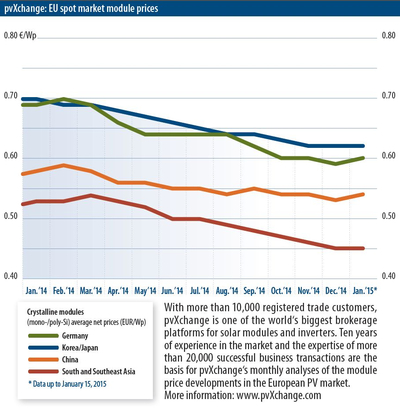
Module prices: A weak Q4 has once again led to a drop in module prices in Europe. Trina Solar and Yingli currently dominate the market.
Compared with the preceding month, module prices in Europe declined somewhat again in December. Existing stocks were apparently not reduced as quickly as PV manufacturers had hoped. As a result, further price reductions had to be granted for all types of modules and every region of origin. However, from today’s perspective it is not to be expected that prices will continue to decline. Many suppliers have now become cautious and adopted a wait and see attitude.
After the European PV market shrank continuously in the year 2014 for the third time in a row, special purchase orders seem to be the only way that modules from Asia are able to find their way to the Continent. As demand has built up early at the beginning of this year, triggered by mild temperatures, delivery bottlenecks have resulted – even in the case of standard modules from major manufacturers. In addition, the weak euro makes imported photovoltaic products more expensive throughout the entire value chain.
In the ranking of module suppliers with the largest sales figures, Trina Solar apparently outpaced the former industry frontrunner Yingli for the first time in 2014, according to the study conducted by IHS Technology. The list itself continues to be dominated by five Chinese companies which together delivered more than two gigawatts of output in the fourth quarter of 2014. Two Japanese and two U.S. companies also rank among the top ten. This development is fueled above all by the fact that these companies have healthy domestic markets where they are able to independently develop and realize major projects.
Germany no longer even plays a role in this league. German module manufacturers take the last places at best in the bid for the highest sales figures. In Germany the future is awaited with anxiety – particularly now that some passages of the German federal government’s more than 100 page regulation for bidding for solar PV projects have been disclosed. Insiders claim that the regulation represents a further nail in the coffin of the German photovoltaics industry. Apparently plans are to only develop a volume of 400 MW, which is, apart from the complexity of the bidding procedure, a further obstacle to the urgently needed development of renewable energies and recovery of the solar industry in the country.
One glimmer of hope for the German solar industry continues to be the sales figures for storage systems – in particular in the small systems segment, but in 2015 larger rates of growth are also expected for battery storage systems for commercial PV installations. For the time being, however, independence from legally prescribed remuneration, i.e. the Renewable Energy Act, appears to be the only way to rescue the German solar industry.
Author: Martin Schachinger, pvXchange GmbH
December 2014: Rock bottom
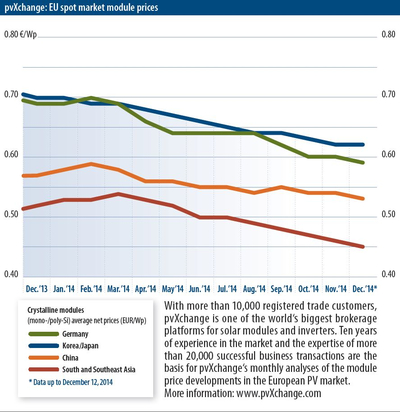
Module prices: The European photovoltaics market continues its downward trend. New concepts are making new inroads but slower than expected.
Dwindling demand in Europe has kept module prices under pressure. Nearly every product across the board, regardless of origin or brand, has fallen by a couple of percentage points over last month's prices. Although there were hopeful signs in early November that the downward trend may be coming to an end, the figures continued their fall – mostly at the cost of already paltry margins.
In Germany, 2014 was the saddest year for PV since the introduction of the German Renewable Energy Act. Never before has there been such a slow fourth quarter in Germany. But Germany is not the only country affected. Apart from the UK, all of Europe has seen an unheard of crippling of the market. PV as an investment model is apparently dead in Europe, and establishing new concepts takes time.
In principle there are two approaches the industry could take to jumpstart business in Germany: build PV plants with little dependence on the Renewable Energy Act and ensure the financial feasibility of the plants in other ways, or build PV plants that are profitable, despite the current feed-in tariff. The latter approach depends on low construction and other costs, as well as very inexpensive components. This generally necessitates the use of low-quality products with limited guarantees and/or ambiguous origin. Used equipment and first or second generation thin-film modules are in high demand for low-cost concepts. That raises the question, however, of how long such an installation can last. Such doubts lead to the failure of many projects because investors get cold feet at the last minute before construction begins.
The other approach, which relies on generating additional benefits or helping the operator of the plant achieve independence from future energy price developments by maximizing self-consumption, appears to be much more worthy of investor confidence and is more future oriented. However, this approach requires much more technical understanding and a higher level of consulting expertise. A previously very simple business model (an investment model with a return of x percent) based on simple plant technology, suddenly becomes a highly complex system which has to strike a balance between the energy supply, utility network requirements, and consumption behavior and in the best case reduces to a minimum the exchange of energy between the power company and the plant operator through the use of modern storage technologies. It is obvious that this stage of evolution, this rethinking and relearning for all those involved, cannot take place overnight.
Many companies saw this paradigm shift coming and the changes it would bring. All that is lacking are opportunities and endurance. There is little or no historical data for the numerous promising technical approaches, most of which are in the trial phase, on which to build a solid business. Many installers, wholesalers and some manufacturers have scaled back their business in the industry over the years, and others have been forced out entirely. But many small, flexible and highly innovative companies have remained and had the courage to tap new markets with reworked concepts and take advantage of the huge potential which doubtless remains in PV 2.0. It will be exciting to see which companies and products emerge as the stars of 2015.
Author: Martin Schachinger, pvXchange GmbH
November 2014: Dark skies over Europe – with a silver lining
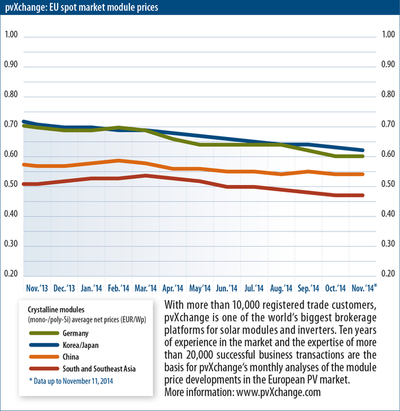
Module prices: Installation figures in Europe have continued to fall, and market consolidation is still in full swing.
These days you have to look very closely to see individual rays of light in the very dark skies above the solar sector in Europe. The installation figures for Germany reported to the German Federal Network Agency [Bundesnetzagentur] have dropped again, with September having the lowest monthly figure for several years, nurturing the certainty that the 2 GW threshold will only just be reached, if at all this year. The outlook is hardly better in neighboring countries where barely any major solar projects are being implemented.
Module prices, however, are not dropping to the extent that would be expected of them in this market. Many manufacturers are looking towards markets outside the European Union where PV companies are still enjoying a boom. Although it is not always possible to achieve higher margins there, it is at least still possible to supply megawatt projects with a certain level of commitment. By comparison, on the immediate borders of the European Union – for example, Turkey or some of the Balkan states – more hot air is being generated than actual installations. Nevertheless, when acquiring materials for projects outside the European Union, it is possible to identify where the module prices might be if there were no anti-dumping measures against Chinese manufacturers – that is around €0.40/W ($0.50/W).
The much vaunted small power plant business is proving to be difficult for many suppliers as consolidation of the sector continues to advance. Many producers are gradually getting rid of the distribution structures since more and more distributors are giving up. Another renowned German company with a long tradition, Energiebau, recently got into difficulties and had to file for preliminary insolvency. Other distributors are trying to make an orderly retreat from the PV business. In terms of the European energy policy, it is a sad outcome for an important pillar of the successful energy transition to be destabilized in this manner.
So where are those chinks of light? More money is again being put into research and development worldwide, particularly in the development of more efficient and reasonably-priced storage technologies. In addition to basic research into novel material combinations and industrial research for developing cost reductions, there is also increasing finance for pilot projects with large storage devices. At the same time, growing numbers of small power plants are being sold with integrated storage and energy management systems. It appears that people have lost confidence in an energy transition from on high and are now taking matters into their own hands. This will also lead to new business concepts – and gratifying new prospects.
Author: Martin Schachinger, pvXchange GmbH
October 2014: European survival strategies
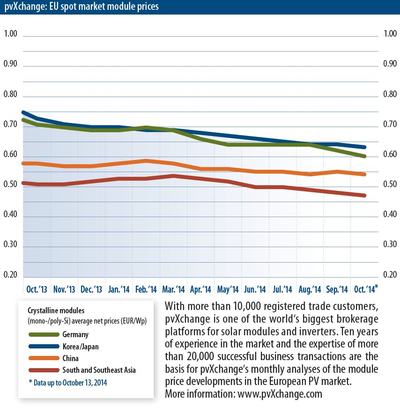
Module prices: Are new business models the solution to the crisis in Europe?
Another month has passed again without substantial stimulation of the European market. This can also be seen as far as prices are concerned. While the module prices of Japanese or Chinese manufacturers stagnated in September once again, values across all regions of origin fell slowly, but constantly since the beginning of October. There was a disproportionate decline in the prices for German modules after several suppliers again decided on a clear downward price adjustment due to sluggish sales. This adjustment this year is earlier than usual. Apparently reticent demand has already caused fear of surplus inventories at the end of the year and so precautions are now being taken.
Whether or not the reduction, in particular in the case of high quality products, will result in general stimulation of sales is questionable nevertheless. The presence of cheap suppliers from the Far East who constantly devise new tricks with which to circumvent the import restrictions of the EU Commission – which have now been reduced to a shambles – has become too pronounced in the meantime. At the same time, however, there is growing interest in used equipment or products that have been devalued for other reasons. Missing warranties in the case of insolvency or used goods is frequently unimportant as confidence in the warranty assurances of still existing manufacturers is no longer very conspicuous anyway. Installers prefer to purchase a few extra modules and put them aside for future replacements rather than rely on empty promises.
The declining business in new installations is forcing many established systems integrators to either retreat or to rethink their business strategy. In an environment where manufacturers are creating their own Web shops and selling their products directly to installers there is no longer any room for multilevel sales. Module manufacturers do not shun doing business with small quantities or complete systems and some of them have even established their own lines of inverters. Thus it comes as no surprise when equipment and systems traders begin to abandon the distribution business and try their luck exclusively in the project planning business and in the operations and maintenance (O&M) segment.
However, the O&M segment is highly competitive. Companies that already have large parks under contract have a clear advantage over newcomers. Takeovers of entire companies or divisions are common practice, just to gain access to maintenance agreements. No one is willing to voluntarily sacrifice more or less lucrative agreements that may provide for solid and, in contrast to the trading business, predictable basic income. Recently large inverter manufacturers have begun to discover the market for themselves – like SMA Solar Technology AG, which recently took over the European O&M business of Phoenix Solar AG – an obvious step as the company is already involved in numerous projects through its service agreements. Consequently, it can also provide maintenance for other material. This is efficient and saves money for the operators.
Apart from monitoring, the added value in the case of service agreements consists in regular cleaning and maintenance, but also above all in repairing system failures due to damage (e.g. from hail, storms, fire, theft) or in the case of power losses (faulty system design, assembly or product errors). The demand for replacement modules and inverters constantly increases with the number and age of the installed systems. However, procurement of suitable replacement or substitute products is not always easy. Rapid technological development and the disappearance of many manufacturers have resulted in the fact that most original products are no longer available at ordinary stores. Installers and plant operators receive support in the search for suitable replacement products, among other things, from specialized trading platforms that offer new and used equipment with the most diverse specifications.
Through repair, optimization and maintenance of existing systems, solar companies help to maintain and increase the contribution made by the photovoltaic industry to the electricity mix as a whole and to confirm general confidence in the reliability of this technology. Of course jobs are also saved as a result because the market for existing PV installations will not become smaller in the foreseeable future, even if construction of new installations should remain in a state of decline.
Author: Martin Schachinger, pvXchange GmbH
September 2014: Dying a slow death in Germany
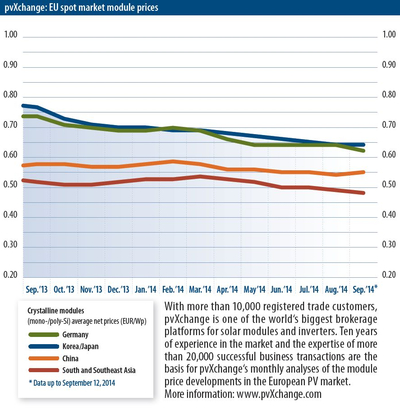
Module prices: The minimum price regulation paralyzes the European photovoltaic market.
The existing EU minimum import prices for Chinese modules and cells are preventing a much-needed downward price adjustment for products of all regions of origin. The prices are still largely stable. Delivery volumes from Asian manufacturers for the European market are, at the same time, being progressively reduced. The action has, for quite some time, been found on other continents. While module prices for so-called non-EU projects, i.e. photovoltaic plants that are being built beyond the control of the EU Commission and its regulations, are once again (or still) located in the lower 40 eurocent range, prices within the European Union are stagnating just above the 50 eurocent mark.
The high-price policy prescribed by the European Commission is obviously not designed to help European manufacturers survive, let alone grow, in the face of tough international competition. At best it prolongs a slow death by a few quarters. Once successful trading houses and system integrators are continually having to give up, either through bankruptcy or withdrawal from the distribution business. Both the market and the business model itself are breaking down on them. Continuous, reliable supply, interim financing and good service have simply become uneconomical. The few goods that are currently in demand are forging their way ahead, but without the wholesale trade in the classical sense.
After years of growth, Germany will this year probably for the second time in a row see a market decline of at least 30% compared to the previous year. The energy transition is unnecessarily being hindered and delayed. The much-cited cost brake is being applied at the expense of renewable energy and, cynically, at the expense of consumers. Industrial electricity prices have, in contrast to end-consumer prices, not increased over the last ten years, as the German Association of Industrial Energy and Power Business (VIK) has found. Even the German Renewable Energy Act (EEG) surcharge account is currently well back in the black, although so many energy-intensive businesses continue to be exempt from the levy – the newly introduced participation of self-consumption power plants in the EEG surcharge is therefore likely to be totally unnecessary and counterproductive.
What would save the German and European photovoltaic market is an immediate abolition of the EEG surcharge on self-consumption, the removal of all administrative hurdles for the direct marketing of solar power, the abolition of the minimum price regulation and the restrictions of the import volume for crystalline Chinese cells and modules, and a simultaneous, complete waiver of import tariffs by the EU. At the same time the connection and feed-in priorities could be qualified so that only those photovoltaic plants technically in a position to guarantee the network stability at individual grid connection points may feed in. The solar industry already possesses sufficient strategies and policies to deal with this qualification.
Author: Martin Schachinger, pvXchange GmbH
August 2014: Taking a breather
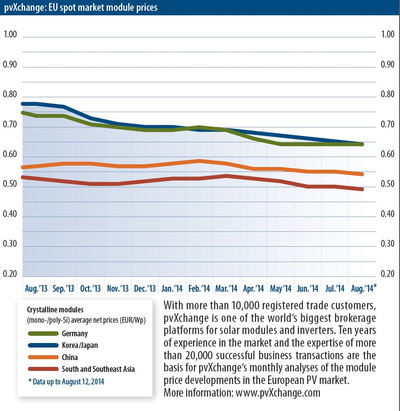
Graphic: Solarpraxis AG/Harald Schütt Module prices: July and August showed little movement in solar module market prices. The industry is searching for ways out of the summer slump.
The prices for modules from all regions of origin stayed mainly at the previous month’s level in July. Isolated fluctuations had no effect on the averaged prices. The initially brisk demand in the European market – driven by the date of the amendment to the German Renewable Energy Act – leveled off again towards the end of the month. It appeared most installers had already stocked up on materials by then and were busy completing as many projects as possible by July 31.
As expected, August has now got off to a quiet start – the industry is taking a breather. It’s vacation time at present in many European countries and as a result, domestic demand has dropped to practically zero. In many places, even the weather conditions are against any installation activity with the sun also taking time out.
So there’s currently plenty of opportunity to reflect on the future of PV in Europe and develop survival strategies. Demand may be increasing globally – China, Japan, some Central and South American countries and even South Africa are becoming conspicuous – but European companies can’t readily access these regions. The Asian markets in particular are pretty tightly sealed against foreign investors. “Expertise, yes please!” but then the money’s supposed to stay in the country. This is where the industry could do with more support from the politicians.
What exactly are the recipes for success for companies that rely on their domestic market? Small and medium systems with energy storage devices which cover the majority of the operator’s own consumption no longer pose a problem technically speaking. In Germany such systems are also increasingly interesting from an economic point of view, in spite of the Renewable Energy Act levy for systems above 10 kWp. The range of storage systems suitable for households is expanding constantly and the components are becoming more and more reasonably priced. The German market leader Sonnenbatterie, for example, recently introduced a slimmed-down version of its LiFePo energy storage device. The sales price for this has been reduced by 40% compared to the standard product.
Another future market could be heat generation using PV, several prominent scientists confirmed. The advantages of a combined system with intelligent control are obvious – solar combined heat and power generation, so to speak. Unlike the classic solar thermal systems, which must first reach a certain temperature level before there is an uncontrolled discharge of all the energy to a storage device that frequently suffers from high losses, the energy generated using PV can either be consumed directly, stored in the interim or converted into heat if such heat is also required. There are already several technical solutions for this on the market which are more or less mature.
In the high-capacity PV power plant sector, it appears that in future the tendering model will establish itself throughout Europe. At least this is the direction in which all the considerations and announcements of various politicians are pointing. However, it’s appropriate to ask whether the concept might not turn out to be something of a damp squib given the complicated procedures and maximum price limits, such as was once the case in Spain. In Germany, lower component prices than those we are still finding at present – the reasons for this also being political – would be needed for the economically viable construction and operation of large-scale systems.
It is for the reasons outlined above that the demand for second-hand modules or other competitively priced remnants is rising constantly at the moment. Really good offers on second-hand goods are rare, however, and the risk of a bad buy is quite high. At any rate, the offer should come from a reliable source, the origin of the modules and the reason for their removal should be well documented and, in the ideal case, they should be supplied with up-to-date measurement records. In the remnants sector, we should mention thin film modules. In most cases, these are products from the last-but-one generation (using amorphous silicon) that are now being brought onto the market at significantly discounted prices, or possibly bankrupt stock (CIGS or microamorphous modules).
Many formerly hopeful thin film suppliers have unfortunately left the market again. At present there is (too) little movement in the area of new solar cell technologies although the anti-dumping measures for crystalline cells and modules in the USA and Europe must have provided a little breathing space for some manufacturers and developers. Where’s the pioneering new product that puts all the others in the shade in terms of its price-performance ratio and where's a new “First Solar”?
Author: Martin Schachinger, pvXchange GmbH
July 2014: Growth in demand stymied in Germany as solar booms in UK, Japan
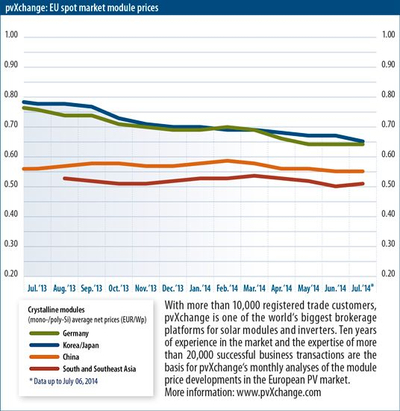
Graphic: Solarpraxis AG/Harald Schütt Module prices: Upturn in German market demand short-lived as global growth picks up speed
In the course of June, module prices from all regions of origin fell to the lowest level so far this year. This development was arrested at the turn of the month, the curves flattening out in early July or even partially turning up. The expected growth in the market, brought about by the announcement of the amendment to the Renewable Energy Act (EEG) in Germany, has made itself felt both in prices and delivery times. Suddenly not all module types are immediately available. Since, however, many projects are supposed to be online by July 31, there is a run on European stock items.
The aforementioned growth in demand is, unfortunately, very modest and not to be compared with the hysteria of previous years, in which enterprising traders, by way of precaution, filled their warehouses to the brim. On the whole, confidence levels of the project planners and installers for July are already dimmed since assembly capacities are already fully stretched until the end of the month. And new projects have been put on hold until the text and date of the Renewable Energy Act amendment have been fixed. It appears, however, that the August 1 date can be met after EU Commissioners withdrew their opposition and gave the go-ahead to the retention of industry privileges. The burden of the energy transition will therefore continue to rest primarily on the shoulders of consumers and small businesses.
After the sobering reports from the German market, however, there is also good news regarding the photovoltaic expansion numbers in England and Japan. In the last four years we have only been able to dream of such growth here. For example, between the second quarter of 2013 and the second quarter of 2014, a total of 7.185 GW of solar power capacity were installed in Japan. Kyocera also announced the design of a 430 MW project in which a German project development company is also to be involved. And that even though local feed-in tariffs had already been lowered by 11% since April.
In the U.K., photovoltaic systems with a total capacity of 1.47 GW have been installed this year, almost 50% more than in the entire previous year. And 2013 itself was a record year in terms of growth rates.
Reports with similarly positive messages reach us on a weekly basis from Chile, announcing the construction of increasingly large projects. The currently installed photovoltaic capacity in Chile to May was admittedly still very small at 176 MW. However, this almost doubled in June with the inauguration of a 100 MW solar power plant, which was designed and built by the Chilean subsidiary of the American project developer SunEdison. A further 72 MW solar project from SunEdison and another from and with First Solar, providing 141 MW, are coming soon.
Despite recent reports from companies such as juwi and Belectric, it remains to be seen which of the German project developers, which for a long time led international rivals by a significant distance, will join in and grow with the globalization of the photovoltaic industry. Hopefully a few of them will actually be involved!
Author: Martin Schachinger, pvXchange GmbH
June 2014: Summer boom expected
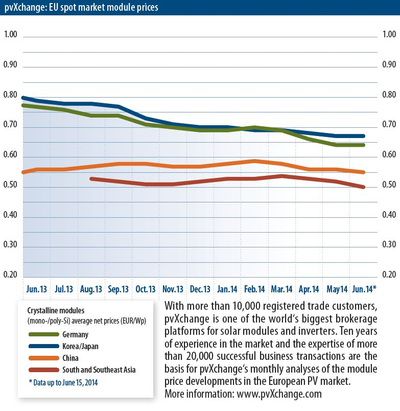
Module prices: Calm before the storm
The prices for modules from China enjoyed a breather last month while the few products from Germany that remained on the market continued in their race to catch up. Huge price differences still exist, however, between German or European goods and those from China and Southeast Asia.
Large farms are now only implemented with module purchase prices below the €0.50 mark. Small systems on the other hand, which in Germany are now often equipped with storage technology and energy management, are not as price-sensitive. Here it is still possible to use modules that have prices fluctuating in the region of or above €0.60 per watt like most of the products from Germany, Japan or Korea.
The highest demand within Europe is still from the United Kingdom, where new megawatt farms are constantly springing up. A steep rise in installation figures, however, is also expected for Germany in June and July since on 1 August 2014 the Renewable Energy Sources Act will again be adjusted, making a further expansion of photovoltaics even less attractive. Consequently, everything that is already at an advanced planning stage and that can also somehow be completed must be connected to the grid by the end of July.
At Intersolar, Europe's biggest solar trade fair which again tempted many industry players to Munich at the beginning of June, it was not only good and above all value-for-money products that were sought after but also ways out of the crisis. Many exhibitors offered “intelligent” system solutions with storage systems and energy management. Given the “solar tax” still publicized by German government representatives, i.e., the contribution of private and commercial PV systems to the Renewable Energy Sources Act levy, it is doubtful whether these complete and frequently also complex solutions will become the universal remedy. Here too, profitability and therefore marketability are determined by the purchase prices of the individual components. Storage systems, however, are still not so reasonably priced that they can automatically be integrated in every project. Practicable solutions are still being sought in vain for medium to large-scale plants.
As a result, module and inverter prices are still what tips the scales – they are the deciding factor for the attractiveness of a PV investment. And, as already explained initially, the requirements and ideas of many buyers are very ambitious. As a result, prices are being driven further downwards, regardless of the EU regulations and the ambitions of SolarWorld CEO Frank Asbeck, who is continuing undeterred to fight against Asian dominance in cell and module production by recently announcing 1,000 infringements against the European-Chinese minimum price undertaking.
But what use to all of us are prices that are kept artificially high if we lose the market in the process? The market demands reasonably priced products and will ultimately be served by whatever tortuous paths necessary. For those involved it will only become riskier. In the end, the winners will not be those who are quality-aware, careful and honest. No, it will be those who are ruthless and irresponsible, the players who are still in at the end of the game. We must apply the lever somewhere else entirely – or simply attempt to play along in the globalized market.
Author: Martin Schachinger, pvXchange GmbH
May 2014: Downward adjustment
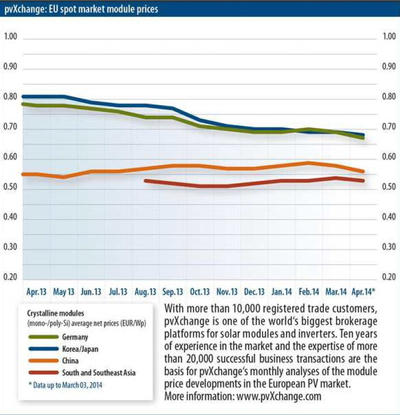
Modules prices: Waiting for lower solar panel prices. Is the minimum import price reduction already making an impact?
Many Asian manufacturers are already openly discussing price cuts, which had, however, already been gradually introduced some time ago. Wide-ranging price reductions were on the horizon in April, but have not really materialized yet. Around the Easter weekend, the entire market seemed to be on vacation, and the price reductions may have not been communicated. Demand plummeted significantly over Easter, but no major price change was to be seen in April. Chinese manufacturers are leading the way to price cuts, with all others having to follow suit. February’s price increase of Asian products was of short duration and is expected to be reversed. This downward adjustment is urgently required, at least in the European market. The challenge now is to improve the subdued mood and end the general paralysis clouding the market despite perfect weather conditions for PV installation. After a quiet February and a sleepy early March, customers and installers are finally waking up. In late March and the first weeks of April, more orders have likely been placed than in the entire previous weeks this year.
The situation is becoming trickier for Chinese PV manufacturers. Over the last few months goods have piled up, creating not insignificant stock levels. Many suppliers have imported their modules or stored them in European customs warehouses without having a buyer, in order to avoid losing the allowed quotas. A reduction in the approved amounts looms if the negotiated import volumes are not consistently achieved.
The market slowdown in Europe has put China’s solar companies under pressure and ultimately led to new negotiations with the European Commission (EC), which has evidently been persuaded that changes are needed. The new minimum import price, which ranges between €0.53 and €0.54 per watt, according to unconfirmed statements, is at a level that has already more or less established itself in the market through sophisticated evasive tactics on the part of the manufacturers and importers, in defiance of EU directives. These tactics could prove costly to some manufacturers, however. Entire ship loads are currently being subjected to special investigations by customs authorities and are therefore missing from the market. Some contingents are even being withdrawn from Europe after weeks of the customs blockade. This will presumably have no effect on any further price trends, however.
Author: Martin Schachinger, pvXchange GmbH
April 2014: Little movement
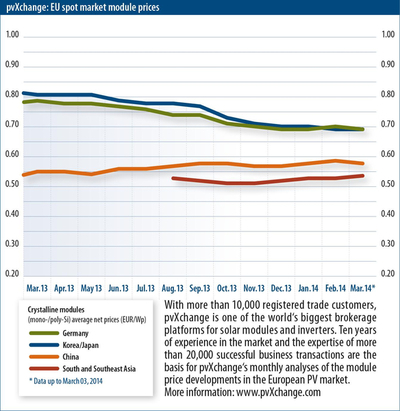
Modules prices: Modules are generally available – but not necessarily when it comes to inexpensive alternatives.
There were no real surprises in terms of the development of prices in February and March. Very little movement can be seen on the market at present. The average prices have only shifted by plus/minus one cent around a stagnating average value for several weeks now. The upward trend among prices for crystalline modules from Southeast Asia has also come to a halt. In the price ranking, Germany changed places with Japan/Korea and moved up to No. 1 – thus products from Asia are again more inexpensive than European or German PV modules.
Altogether though, prices are still too high to step up demand. Inexpensive alternatives are in demand – but rarely available. The employment of thin film modules is being considered again for the first time, in particular for larger photovoltaic projects in Central Europe. In recent weeks pvXchange registered increasing demand for thin film technologies. However, the offer is quite modest for lack of existing manufacturers. Numerous production facilities were ramped down in the past two years or shut down completely. Modules made from amorphous silicon are available as leftovers at best, while tandem and/or hybrid modules (a-Si/µ-Si) are barely manufactured due to a lack of demand. The few remaining manufacturers of this technology predominantly supply their products to projects near the equator where the modules prove to be especially effective due to their thermal properties and where the market is not as sensitive to prices.
The former thin film star First Solar is almost completely out of the picture. Distribution has been reduced to a minimum. For the most part only complaints are handled and, in small measure, plant extensions – but at less than attractive prices. After the company’s experiences with performance degradations that affected supplied products as a result of a production error in the year 2011, which led to large-scale recalls and replacements that persist to this day, First Solar largely withdrew from the European market. Today the manufacturer appears to produce its cadmium telluride modules predominantly for its own projects in the multi-megawatt segment in the USA and Asia.
Although CIGS modules can already keep pace with the efficiency of the crystalline competition, the active module surface and the maximum performance class are still much smaller with around 150 Wp for series products. In addition the specific prices are almost without exception above those of crystalline modules from all regions of origin – which disqualifies the product for larger photovoltaic systems. As a result the attempt has been made for years to position the company in the premium segment particularly among small-scale systems. However, brands such as SunPower, Panasonic, BenQ or LG with their high-performance crystalline cells are much more successful in this segment.
So Mr. EU Commissioner, what then remains in the lower price segment? Prices clearly below the fifty cent mark can only be realized in the European Union with no-name modules from often dubious sources, insolvency goods or scrap production. A switch to second class merchandise with reduced warranties or insolvency goods entirely without warranty is not an option – at least in the case of medium-sized to large-scale projects where price sensitivity plays a role, because investors and banks do not play along in most cases.
Author: Martin Schachinger, pvXchange GmbH
March 2014: A rough wind
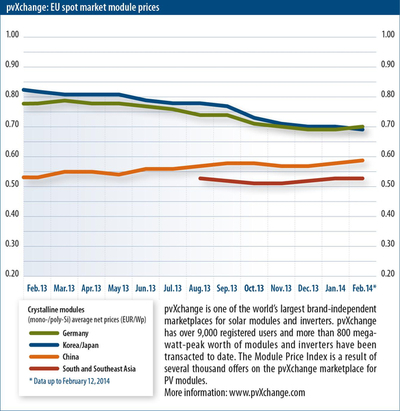
Module prices: Continued low demand and cuts in the remuneration for European PV systems invoke the specter of a renewed collapse of the market.
While the prices for German modules and products from Japan and Korea remained stable, products from the remaining Asian regions showed a slight price increase over the turn of the year and modules from several Asian countries such as Malaysia, Taiwan and the Philippines increased in price yet again. This is most certainly attributable to heightened interest in modules that continue to be approximately 10% less expensive compared with Chinese products.
Despite the mild temperatures, demand in Europe remains behind expectations that had budded in January. Apparently the urge to make purchases and carry out installations has been decidedly decelerated by the persistent bad news from policymakers. Price enquiries frequently fail to result in subsequent purchase orders. Often the desired profitability of a PV system cannot be materialized due to continued stagnating component prices and diminishing feed-in tariffs.
A slowdown of this degressive adjustment in Germany is a long way away from being enough, an increase in remuneration alone would be able to prevent a further collapse of the market – but this presumably remains wishful thinking in light of the current political constellation.
The energy regulatory authority in France (CRE) also made further cuts and specified new feed-in tariff rates that apply for PV systems as of March 2014. Meanwhile in France there are invitations to tender for installations with a rated output of more than 100 kWp, so that these no longer participate in the feed-in tariff program. The French government increased the annual target for additional installations in March 2013 from 500 MWp to one gigawatt. Nevertheless, only approximately 743 MWp were installed altogether in the year 2013. This was the second year of decline.
The British Office of Gas and Electricity Markets (Ofgem) also published new feed-in tariff rates that will apply as of April 1, 2014. The remuneration for solar electricity from PV systems with a rated output of less than 50 kW declined by 3.5%. Moreover, according to information from government circles, efforts are being made in general to get away from subsidizing larger photovoltaic power stations through feed-in tariffs – first through cuts in the Renewables Obligation (RO) program and now through the new program “Contracts for Difference” for power stations with more than 5 MW of rated output.
All in all a much rougher wind than before is blowing for renewable energies in Europe – which does not make the market particularly interesting either for manufacturers or for investors. For these groups other continents are moving increasingly into the focus. Has the proverbial “caravan” finally drawn past Europe, or can it still be stopped?
Author: Martin Schachinger, pvXchange GmbH
February 2014: Reserved
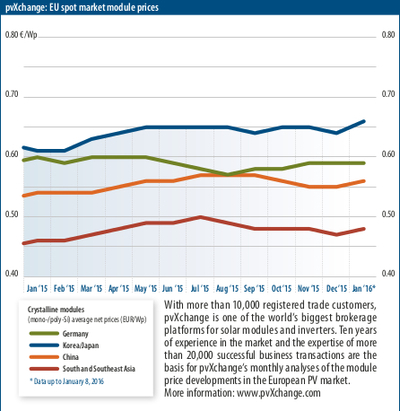
Module prices: Prices have hardly changed over the turn of the year. Will there still be a solar winter and, if so, how long will it last?
The market appears to be like the weather in Germany – mild temperatures in January accelerated the inclination among Germans to purchase photovoltaic power plants and components somewhat faster than is otherwise the case at the beginning of the year. But nevertheless, ice and snow will inevitably let the German market freeze. Stagnating prices for cells and modules at declining rates of remuneration will then take care of the rest.
As already expected, the prices for crystalline modules from every region of origin have hardly changed over the turn of the year. The trend even appears to be shifting slightly upward, since inexpensive remaining shares have been almost completely swept from the market.
Regular commodities from China cannot be obtained in the EU below the agreed minimum price. Although all kinds of tricks are used with which importers believe they are able to circumvent the antidumping directives, this is not without substantial risks. Thus every prospective buyer would be well-advised to have the origin of the modules – as well as the cells employed – precisely documented, even if the buyer will not be directly affected by a subsequent penalty duty. Any possible warranty and guarantee matters are clarified more easily if the upstream supplier still exists and is able to be identified.
The strongest demand in Europe is currently in the United Kingdom. Project developers have to complete their large power stations before subsidies within the scope of the Renewables Obligation (RO) program are to be cut in the second quarter. According to their own information several European module manufacturers are providing supplies almost exclusively to the British Isles.
In the rest of Europe demand is more reserved, at least as far as conventional PV installations are concerned. However, tests of alternatives beyond state-controlled remuneration rates can be increasingly seen. The market for energy storage remains one of the greatest sources of hope in the year just started, ushered in by numerous product announcements and supporting information events and conferences.
It will also be interesting to see whether the list of 109 photovoltaic companies that are particularly eligible for subsidies as recently published by the Chinese government will lead to disruptions among the Chinese industry. Only those companies that appear on this list from the Ministry of Industry and Information Technology (MIIT) may look forward to further subsidies as well as participation in government invitations to tender. However, not all analysts and market experts share the opinion that this will lead to accelerated consolidation among Chinese manufacturers.
Author: Martin Schachinger, pvXchange GmbH
January 2014: On to the next round
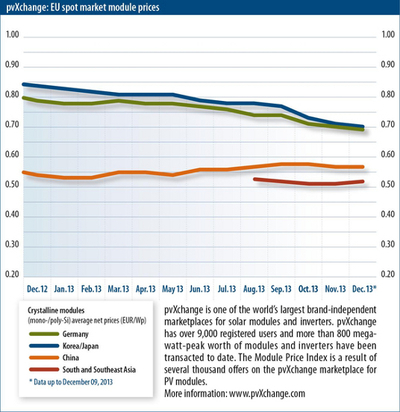
Module prices: After the game is before the game. The year 2013 in review.
Although the downturn in prices for Japanese and German crystalline modules on the European spot market slowed in November, it could not be stopped. Even prices for modules from China gave way again. Only the prices for imports from southeast Asia stabilized, with a slight upward trend towards December. This development is explained by largely exhausted import quotas and simultaneous sales of the abundant goods stocked from China at reduced rates.
The year 2013 was calm as far as general price development was concerned. If prices in 2012 only saw one direction, independent of the respective technologies – downward – they remained quite stable over 2013, and have even converged. Prices for Chinese and southeast Asian modules are currently only 18-25% below the prices for products from Europe and Japan. In January 2013, China’s module prices were still 36% below those of Japanese products. Since then the Japanese market has cooled down somewhat, in turn bringing more Japanese and Korean goods to Europe.
Over the year as a whole, modules from Japan and Korea have put the largest downward adjustment behind them, with just under 15%, while markedly smaller changes were to be seen among German modules, with -10% and Chinese modules, with a 7.5% rise. In 2012, prices fell by 30%, on average, from January to December, and in the years before that, even more. This dynamic movement is no longer to be expected in the future.
In 2013, the PV market was characterized by cuts in the feed-in remuneration and/or solar subsidies in many European countries. Many ostensibly healthy enterprises struggled or had to give up completely. In the best cases, orderly insolvency proceedings were conducted independently. An investor did not always come along from the Far East to save the day. Several well-known names and brands fell by the wayside.
Since the end of 2012, the worldwide PV industry has been concerned with anti-dumping and anti-subsidy campaigns. At first there were just a few participants, starting with the USA opposing the threatening market supremacy of Chinese module and cell manufacturers. The result is well-known – the EU commissioner in charge reached agreement on minimum prices and maximum import quantities with most Chinese manufacturers. However, European manufacturers – for whom this support frequently came much too late – were not necessarily the beneficiaries of the trade disputes.Instead smaller and, up to now, insignificant module and cell manufacturers from the remaining Asian region reaped the benefits by experiencing a boost in demand, particularly in Europe in the last quarter of 2013. That resulted in a boom comparable only to when Chinese manufacturers entered into the German and Spanish market in the years 2006/2007.
The consolidation – an elegant euphemism for company mergers and failures – among manufacturers, wholesale dealers and project developers in Europe will presumably continue this year. Other big names will disappear, but new stars will also appear time and again. SolarWorld will buy the solar division from Bosch – or will it be the other way around? Let’s wait and see.
Author: Martin Schachinger, pvXchange GmbH
December 2013: End of the year spurt
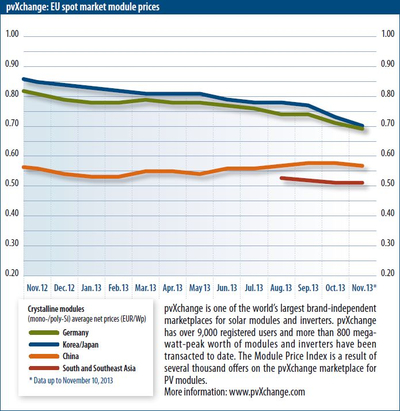
Module prices: The stagnating European market and inventory clearance sales have sent prices plummeting at the end of the year.
After weeks of stagnating prices, a slow but constant decline in prices began in October, particularly for modules made in Germany and/or Europe, but also for products made in Japan and Korea. Thus last month’s assessment indicating a lack of movement has to be corrected. Apparently there is still quite a bit of latitude for price reductions, precisely when it comes to previously more highly priced products. Where the causes of these reductions are to be found and whether or not this trend will continue will be analyzed in the following overview.
The prices of German products in particular are rapidly moving in the direction of those of Chinese manufacturers – they showed an overall reduction of just under 4% within the month of October, and this trend is continuing. The price decline among Japanese and Korean brands was even greater. Up to now they had remained at a high level – now, however, the prices for these products have moved as much as 5.2% in the direction of the rest of the Asian competition.
The prices for silicon, ingots and wafers are currently at an all-time low. However, this is not merely a development of recent weeks – and thus is not suited as the sole explanation for the current situation. Instead, the reasons can be found in an increasingly weak European market; the figures on additional installations send a clear message that cancels out quick sales of the respective commodities and inevitably results in inventory surpluses. Chinese manufacturers evidently underestimated local demand and/or have thus far been unable to build up sufficient sales pressure. Now they are forced to determine what to do with the import quantities granted to them on the European market in the weeks to come.
The strong decline in prices in the group of manufacturers from Japan and Korea is primarily due to the sudden appearance of a number of very inexpensive Korean modules. When it comes to forming average prices these ample and often large contingents – compared with the rather modest offers of Japanese origin on the spot market – have a very dominant impact.
In contrast, the development of prices among German products is currently shaped by warehouse clearances and sales of remaining stock. New insolvencies are being announced by German manufacturers and wholesale dealers almost on a weekly basis. For fear of being stuck with less attractive goods without any warranty claims, high depreciation allowances are accepted while the products of faltering manufacturers are jettisoned as quickly as possible. How quickly a once highly coveted product can lose its value on the market when a manufacturer gets into trouble was clearly demonstrated in the case of Suntech Power, the formerly premier Chinese solar company.
Any fear of missing the boat among installers and investors is a thing of the past. This time the end of the year spurt will presumably take place among manufacturers and wholesale dealers, so we can still expect to see several surprises on the module market in the weeks to come.
Author: Martin Schachinger, pvXchange GmbH
Read the full entry in the December edition of pv magazine.
November 2013: Price movements level off
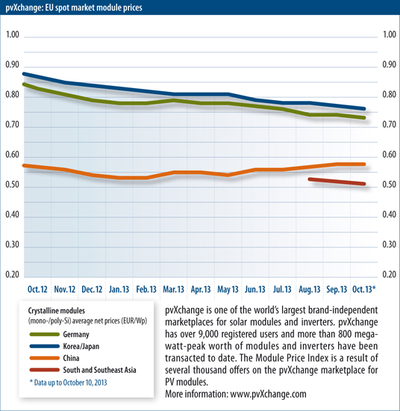
Prices are generally stable. How can Asian manufacturers continue to stand out from the competition?
Prices on the European photovoltaics market have been largely stable now for several weeks. Hardly any upward or downward outliers can be registered. As already mentioned last month, two price levels are becoming increasingly clear for Asian modules – one for modules that stem from Chinese production, which is subject to the EU agreement and thus a restriction on imports; and one for modules from the rest of the Asian region – for which there are no regulatory matters. With the pvXchange Module Price Index we took account of this through the introduction of a new price curve last month. This new curve is also largely horizontal.
While price movements on the module market are tapering off, the producers on the other hand are outdoing each other with one new record after the next as far as cell and module efficiency are concerned. The strategy, on the part of Chinese manufacturers in particular, appears to be that, if prices can no longer be varied as a result of the EU Directive, at least the performance of the modules sold at a specified price should be constantly increased. At the moment it is becoming clear that hardly any modules below the 250 watt mark are still being put on the European market by the leading Asian manufacturers.
Another effective means with which to justify higher prices is known to be better service. However, a number of suppliers of photovoltaic technology continue to have a problem in this regard. The European offices of Chinese manufacturers are being closed or reduced to only a few staff. New, comparatively small Asian producers are unable and unwilling to afford representative European offices as long as market prospects are so incalculable. Unfortunately, wholesale dealers and distributors, who normally would be able to take over such service for the respective manufacturers, are disappearing by the dozen. Thus, there is still ample room for new ideas and approaches – outsourcing of after-sales services, as already practiced by First Solar, represents only one of the possible solutions.
Hopefully a lot of manufacturers will at least enhance their product quality accordingly and incorporate additional quality assurance measures into their manufacturing operations in order to ensure just that. This is the first place where manufacturers looked to save during those periods of the lowest prices. If this austerity policy is now finally a thing of the past, then the antidumping proceedings conducted by the EU Commission would in fact have an upside. Good quality comes at a certain price – this goes without saying. However, the solar industry has increasingly come to learn that a much higher price has to be paid for poor quality – plant operators and insurers certainly have their own stories to tell.
Author: Martin Schachinger, pvXchange GmbH
Read the full entry in the November edition of pv magazine.
October 2013: New low price suppliers
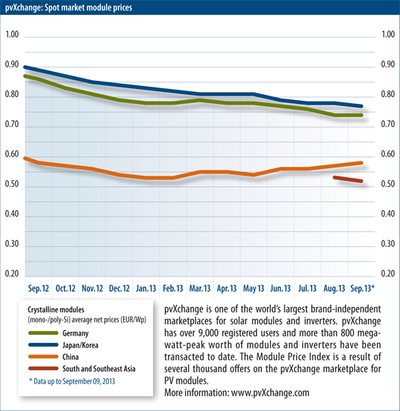
The negotiations concerning the import prices for modules from China and modules with Chinese cells, together with the EU Commission’s antidumping proceedings and the temporary agreement with a majority of affected manufacturers are already leaving their mark.
Supplies from China still dominate the worldwide PV module market; they are, however, no longer the lowest-priced PV panels in the EU. It is important to differentiate between the goods imported and declared before the August 6 and those imported more recently. This results in two possible prices – the former generally below and the latter considerably above the magic number: €0.56/Wp. The lower-priced goods are becoming increasingly scarce and may well disappear in the near future. All well-known Chinese brands are now available in almost any quantity but at a price of around €0.60/Wp, plus a waiting period for delivery is to be accepted as they must first be brought out of China. This availability in the EU is, of course, a direct consequence of the regulated import prices. There is hardly a project of any size in the EU that can cope with this current price level, resulting in projects being shelved until more cost-effective alternatives can be found.
These alternatives are emerging from an ever-widening range of Southeast Asian suppliers. These newcomers, who were completely unknown and unnoticed in Europe up to now, are enjoying growing popularity due to their very attractive price level. The countries of origin are Vietnam, Malaysia, and, of course, Taiwan. Many importers can already offer quotes on some of these new brands, the quality of which, however, is largely unverified and unknown. The prices of these modules are in the region of €0.50/Wp, assuming container delivery. A familiar challenge now awaits investors and banks: the inspection of certificates, measures of quality assurance and the reliability of the manufacturers – in short, their bankability. Existing whitelists are becoming obsolete.
This development has prompted us to adjust the pvXchange Price Index. In future there will be a new graph or rather, price point, representing the spot market price of crystalline modules from these countries. We will call this group “South and Southeast Asia,” incorporating the above-mentioned countries plus Thailand, Indonesia and India. The average market price quoted for this group can also be applied to those Chinese modules which need not be imported into the EU – it gives, so to speak, a general picture of the world market price for Asian goods. The price curve for Chinese modules will be continued, representing imports into the EU. At the same time we will discontinue the price survey for thin film modules. As reported in a previous article, it is no longer possible to provide a representative average price survey due to a lack of appropriate products and offers.
Author: Martin Schachinger, pvXchange GmbH
Read the full entry in the October edition of pv magazine.
September 2013: The end of free enterprise or a new dawn?
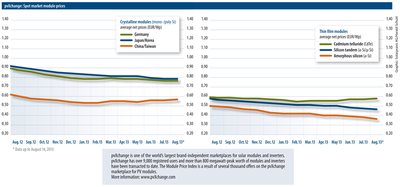
The discussions on antidumping tariffs for Chinese cells and modules in the EU finally came to an end a short while ago. As is well known, minimum import prices and maximum import volumes were agreed upon. Prices fluctuated until the middle of July in the face of the ongoing discussions and have been effectively frozen since the end of the month. Now there are hardly any goods to be found on the market below the EU-mandated €0.56 mark. At least the uncertainty and speculation are now at an end. Conditions for those Chinese manufacturers that have submitted to the price and volume restrictions are fixed and, at least for the time being, not up for negotiation.
However, the major manufacturers in China are under no pressure to sell. They are increasingly selling their products, often at higher prices, to clients outside Europe, some even achieving record quarterly sales figures. Trina, Jinko, Canadian Solar and ReneSola share almost 40% of the world market between them but have not had a major presence in Germany or the EU for a long time. Hanwha, increasingly attempting to establish itself with Q Cells in the premium price segment, has ruled itself out as a supplier of low cost solar modules, along with other big suppliers from South Korea.
It remains to be seen whether smaller manufacturers from Taiwan, other parts of Southeast Asia or even India and Pakistan will be able, in the foreseeable future, to fill the vacuum which has been created in the lower price segment. Before Chinese manufacturers cornered the European market, perfectly viable products were available from these regions in the mid-2000s. Indian module producers in particular were neck and neck with the competition from China in the race to take market share away from the (at the time) dominant Germans, French and Spanish. However, once the domestic market in India was discovered, nothing more was heard from these firms in Europe. Technically speaking, Indian products are at least close to the required standard and that goes without saying for Taiwanese products.
It now remains to be seen how quickly these new, promising module manufacturers can provide the necessary capacity for the European market and one can only hope that over-zealous EU commissioners don’t immediately decide to batten down the hatches again.
Author: Martin Schachinger, pvXchange GmbH
Read the full entry in the September edition of pv magazine.
August 2013: Prices for modules from Europe and China are converging
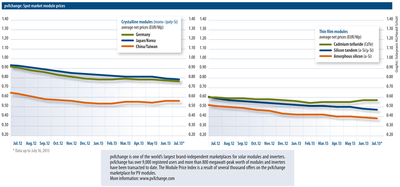
The current antidumping procedures and the resulting shortage of Chinese goods on the European market lead to a slow but continuous convergence of prices. Compared to the previous month with an average price difference of 44.4% between modules from Germany (representative of Europe) and China, the difference now amounts to approximately 37.5%. Thus, on the spot market German modules are only about one third more expensive than Chinese modules.
However, it is becoming more and more difficult to compile a representative price survey that takes different cell types into account. On the one hand, there are just a few different technologies left on the market. On the other hand, larger remnants from bankruptcies or clearances are emerging on the spot market. They can set a single price point, but they can also greatly distort the overall picture. For cadmium telluride modules, for example, First Solar is the only important provider, but the company installs their modules as much as possible in their own projects. The only products that are freely available on the market are mainly remnants from former distributors. Additionally available are goods from insolvencies of failed First Solar competitors, which can be sold at very low prices due to missing guarantees and return facilities. Another example is modules from German production: who knows which current module type will still be available in the future? There is not much to buy right now, except closeouts and insolvency goods. At least the buyers get high quality products for their money and (hopefully) won’t have to deal with the event of a complaint.
When it comes to crystalline modules from China we currently have to specify two very different prices, for duty paid goods and for undeclared goods. Since the difference seems to be consistently about 12%, we only list duty paid goods in the price index. An end to this “dual system” with all its consequences is not in sight. Although China is increasing the pressure by continuously opening new antidumping investigations, for example regarding European wine, steel and chemicals, the EU has not buckled so far. Accordingly, a further gradual increase in prices can be expected. Right now it is also almost impossible to get a binding quote from a manufacturer for deliveries in September or October. Long-term was yesterday, flexibility and decisiveness is the need of the hour to snag some of the last few inexpensive modules in the market.
Author: Martin Schachinger, pvXchange GmbH
July 2013: Chinese manufacturers respond to European antidumping tariffs
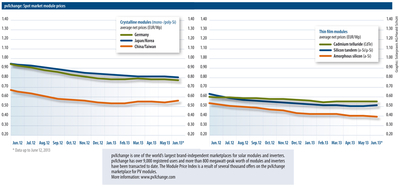
Graphic: Solarpraxis AG/Harald Schütt
Whether we call it calculated or an act of defiance, it is a fact that Chinese PV modules are only reluctantly finding their way to Europe at the moment. Until recently it was no problem for an investor or project developer to buy modules directly from Asian manufacturers and get them delivered on schedule, but the situation has now changed radically. Currently, hardly a manufacturer sends its containers filled with PV modules to Hamburg, Rotterdam or Antwerp without having received a supply contract first. All freely available goods that have been deposited in the past few months at least sporadically in European interim storage facilities have been sold off. Whoever currently asks for products of major Chinese manufacturers is directed to the respective distributors or system integrators. Most of them have secured larger quantities at their own risk in their warehouses. The prices have been raised according to the risk premium and the new Customs Tariff. At the moment new orders for Chinese tier-1/tier-2 products have delivery commitments for mid to late July. But there is still a risk that due to transport problems the goods could even be delivered in August. No one can predict what sort of consequences to expect right now. The tariff surcharges of 11.8%, which the European Commission announced on June 4, are only a transitional solution for June and July. If the anticipated tariffs of around 38 to 68% come into force in August, the importation of modules into Europe may potentially ruin many buyers, meaning they will do anything to cancel the purchase contracts. Accordingly, the market is reacting cautiously to the offers. It is claimed that the behavior of Chinese suppliers is not only due to customs issues, but also to the fact that markets like Japan, North and South America and China absorb too many modules. But given the reported numbers of installations compared to the huge production capacity this seems rather implausible. It is more likely that China would like to demonstrate how dependent Europe is on their goods, especially in the solar industry. Now it is up to us to break this blockade either by entrusting our politicians to end the antidumping affair. Otherwise we will have to focus on our local manufacturers again and swallow the bitter pill of high prices. This might be acceptable if we could then expect higher quality and durability of products.
Author: Martin Schachinger, pvXchange GmbH
Read the full entry in the July edition of pv magazine.
June 2013: Antidumping tariff recommendation leads to more uncertainty in the market
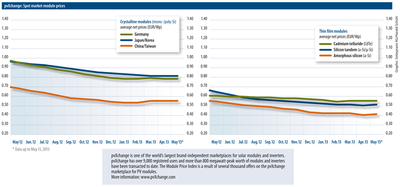
After months of speculation about antidumping tariffs on Chinese PV modules, now the cat seems to be out of the bag. In the second week of May, EU Trade Commissioner Karel De Gucht recommended to implement provisional duties ranging from 37% to 68%, or 47% on average. This surpasses the original assumptions of many market participants by far. The trend seems clear, but uncertainty is growing and new issues arise: How shall the surcharges be measured – based on the difference between the reference price and the actual selling price? What selling price should apply here – the end-user price, the installer price or the contract price for the wholesaler? And what reference price is essential – the trading price of SolarWorld modules? Shall all products be traded for a standard price in the future? And here’s one last question: How big can the chaos get? China will not put up with the announcement of antidumping tariffs and increase pressure on the European Union. The loser in this trade war will be the European PV market. Despite the efforts of the EU, the online marketplace pvXchange does not detect a decreasing demand for Chinese products but a great caution due to the currently incalculable risks: the decisiveness and thus the actual closure rate is decreasing significantly. Until now, the stakes of many manufacturers and importers were high; they offered their modules with a surcharge, calculated on the basis of moderate tariffs. However, there are more and more offers whose contractual conditions include a risk sharing model with a wording like: “Should duties NOT be introduced, the buyer receives a full refund of the surcharge. If the customs duties will exceed the calculated 6/10/12 percent, the additional costs will be shared.” Based on the now expected duty rates this could lead to a high financial burden for the buyers. Return expectations would turn into certain losses. Therefore professional financing cannot be performed and larger projects can hardly be realized. If the EU sticks to these plans, the market will come to an abrupt halt. Chinese manufacturers will withdraw and wait. And European producers might have to make do with small and micro power plants. Is that a basis for survival?
Author: Martin Schachinger, pvXchange GmbH
Read the full entry in the June edition of pv magazine.
May 2013: PV market reacting calmer than expected to EU anti-dumping investigation
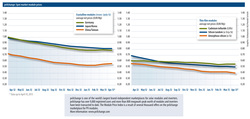
In Europe, the price increase for photovoltaic modules is not quite as strong as expected, at least until now. In particular, thin film module prices remained relatively stable, with March showing barely any movement. For crystalline modules from Japan, there was even a moderate price decline, while prices for European and Chinese modules increased slightly in this class.
The new EU regulation introduced on March 5, under which all imports of Chinese solar panels have to be registered, initially caused considerable disquiet among all market participants in Europe. The sudden onset of high demand for modules already on stock in the EU led to upwards adjusted prices, but only in the first few days. Meanwhile, solar module prices have stabilized again and even slightly decreased, so they only increased by 1 to 2%, compared to the previous month.
What are the reasons for the quick recovery from the initial shock within the industry? It is as simple as this: necessity is the mother of invention. In addition, due to the frequent ups and downs in recent years, the PV industry is somewhat hard-nosed. Flexible solutions for every situation and loopholes are found quite quickly. After the remaining stock was sold, new goods were imported from China. The associated risk is not assumed by the manufacturers , which regularly offer untaxed goods (under Incoterms rules CIF, FOB or EXW), nor the local dealers or installers.
Author: Martin Schachinger, pvXchange GmbH
Read the full entry in the May edition of pv magazine, due out on May 3.
April 2013: EU Directive on anti-dumping tariffs throws market into a jitter
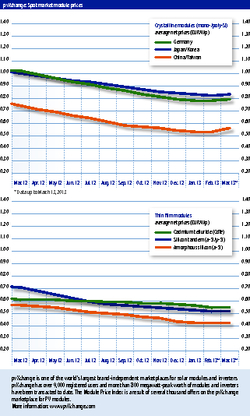
The turnaround in PV module prices that was showing last month has been confirmed. It has been accelerated by what has proven to be an unpredictable and unpleasant development for the market.
In the first week of March, the wording of an EU Directive dating from 01.03.2013 was published, according to which all imports of Chinese solar modules must be registered by the customs authorities.
The implementation of such registrations has caused jitters among European buyers. Since the amount of the punitive tariff duties is not assessable yet, no final sales price (calculation basis for all sorts of PV systems) can currently be shown. At the moment, this makes financing nearly impossible. Manufacturers from China relocate this risk by transferring the import of the modules to the buyer.
Accordingly the run on goods currently stored in the EU has been huge. During the first days after the details of the directive became known, the demand for, as well as the price of the modules, increased by as much as 10%. These stocks of Chinese goods are, however, set to drastically decline over the weeks to come. Many dealers are now buying for stock again.
What opportunities do Chinese manufacturers have for defusing this situation? The directive (if it is similar to the law applicable in the United States since 2012) concerns solar modules with crystalline wafers and cells from China. As far as possible, the affected manufacturers could equip their products with cells from Taiwan, which would result in a price increase of a few cents. Many Chinese manufacturers are already seeking out production capacity in Europe. This would lead to a price increase for end products “Made in Europe” by at least 10 Cent/Wp.
Author: Martin Schachinger, pvXchange GmbH
Read the full entry in the April edition of pv magazine, due out on April 4.
March 2013: Trend reversal for PV module prices is observable
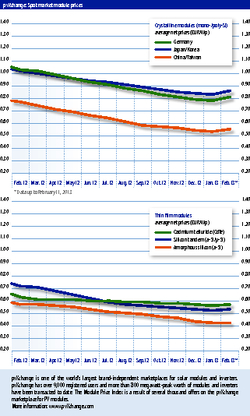
The end of photovoltaic module price declines, which became apparent within the last few months, was confirmed by recent investigations. While the average price level was still slightly decreasing at the start of 2013, compared to December 2012, a trend reversal was already visible at the end of January.
Production overcapacities are still influencing the market along the entire value chain, but stock clearances have largely been successful. It is to be expected that in February, for the first time in 24 months, module prices are not going to be lower than in the previous month. On the contrary, a minor increase is in sight, especially in higher performance classes. This particularly relates to products with crystalline cells, as well as to thin film technologies.
Immediate availability is only guaranteed for less popular module types with lower efficiency at the moment. The continuing run on higher efficiency classes with reduced production capacities inescapably leads to longer delivery periods up to several weeks. Manufacturers and suppliers take advantage of this situation and are revising their prices upward.
Another reason for the over demand is the strong Japanese market where, in particular, Japanese manufacturers are able to sell their products at – from their point of view – very attractive prices.
These products are currently missing in other markets or are at least just available at small amounts. Also the further rise in demand in China is showing an effect, in spite of the unattractive margins. The strong project business of Chinese manufacturers is leading to a shortage of popular brands and performance classes, though this might only be a temporary trend.
Author: Martin Schachinger, pvXchange GmbH
Read the full entry in the March edition of pv magazine, due out on March 1.
February 2013: No change expected
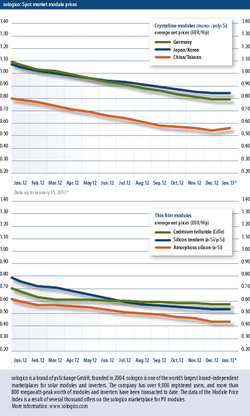
The PV industry witnessed more price declines for silicon modules and thin film technologies in December. The main reason for this is likely to be efforts of both suppliers and wholesalers to reduce stocks at the end of the year. Especially manufacturers from China are trying to reduce their general stocks in European harbors and warehouses, due to the threat of an anti-dumping tariff in Europe, which is still under discussion in Brussels and could result in heavy write-offs for stocks. High panel stocks in the U.S. hurt the balance sheets of Chinese manufacturers last year, when a tariff was introduced and led to painful write-offs.
As December is traditionally a low season for PV installations in Germany and the rest of Europe, and as there have been hardly any reasons for a rush to gain old feed-in tariffs, there have been order rebates of up to 5% for special volumes.
For January 2013, we do not expect a heavy change in current prices. Production capacities worldwide will have been reduced in general and also due to New Year holidays and the approaching Chinese New Year, thus bringing volumes much more in accordance with actual demand.
Author: Martin Schachinger, sologico AG
Read the full entry in the February edition of pv magazine, due out on February 11.
January 2013: Prices are still falling – but what will 2013 bring?
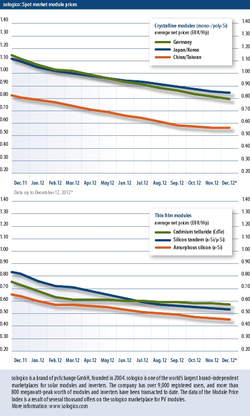
Solar module prices kept on falling from November to December. The main reason might be the effort of distributors to keep their stocks as small as possible at the end of the year.
2012 has been a turbulent year for the solar industry in general, characterized by a continuous, rapid price decline. Within the last 12 months, the prices for crystalline modules from China decreased the most (-34%), but there has been a significant drop in prices in all categories, ranging between 25% and 34%.
There are many reasons for this situation: Early in 2012 overcapacity among manufacturers of crystalline cells and modules, as well as among leading inverter manufacturers led to stocks that could not even be significantly reduced by short-term peaks in demand. Bound liquidity, lower sales volumes, higher costs and incredibly low margins increased the pressure on all producers equally.
What developments will take place in 2013 regarding the photovoltaic industry? The variety of manufacturers and products is expected to shrink further as the consolidation phase is far from complete. However, a few of the well-known brands we have heard very little of lately because of the many insolvencies last year could become more pronounced again with the help of new, mostly Asian investors.
The dispute over import and trade restrictions on Chinese modules will keep the industry on tenterhooks for a few months, but is probably not able to change much regarding the desolate situation of many European and North American manufacturers. Chinese companies have already brought themselves in a good position through acquisitions in the relevant markets.
Author: Martin Schachinger, sologico AG
Read the full entry in the January edition of pv magazine, due out on January 8.
